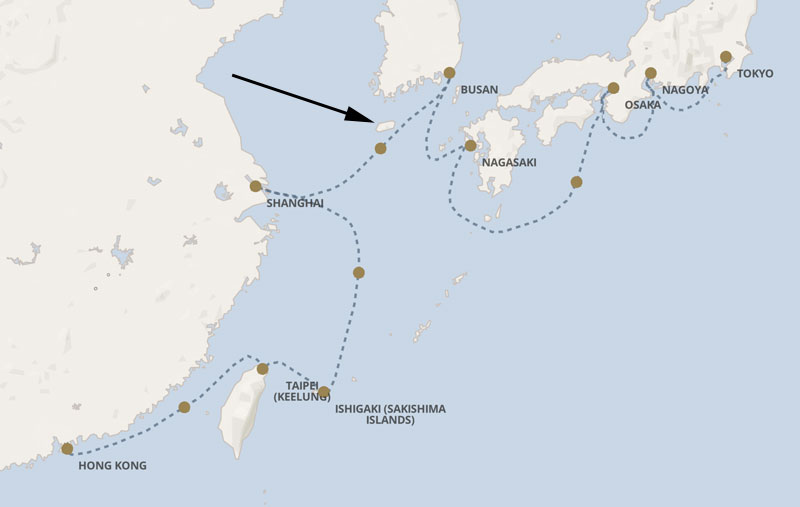
Hong Kong to Tokyo
February 14 to March 5, 2025
Mike and Judy Henderson
Judy and I have both traveled in parts of Asia earlier in our lives. Back in the early 1970's, when I served in Vietnam, I went to Bangkok and Hong Kong; in my business career I traveled to Japan and China; and Judy was part of an orchestra that played in a number of Asian cities in Japan and Taiwan, but not in mainland China. This cruise should give us exposure to some of the places we haven't been.
Note: This map is no longer exactly correct. It shows the itinerary as it was when we signed up for the cruise, but Regent has made a change to the itinerary since then. We no longer go to Busan, but now go to Gangjeong village on Jeju Island (another link here), indicated by the arrow on the map. Regent has removed the map from its website.

+++++++++++++++++++++++++++++++++++++++++++++
2/14/2025 (Thursday - my Birthday!) We signed up for a five day pre-cruise excursion to Xi'an to see the terracotta warriors, so we had to get a China visa. You can go to Hong Kong without a visa but to go into the main part of China you need a visa. Regent did a deal with Visa Central to handle the visas. Once I contacted Visa Central, I got a kit from them to use for applying for the visa.
[Note: If you want to skip my discussion of getting the China visa, click here.]
It was fairly confusing. Maybe if I had done a better job of reading everything I wouldn't have been so confused. The actual application is a form that you fill out on the China embassy website, then print out and submit with your passport, along with a passport photo, and required supporting documentation. They ask for a lot of information on that form, including the name of your father and mother, their date of birth, and where they were born. Then, your itinerary, the names and addresses of the hotels you'll be staying at, what countries you've visited in the last year, plus more stuff I can't think of right now.
One "gotcha" is that the form has to be filled out in UPPER CASE. If you use lower case, they will reject the application. Then there are questions that require supporting documentation: (1) Have you been to China before? If yes, they want a copy of your previous China visa. (2) Have you been to Turkey? If so, they want a copy of your Turkey visa and passport stamps. (3) Did you serve in the military? They want paperwork showing that you retired or were discharged.
If you were born in China or Taiwan there's a bunch more paperwork you have to submit, even if you're now an American citizen.
Here's a graphic which shows the areas you might need to provide information for. Here's a link which may get you to that graphic.
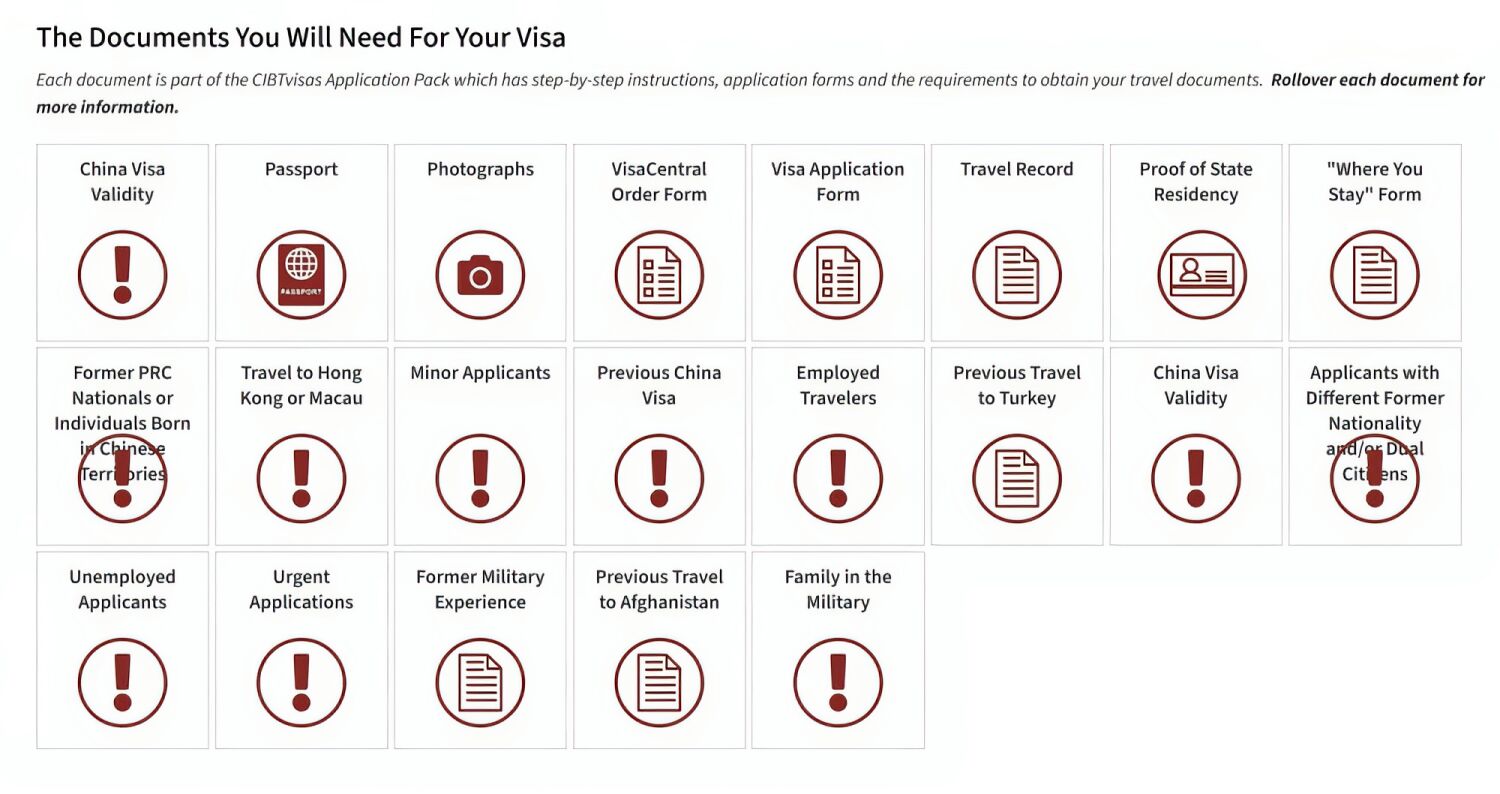
Once you figure it out, it's not too bad, but Visa Central offers help for a price. For $300/person, they will do just about everything for you, but you still have to provide the information and needed forms, and sign the documents. For $90/person, you can fill out a Visa Central form and they will fill out the China embassy form for you. For $35/person, you can send them a passport photo electronically and they will print it for your application.
We went with the basics. Visa Central charges $69/person to handle things, and the China embassy charges $140/person to process the visa. When everything was considered (such as shipping documents back and forth) the total cost for the two of us was about $500 for the visas.
Visa Central submitted our visa applications to the China embassy on November 21, 2024 and received them back on November 29th (day after Thanksgiving). The visas are good for ten years.
The net of all this means that getting a China visa is more involved than getting a visa from most countries.
[Update 12/28/2024: China recently announced that starting December 17, 2024, US tourist can spend 10 days (240 hours) in China without a visa - so we could have avoided this visa headache. But we didn't know they would announce that back when we applied for the visa. At least the visa we have is good for ten years so if we want to go back to China we won't have to get a visa again. And ten years from now it's unlikely we'll be traveling:-)]
Now, back to our trip.
+++++++++++++++++++++++++++++++++++++++++++++
We're going to be traveling west and would be just about keeping up with the sun, but we cross the International Date Line and gain a day, so we arrive on February 15th. When we return, we'll get back to the US before we left. That is, we depart at 6pm on March 5th and arrive about 1pm on March 5th, thanks to the magic of the International Date Line.
Our friend Greg will be staying at our house with the girls (our two Cavalier King Charles spaniels). He set up his computer system earlier - he'll be working from home - and arrived about 5:30am this morning. He'll take the girls to work with him and bring them back to the house later today.
Lynn and Debbie were out with us, waiting for the limo. They were in their bathrobes and took our picture. They threatened me with dire consequences if I took their picture.
The limo arrived at 7am to go to LAX. Here's our traditional before-trip picture.
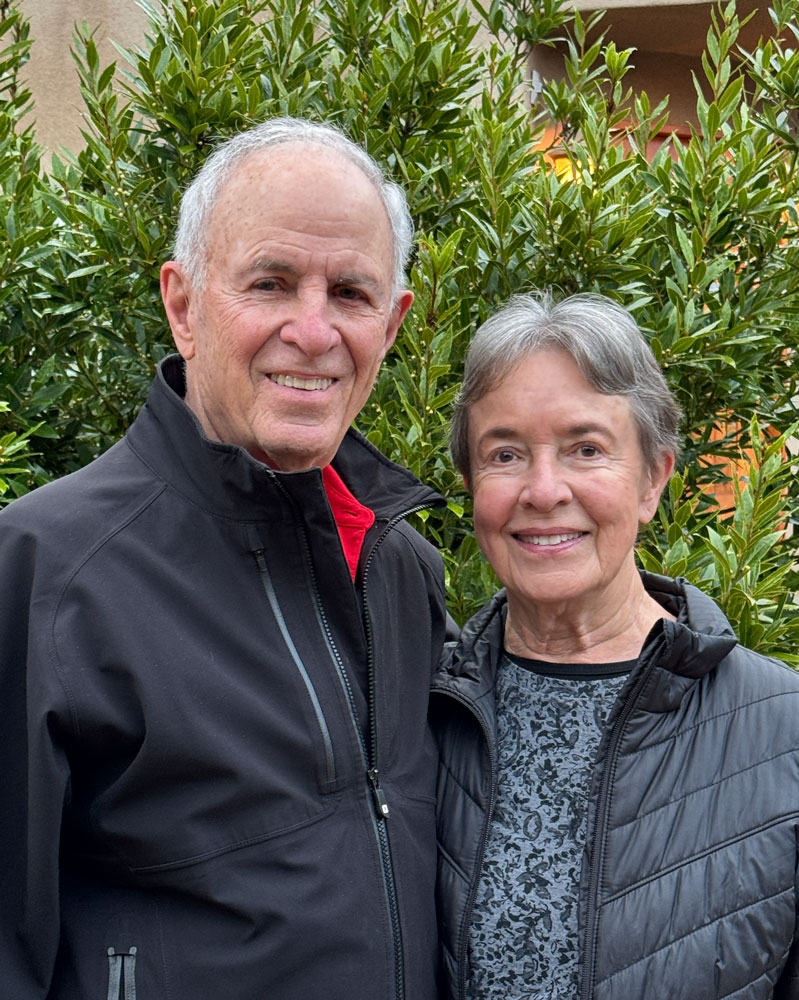
The trip to the airport was smooth, about an hour. It had been raining the last couple of days, but not this morning.
We checked in at Cathay Pacific.

The agent surprised us by asking for our Global Entry cards, which Judy had. A bit later, Judy asked him why he wanted to see the Global Entry cards and he said, "I was just stalling until we could sign the card."
Since it is my birthday, they gave me a birthday card, and a gift. The gift is a passport "wallet" and it was in a cloth bag. The card was signed by quite a number of employees. I'm sure they sign those well in advance. When the agent said they had to sign the card, I think he meant the envelope. I thought it was a nice gesture.
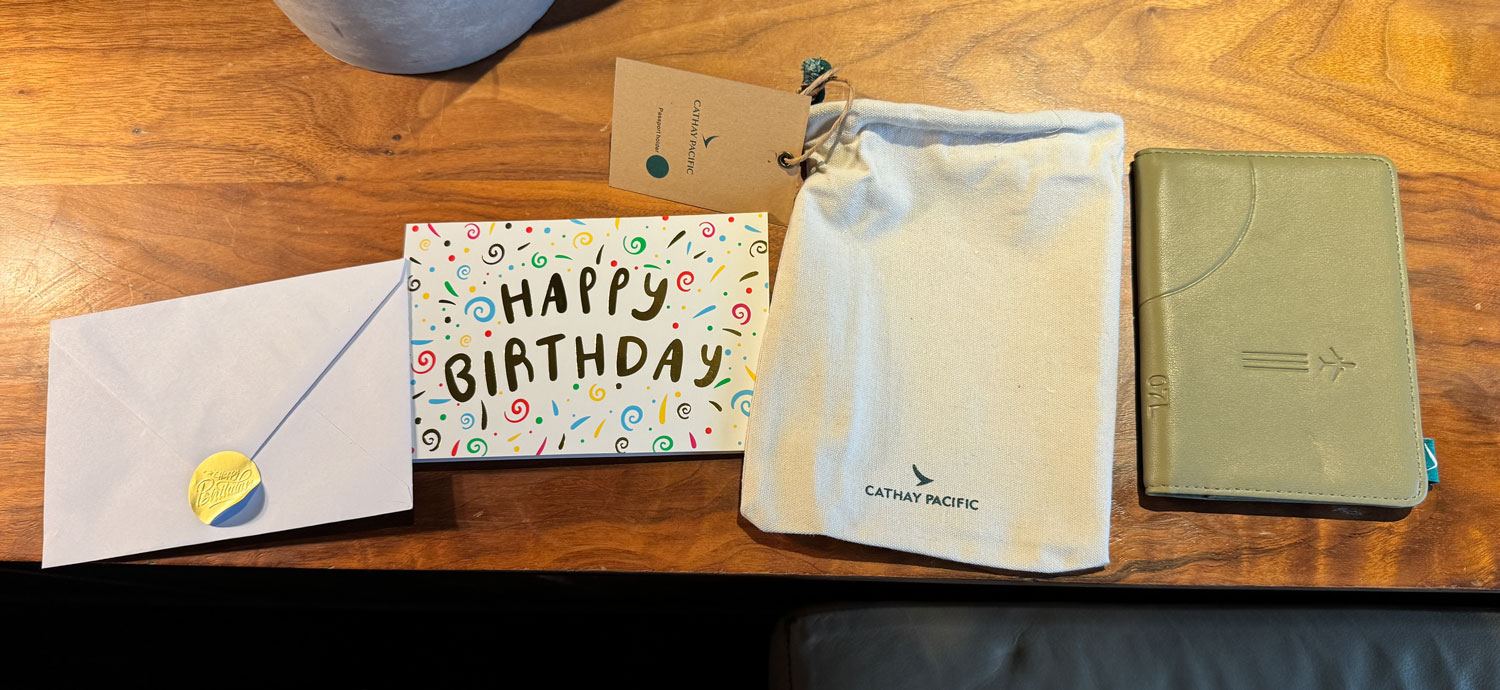
About 10am we went down to the gate and boarded - not much of a wait. The aircraft is a Boeing 777-300ER, which is a nice aircraft but getting somewhat old. The seats are nice and the staff has been busy getting lunch ready. The seat area had a lot of storage places, which I appreciated, and the "bed" was long enough. We took off about 11am.
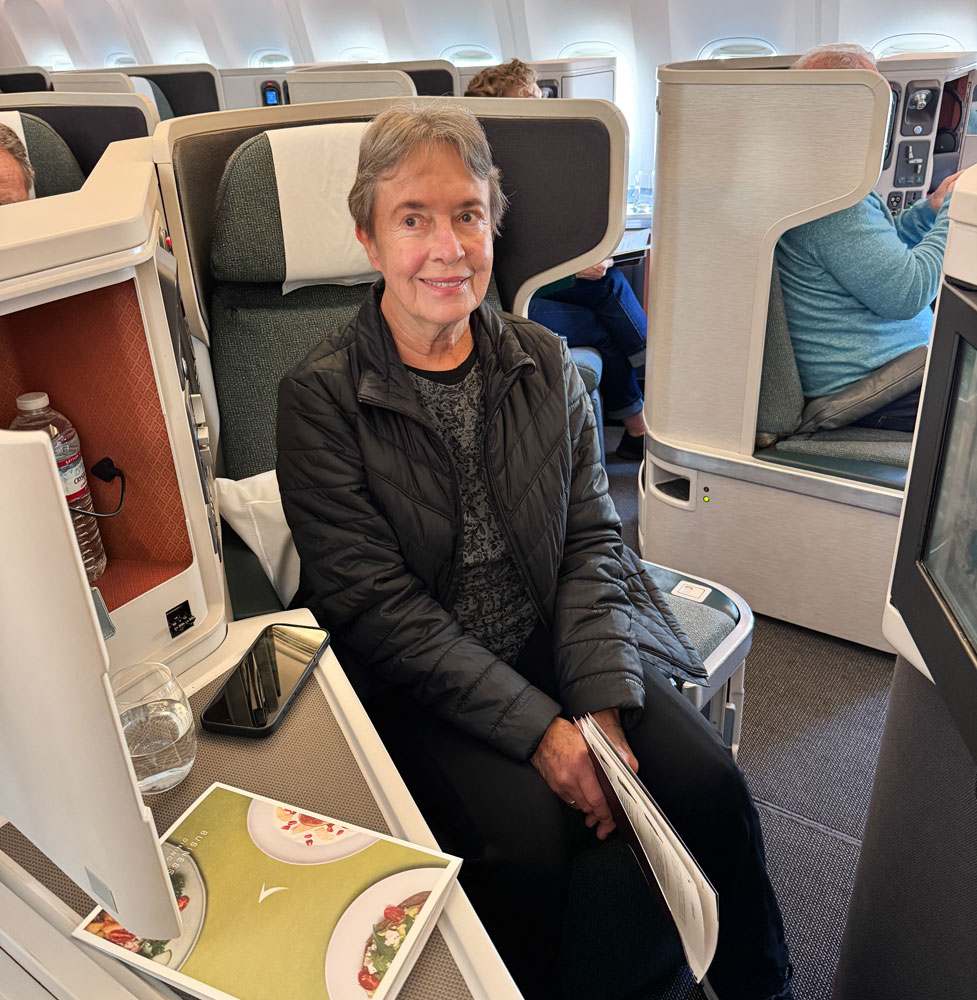
They offer free Internet access in Business class so I've been able to check email and update this blog. Nice feature.
They served us lunch and then we tried to sleep.
++++++++++++++++++++++++++++++++++++++++++++++++++
2/15/2025 (Saturday - arrive Hong Kong) The flight was 15 hours and 37 minutes - from leaving the gate at LAX to touchdown in Hong Kong. This is the new Hong Kong airport, opened in 1998. The old airport, known as Kai Tak was built out into the bay from Kowloon City. The buildings in Kowloon City in line with the airport runway were limited in height so that the airplanes, such as the Boeing 747, could descend to the runway. I remember being in a 747 and looking out the window directly into windows of tall buildings lining the approach area.
We touched down at HKG about 7pm but had a long drive to the gate. Passport control was quick and our baggage arrived in good time. We went out and met our Regent greeter.
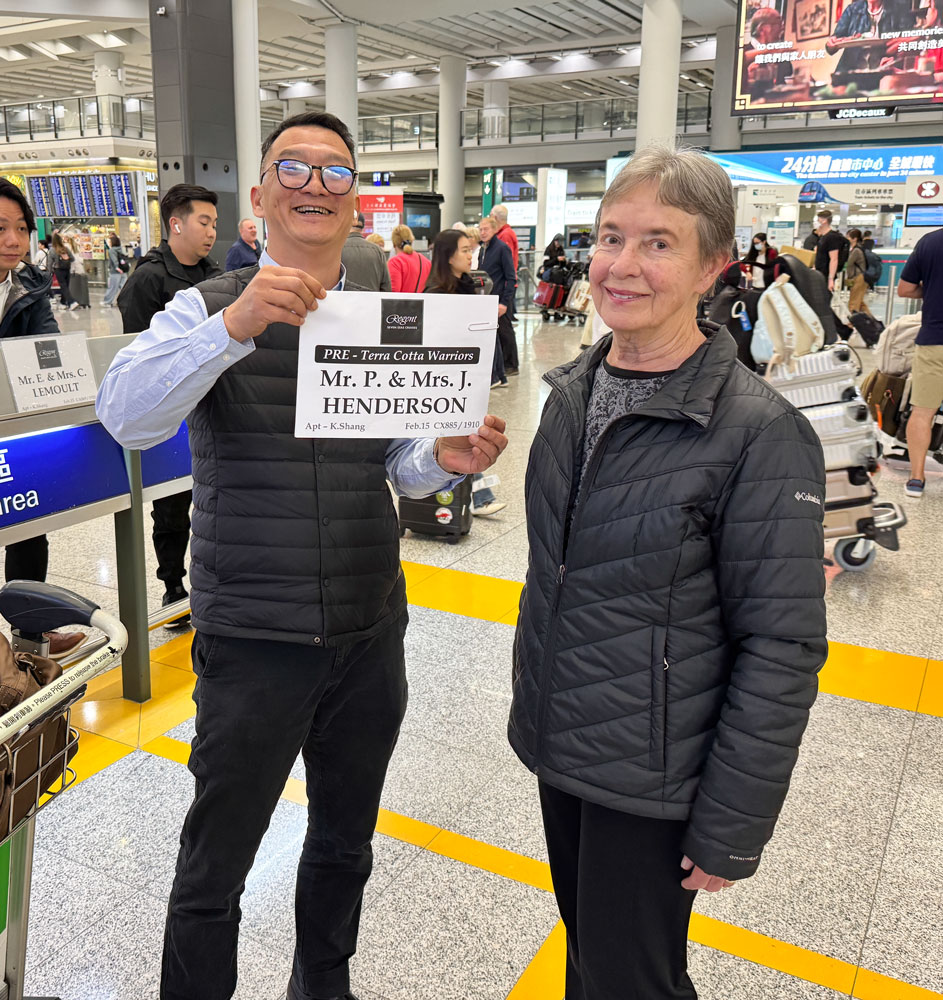
It was about 8pm when we got in the car, and it was perhaps a 30 minute drive to the Shangri-La Hotel in Kowloon. Hong Kong was a British colony for many years, until 1999, and Britain left them driving on the wrong side of the road, and with that huge British power plug. The rest of China drives on the right side of the road amd uses a smaller power plug. The Lótus Bridge between Kowloon and Macau allows vehicles to switch sides of the road.
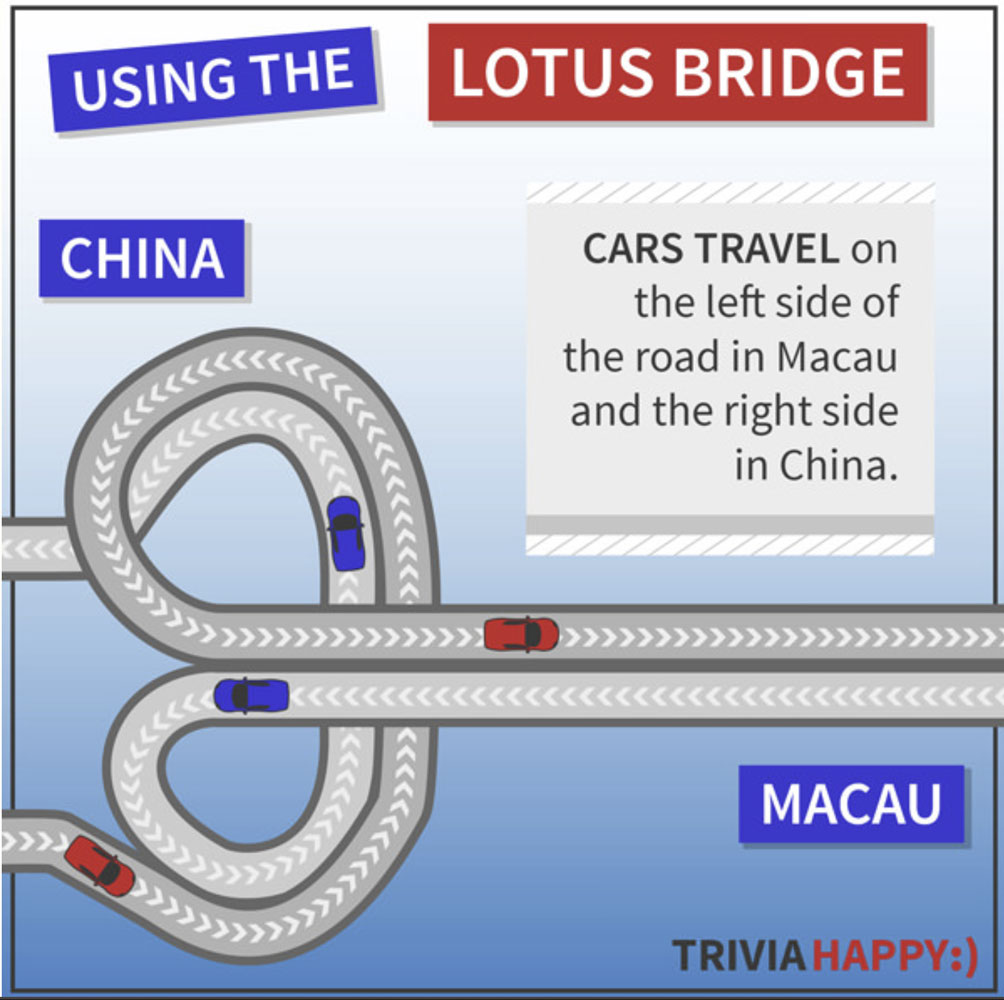
Here's a website about the problem.
By the time we got checked in and to our room it as 9pm. It's a nice room, but we'll only be in it for tonight. We arrived fairly late and will leave early tomorrow morning so we won't see much of Hong Kong.
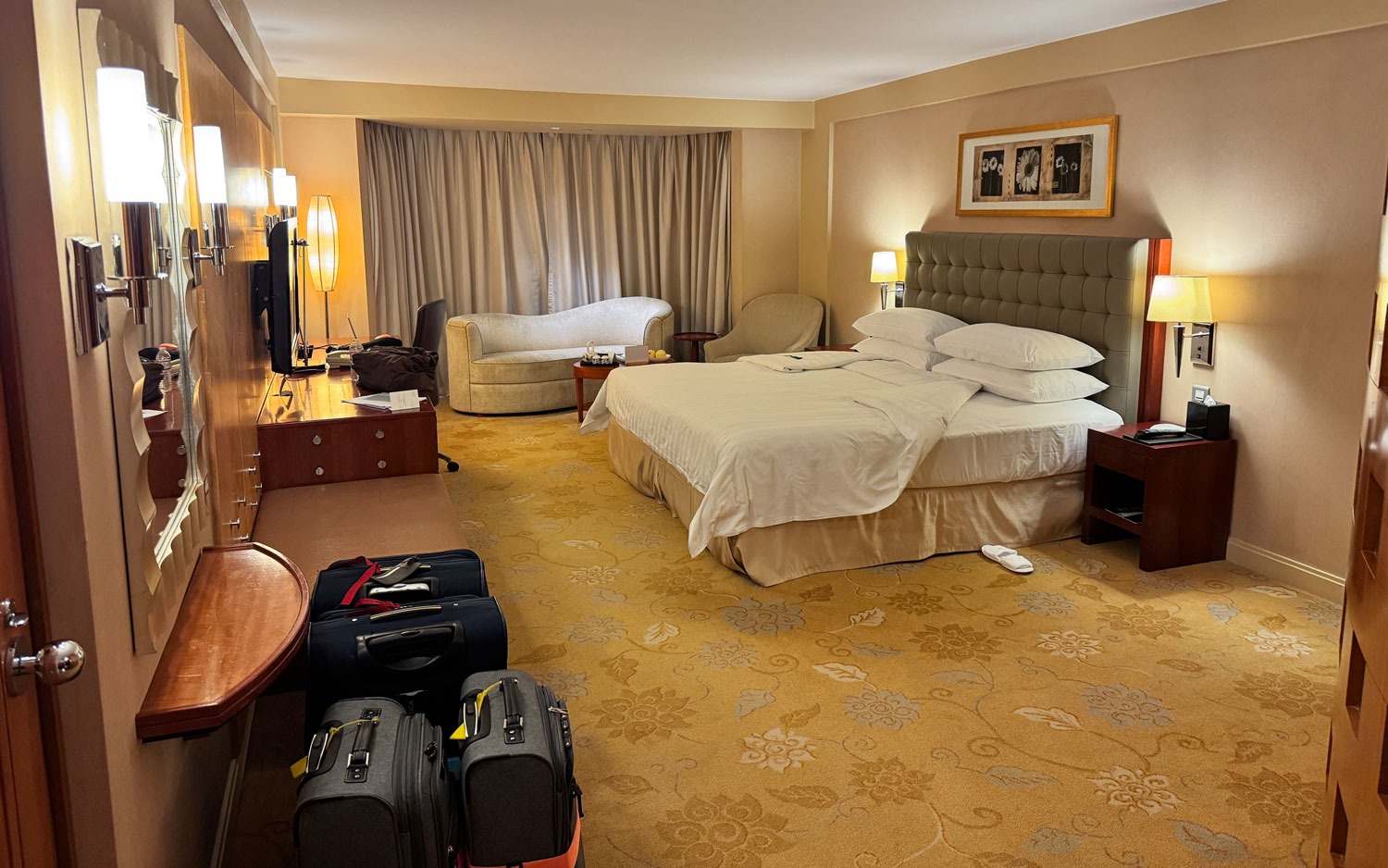
This is just interesting - nothing to do with our trip. Kowloon had a neighborhood that was extremely dense, poor, and lawless - known as the Kowloon Walled City. It was finally demolished in 1993-1994.
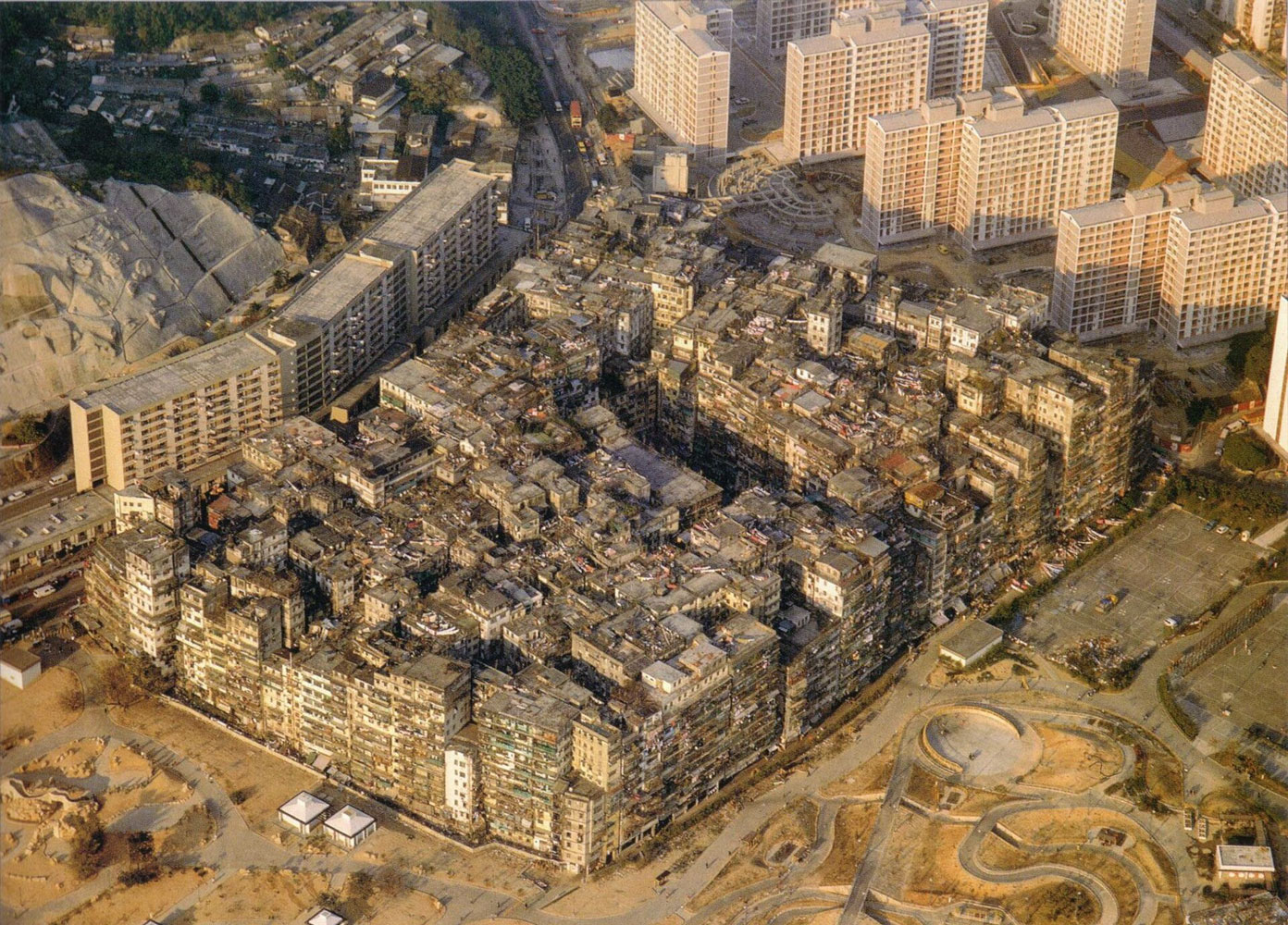
We went to bed as soon as we could get all our luggage arranged for a 7am bag pickup. I slept until 4:30am.
++++++++++++++++++++++++++++++++++++++++++++++++++
2/16/2025 (Sunday) We fly to Xi'an today. Our checked bags will stay at the hotel and we'll only take our carry-on bags. Our checked bags were out in the hallway before we left for breakfast. We meet the Regent guide at 7:30 this morning.
Breakfast was at 6:30am and they had a very nice spread. I like Chinese food so I choose mostly Chinese dishes.
At 7:30 we met the Regent guide, Ivy. She'll be with us until we get back to Hong Kong and board the ship.
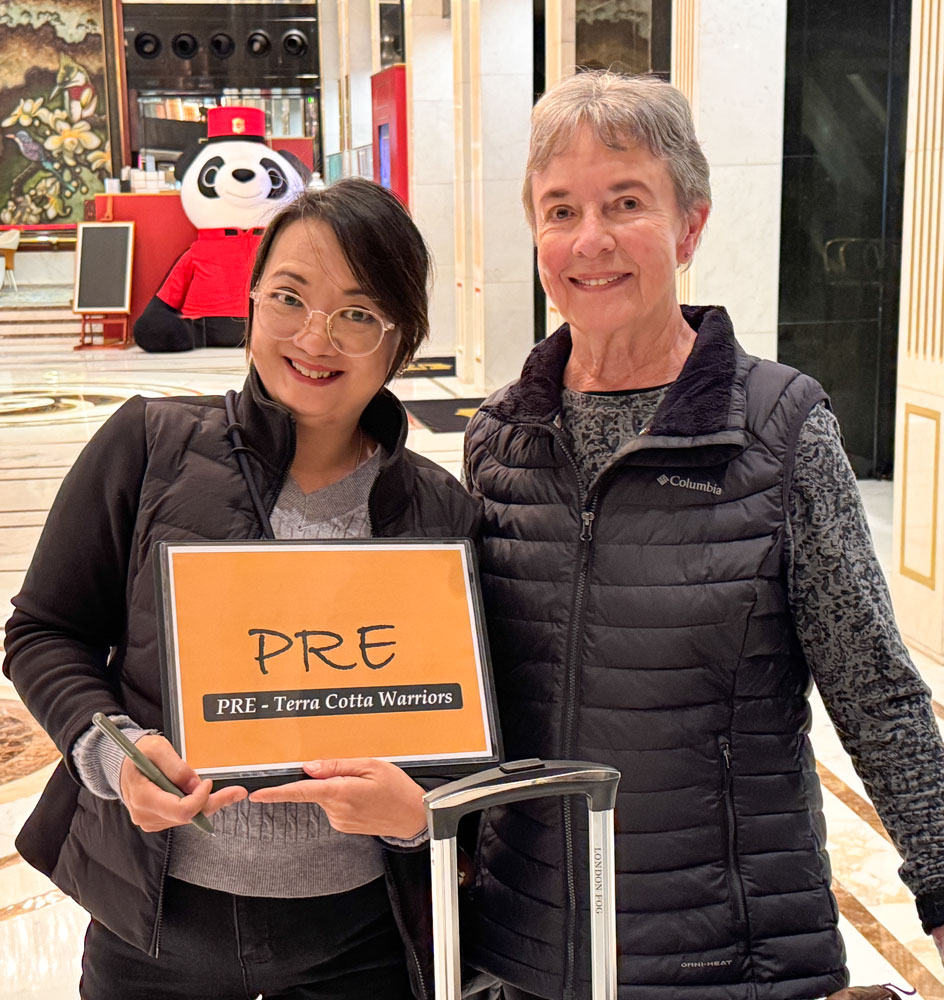
There are ten people on this pre-cruise excursion. We boarded a bus to the airport.
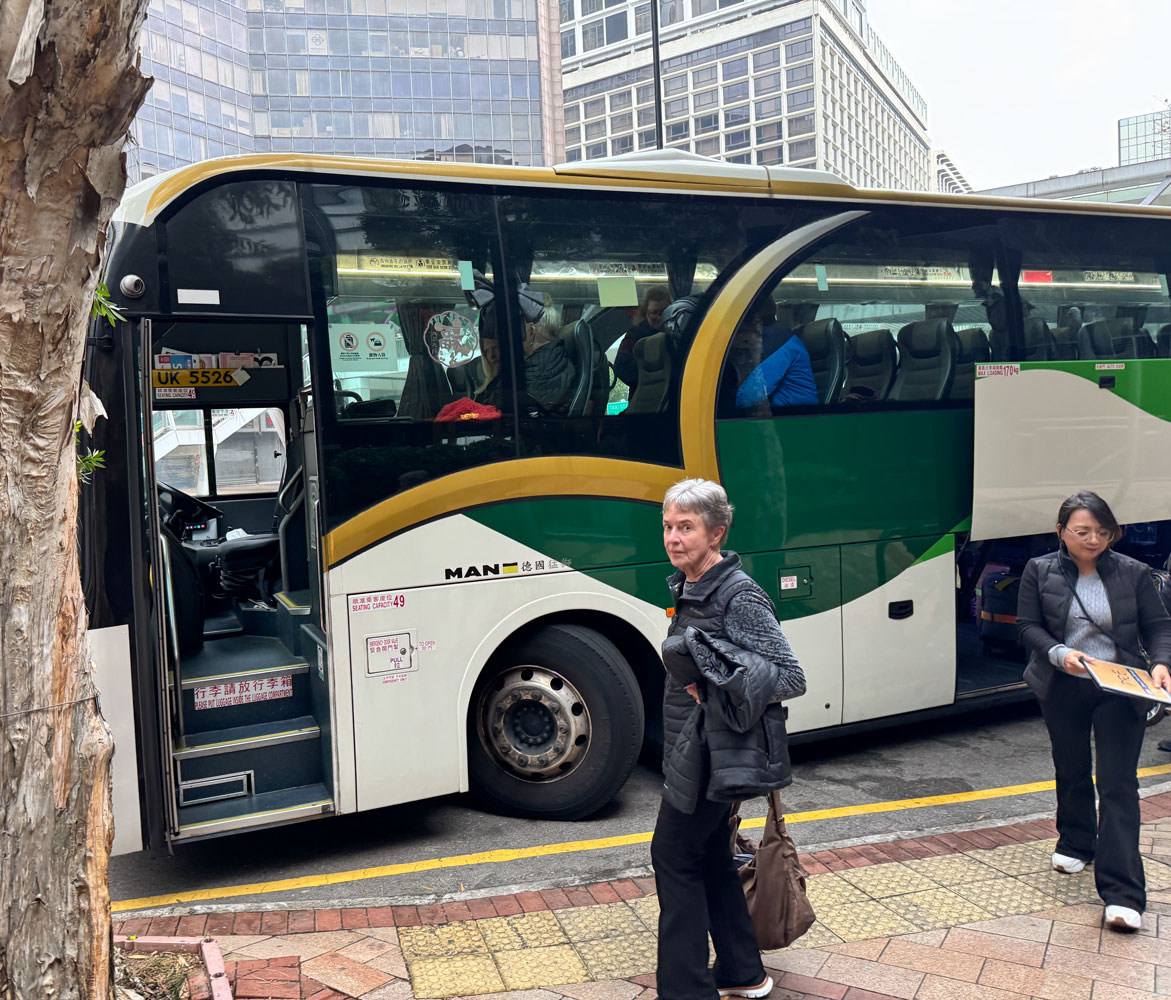
It was about a 20 minute trip back to the Hong Kong airport. Ivy had everything organized and we were able to check in and go through security and passport control quickly. The security check was not difficult, especially compared to what we had experienced in India.
Ivy recommended that we check our carry-ons to avoid the problem of finding overhead space, and we did so. While I was getting our luggage tags, an airport employee came up to me and asked me if I wanted him to "verify" us, and I told him "yes". He examined our passports and visas, and then using a tablet he had, and his badge, he verified that we were who we said we were. This helped speed us through Immigration Control when we arrived at Xi'an.
We waited in the gate area until about 10:15, when we boarded a Cathay Pacific Airbus A321neo, 3-across in economy. To board, they used face-ID, so we didn't even have to show our boarding passes. Just stand in front of the camera. The flight to Xi'an is about three hours, and I was stuck in a very tight middle seat for the flight.
I could track the flight on the display on the seatback and they sure flew a strange route.

This map may be a bit confusing compared to the way we normally view maps. North is to the left - Xi'an is just a bit east of due north of Hong Kong, about 900 miles. I turned the map to get the route to fit on the screen.
Here's a map of this part of China with north at the top of the screen.

Why they didn't fly directly to Xi'an is beyond me.
The cabin crew served us lunch on the plane and we arrived at 2:20pm, a bit over three hours flying time.
As we were approaching Xi'an, Judy, who was sitting at the window, started noticing squares on the ground. When we got lower, she realized that the squares were buildings seen from directly above.
Here's a picture of some high rise residential buildings as we descended. This is just a small number of the buildings we saw as we approached Xi'an. It's hard to describe how many of these clusters of buildings we saw as we flew towards the airport.
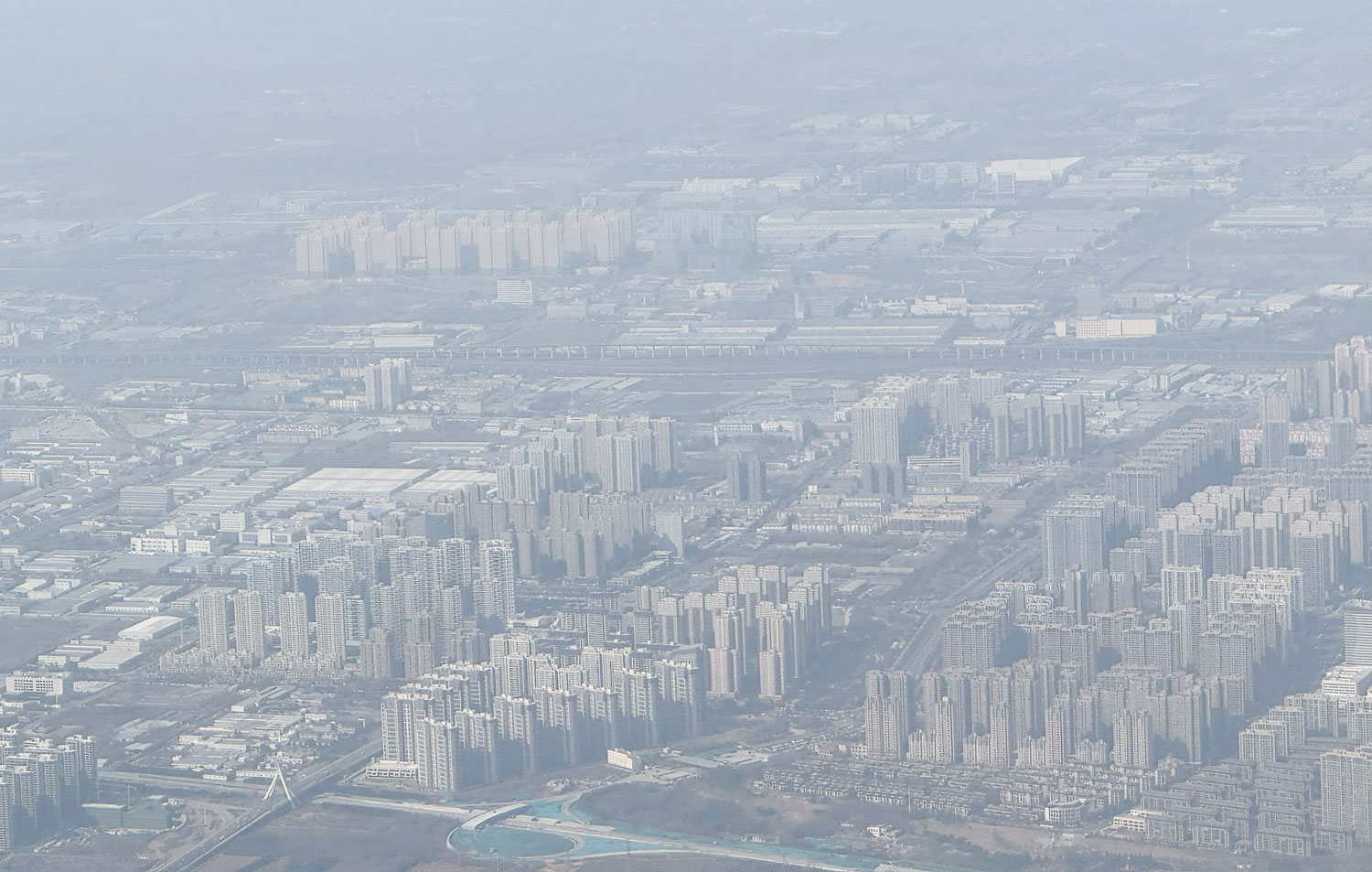
China is in the middle of a real estate bubble and high-rise housing is way over-built. I'll write more about that later.
Xi'an is quite a bit cooler than Hong Kong, it was about 13°C (about 55°F) when we landed, and that was in the middle of the day. At night it's in the mid 30's, according to my weather app.
We enter China, proper, at Xi'an. Hong Kong and Macau are Special Administrative Regions (SAR) and have different laws than China. When you're in Hong Kong, you are not recognized as being in China, so a trip between Hong Kong and a city in China is considered entering China and requires a China visa (which we have).
We went through China passport control, which was fast, and picked up our luggage. As we exited baggage claim we met our local tour guide, also named Ivy. Now, neither Ivy-1 or Ivy-2 are named "Ivy". That's just the name they use for English speaking tourists because the tourists may not be able to pronounce and remember their real names.
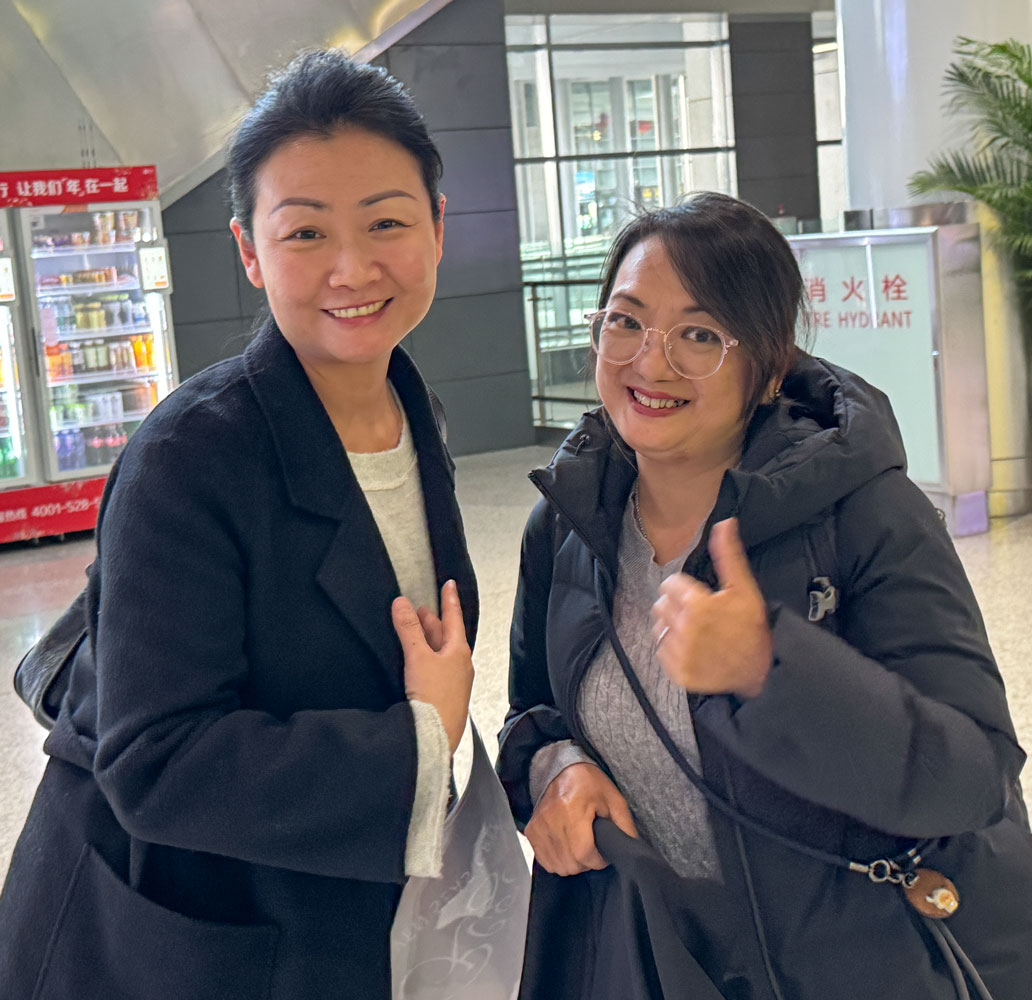
We boarded a smaller bus, and Ivy-2 took us to the Great Mosque of Xi'an. To me, it's not all that interesting, but they had to do something in the afternoon. We won't go to see the Terracotta Warriors until tomorrow.
There were limitations on where the bus could drop us off, so we're going to have to walk some distance to the mosque. But right in the area where we were dropped off, these three children were dressed in traditional clothing, being photographed by their parents. The little boy in the center doesn't look like this is his favorite activity.
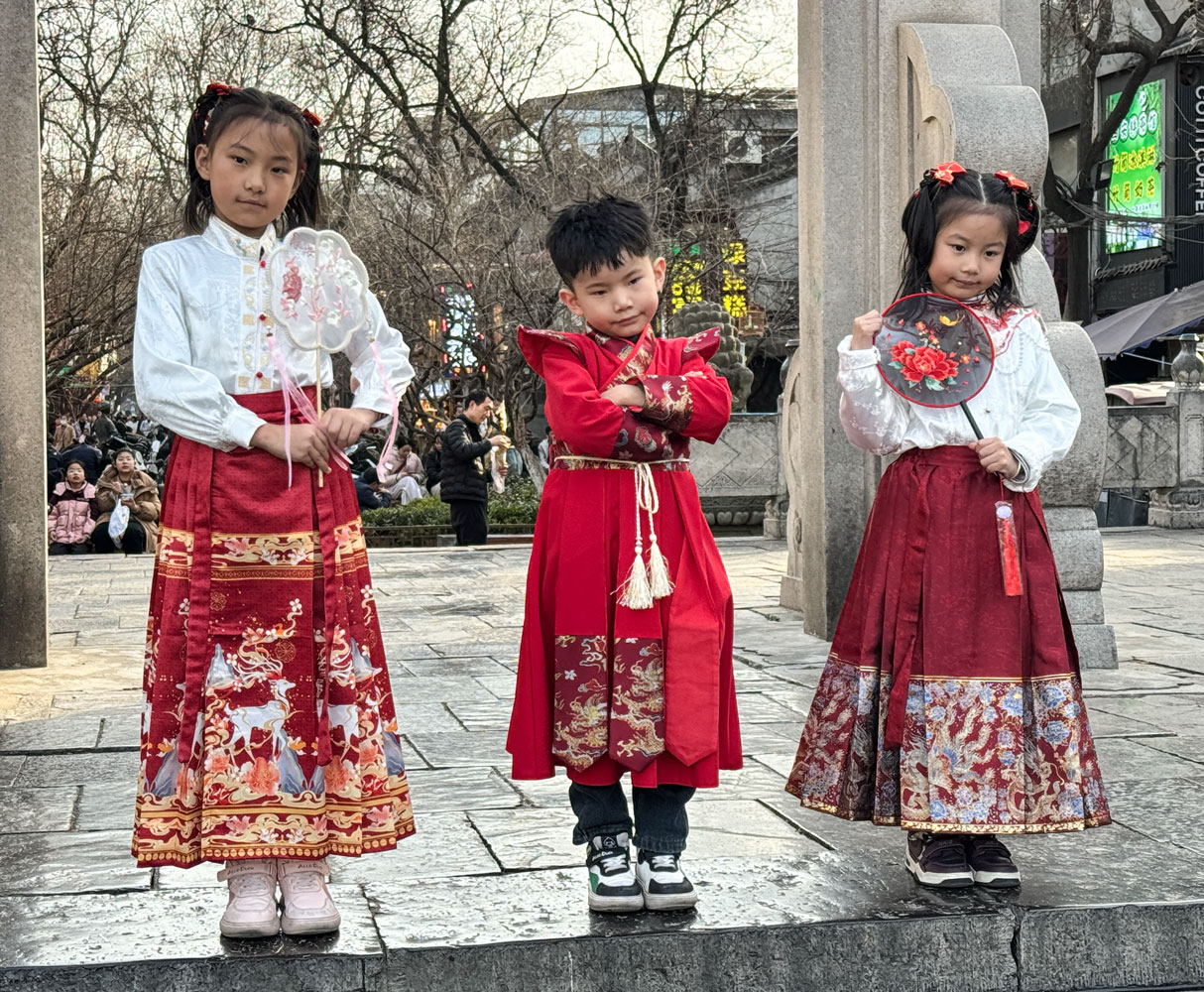
Later, we saw many people, mostly women, in traditional dress, being photographed. I'll have some pictures of them later.
We walked down a pedestrian street that had food stalls on both sides.
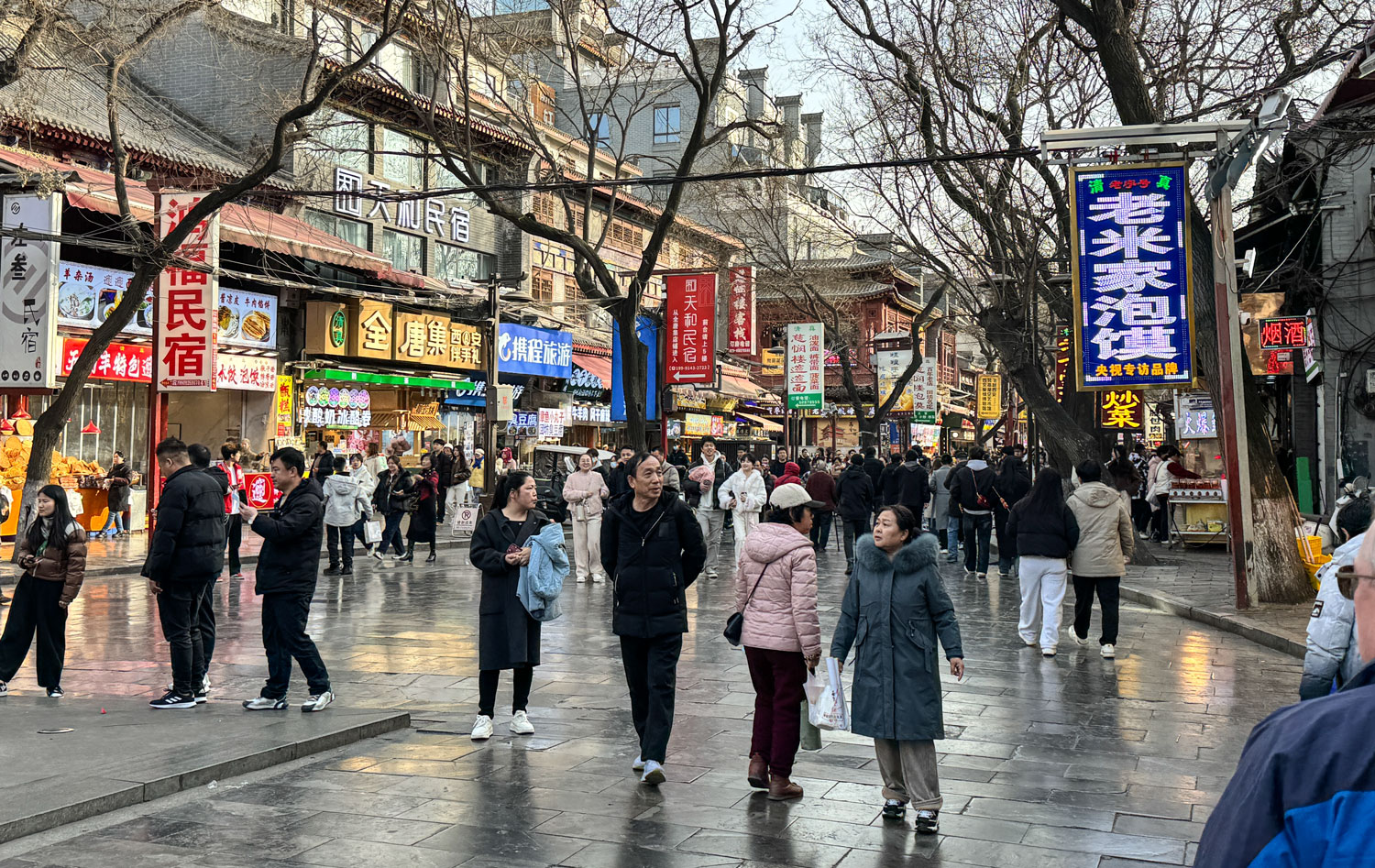
Here's a look along one side of the street.

And a closer look at one of the stalls. I don't know what all the food is, but the yellow stuff on the right side of the picture is potato chips on a stick. I would have liked to try some of that "street food", but Ivy warned us of possible gastric problems caused by our not being accustomed to it.

Eventually we entered an alley.

This walk proved to be an experience in itself, with lots of people and more small businesses and food stalls, before we came to the mosque.
You may ask, "Muslims in China? Where did they come from?" Trade between China and the rest of the world goes back thousands of years. One of the most famous trade routes was the Silk Road which stretched back to the Middle East. Note that Islam originated in Mecca in 610 AD.
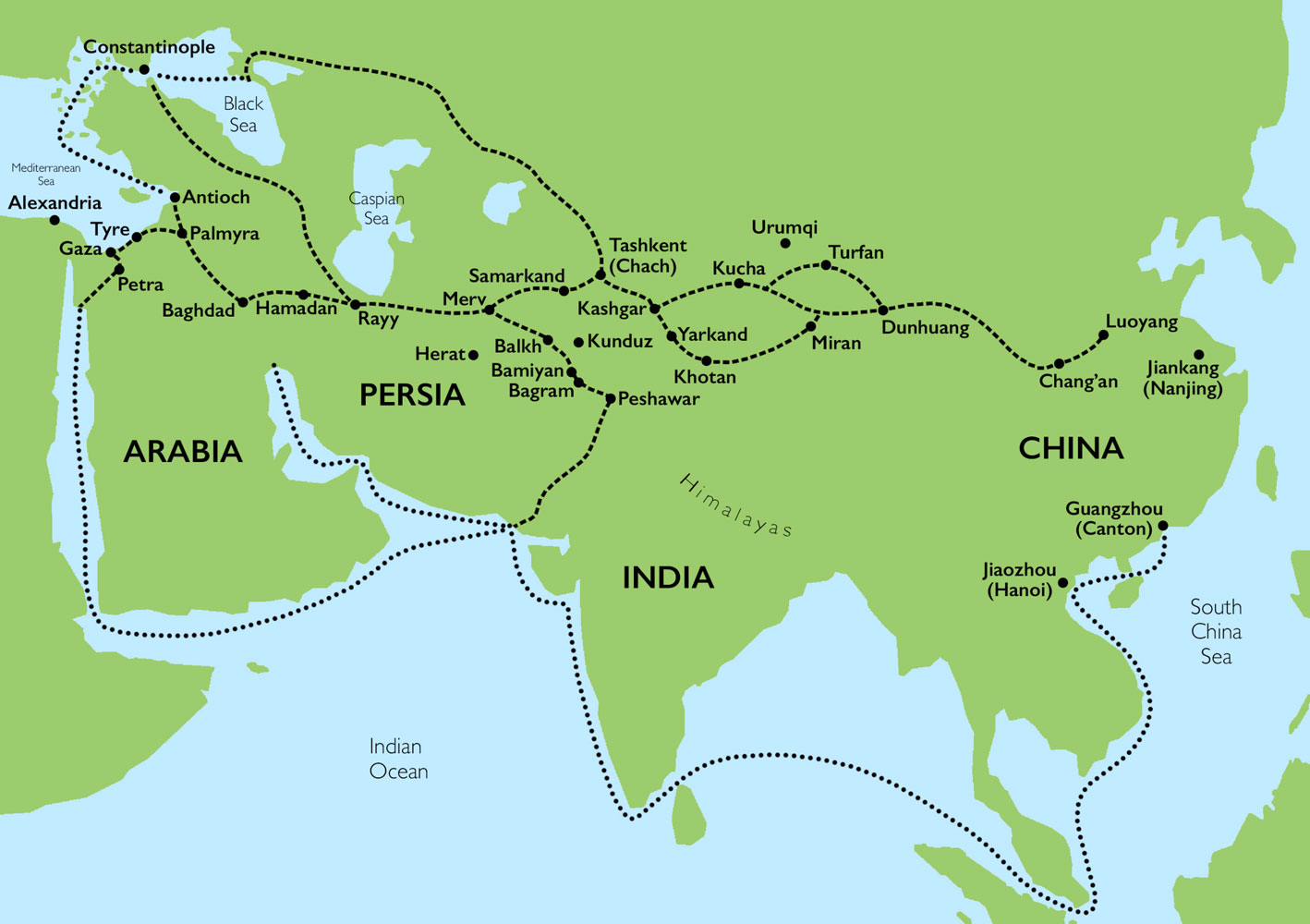
Traders from the Middle East probably came to China to trade and stayed. But the Muslim population of China is small, about 1.5%, or 20 million people.
In Xi'an, only about 0.5% of the population is Muslim, about 65,000 people (Xi'an's population in 2020 was about 13 million).
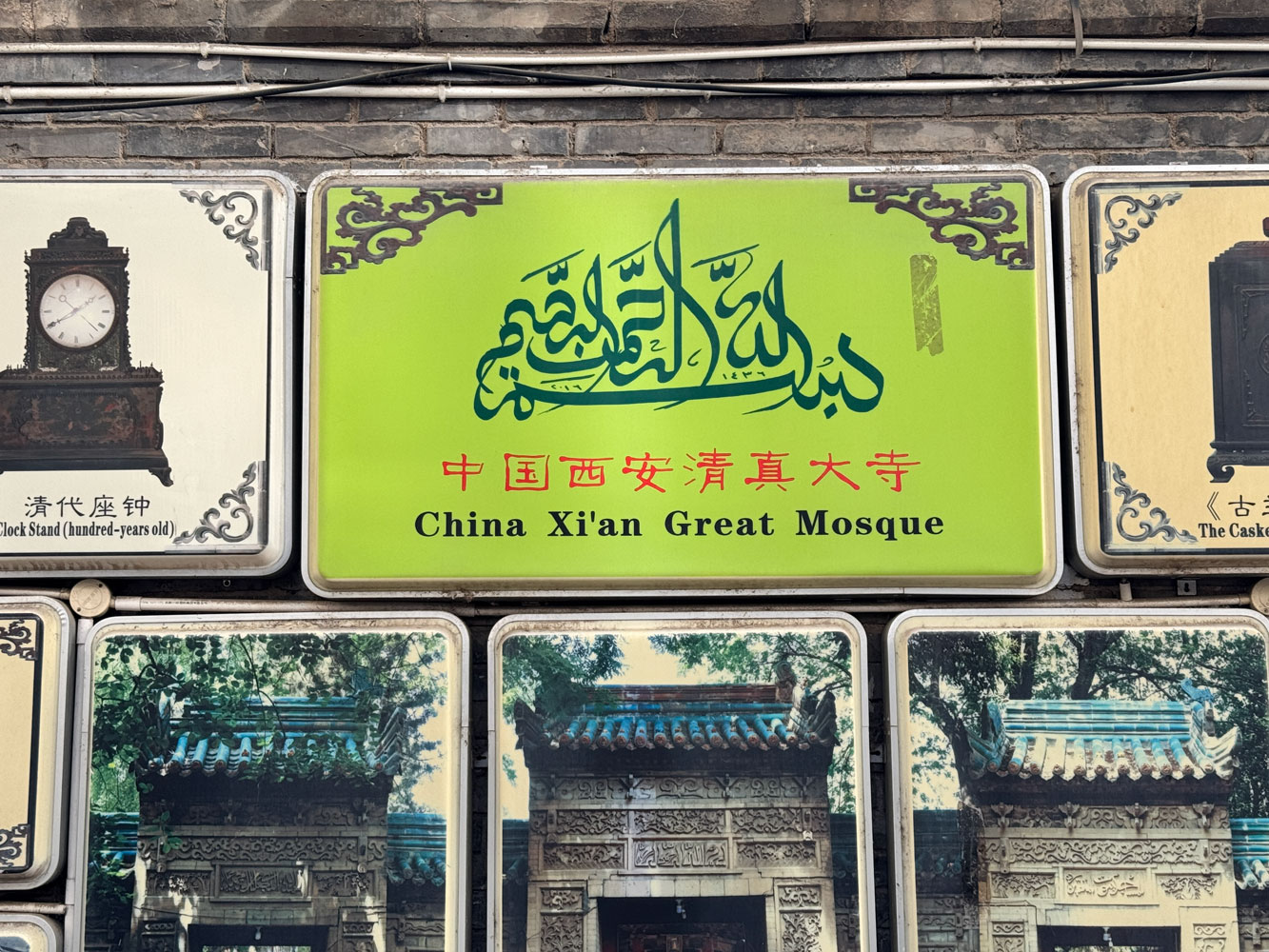
Just inside the entrance to the mosque courtyard, there was a small store selling kufi hats. The interesting thing about this picture is that their mirror caught Judy's reflection just as I took it. All by chance.

The main gate into the mosque grounds.
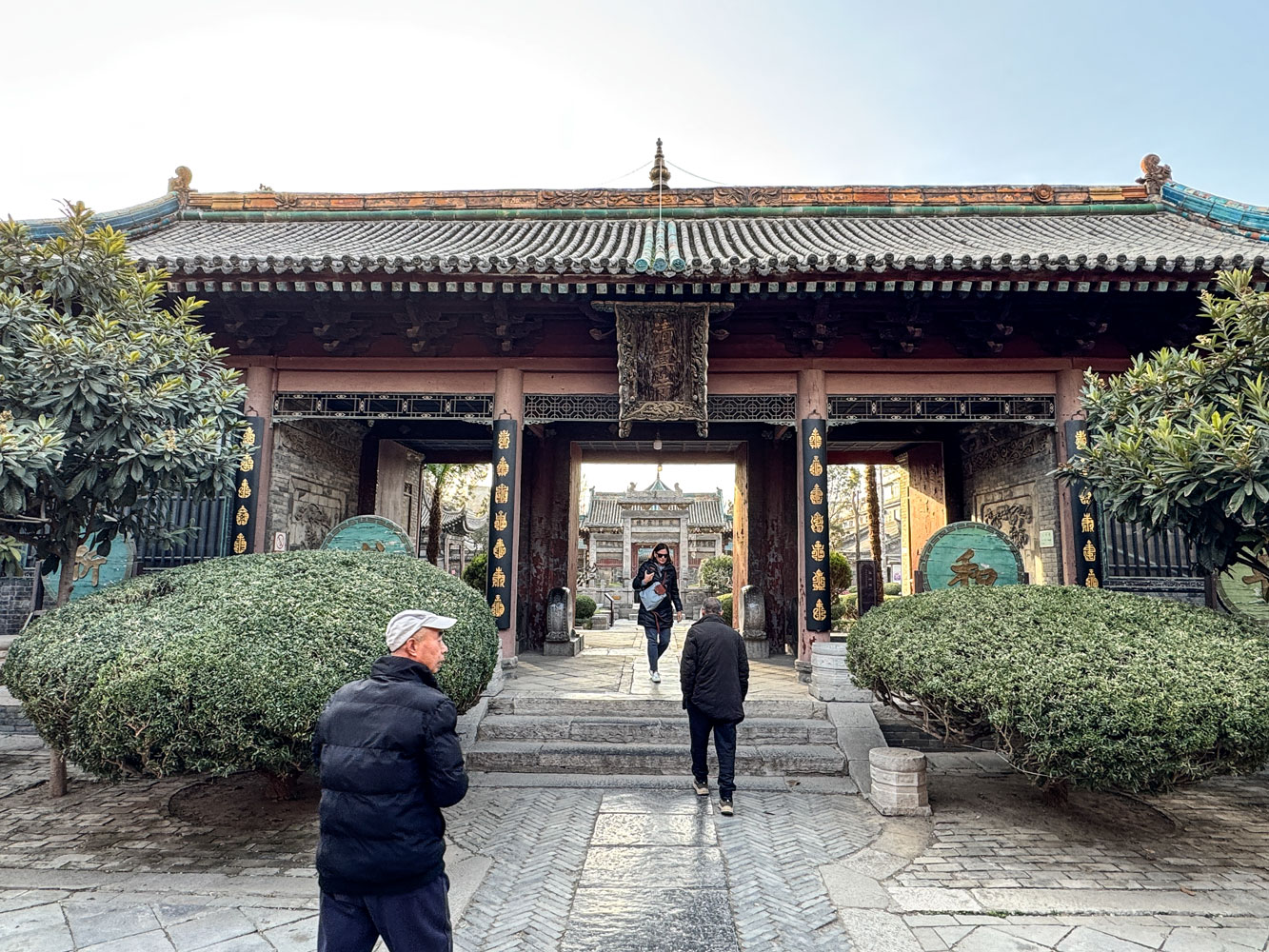
A building on the mosque grounds.

When I moved to California in 1996, I used to go to an "Islamic Chinese" restaurant. Good food, but they didn't serve any pork. I always thought "Islamic Chinese" was strange - but now I understand. [Note by Judy: I used to go to that restaurant, also.]
After passing through the main gate, this was our view of the courtyard.
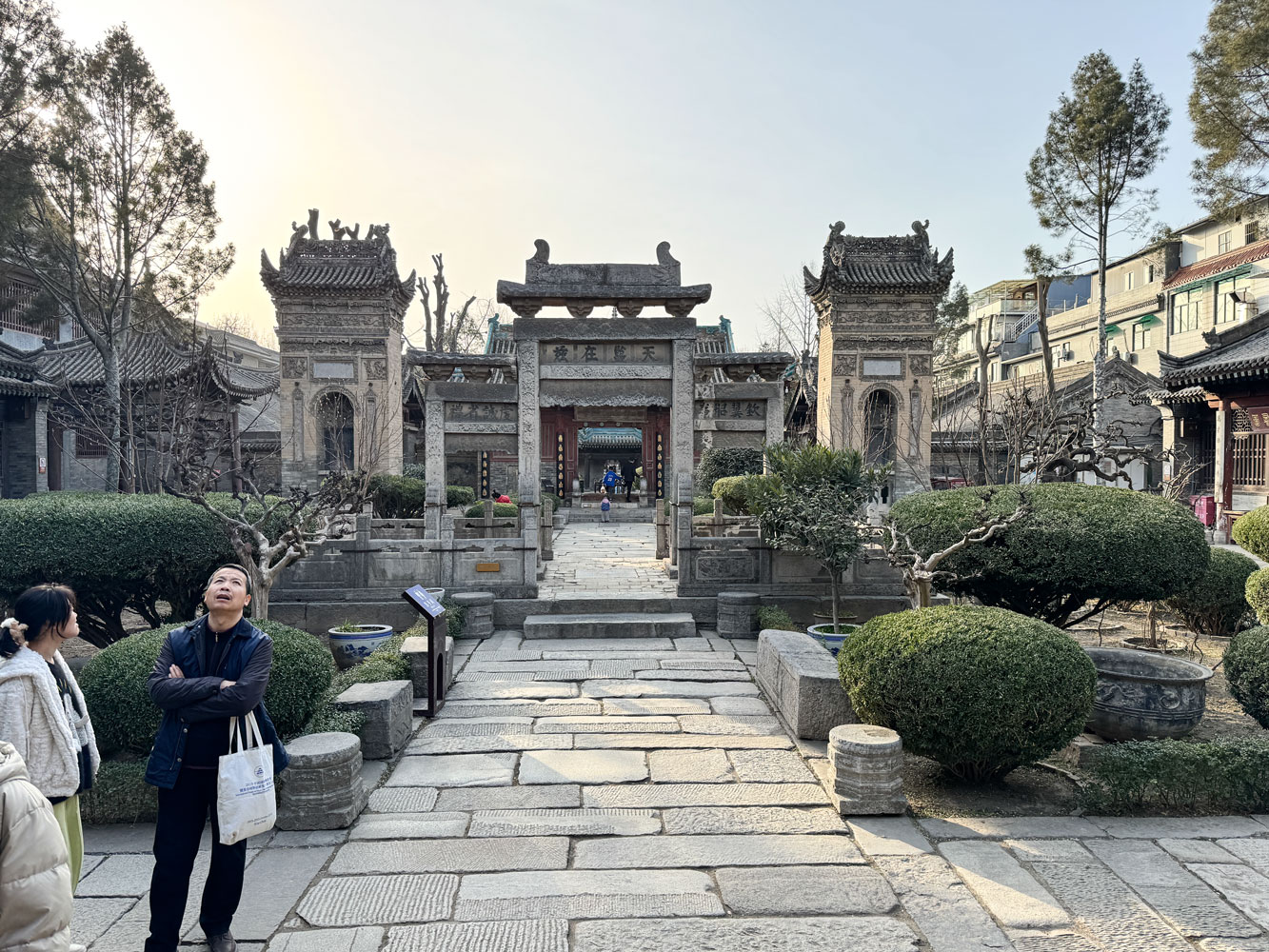
Another gate further down the courtyard.
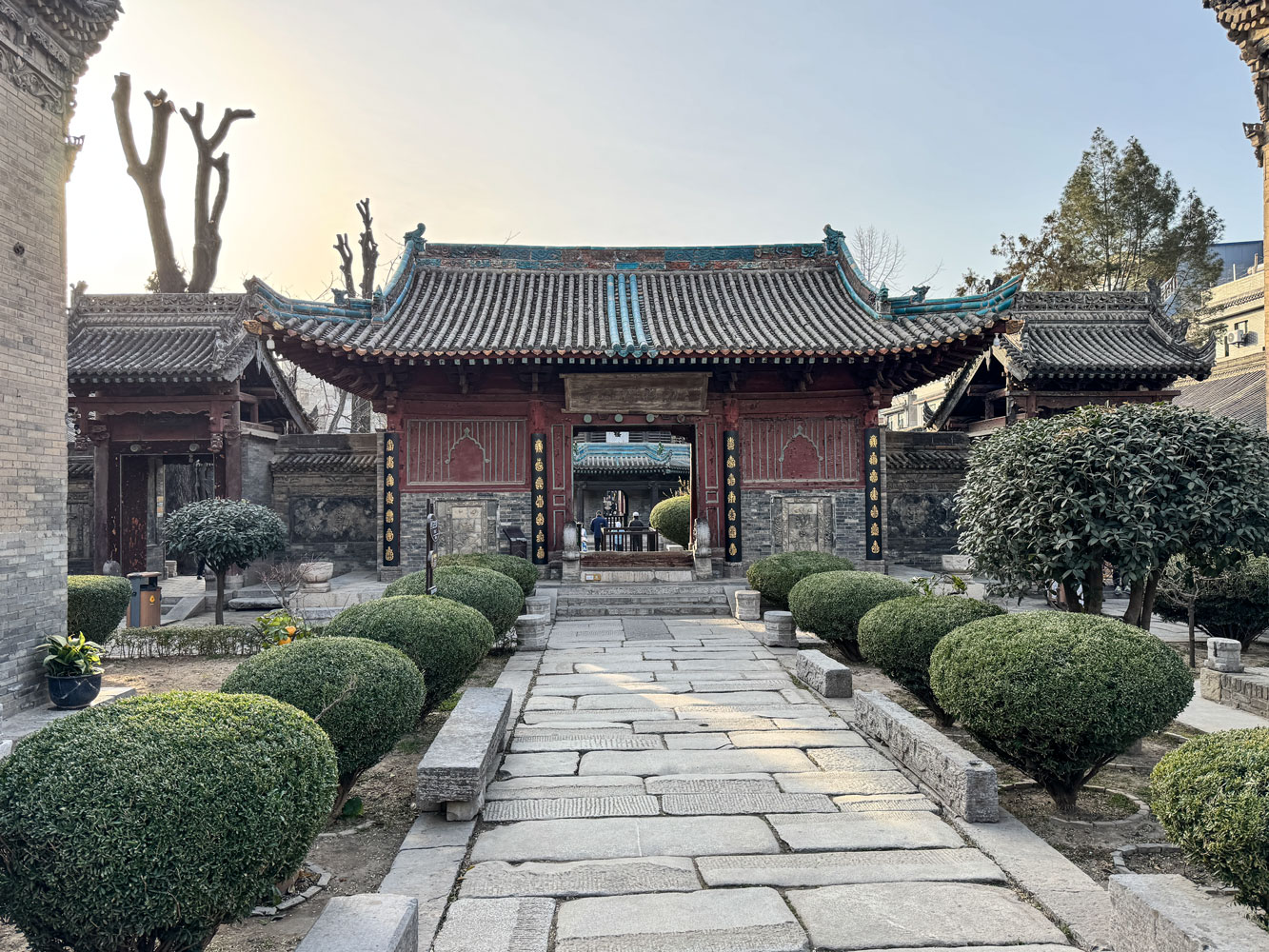
A view through that second gate.

The pagoda-like structure partially seen in the above picture. Note the young woman sitting on the steps of the pagoda.
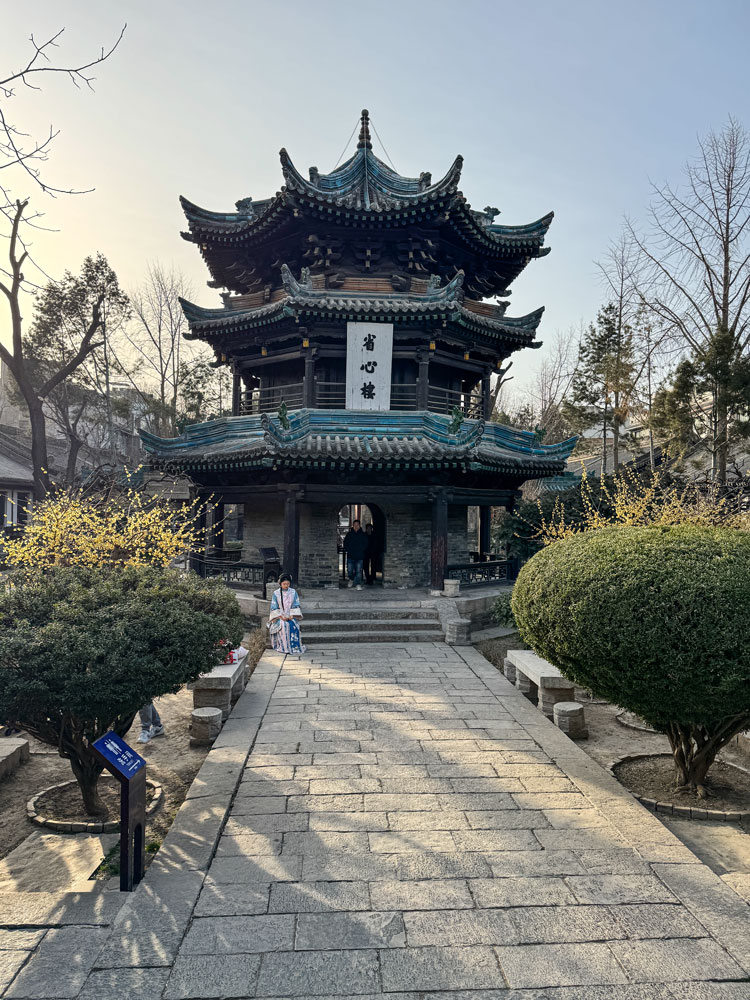
She's one of the women we saw in traditional dress.

After a bit more walking we came to the grand mosque.

We were not allowed into the mosque so we just walked up to it and looked around. Soon we began walking back to the entrance. This is the view down the center of the courtyard, as seen from the grand mosque platform.

When we got back to the main entrance gate, we found this couple in traditional dress being photographed.
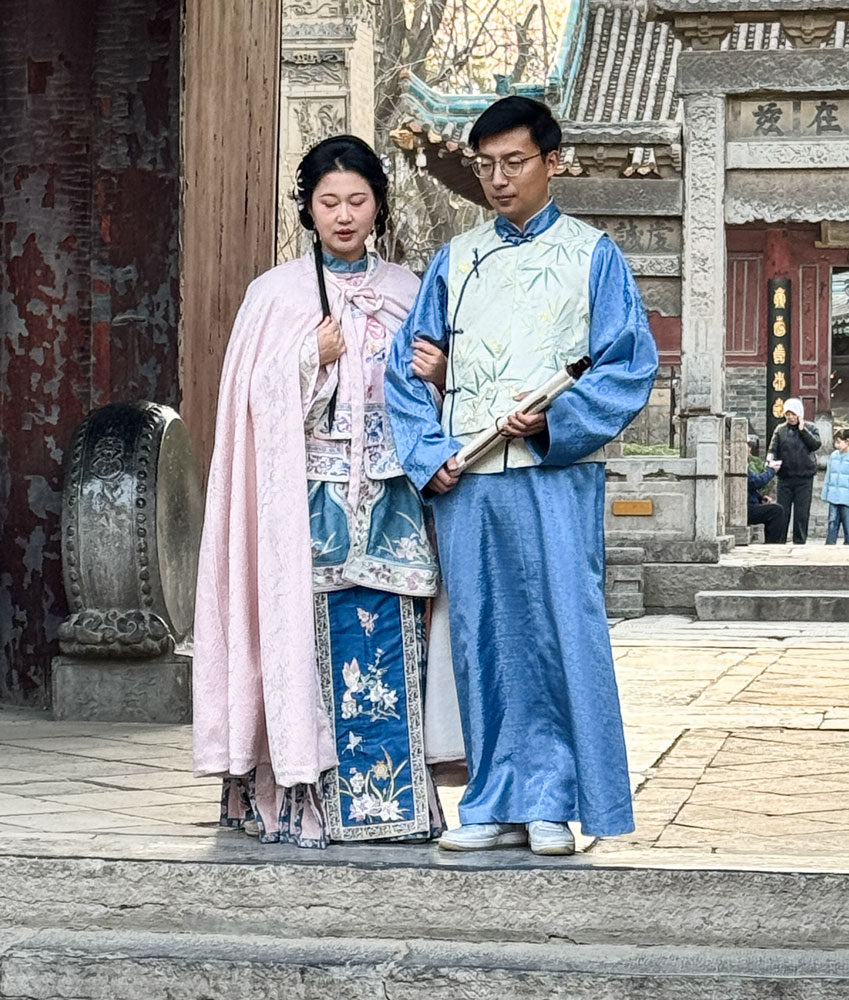
From here, we walked to the restaurant for dinner. It's a dumpling restaurant and we will sample quite a number of different dumplings.
The preparation of the dumplings.

Some of their fancy dumplings. The ones we'll have will be simpler.
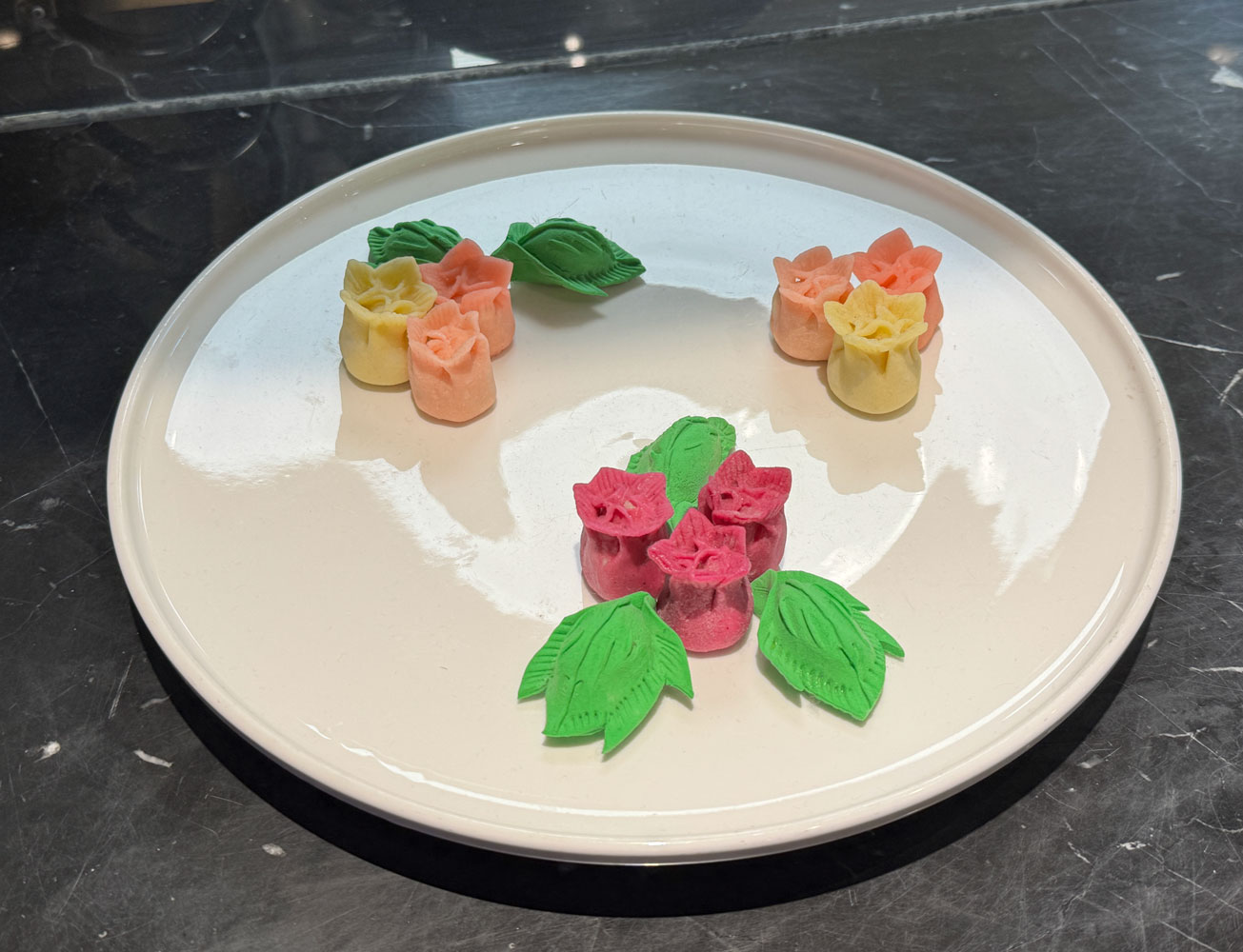



The group at the table. Having only 10 people was nice - we could all be at the same table.

Some of the dumplings, and other items we had for dinner. It was quite good.

It was dark when we finished dinner. The area lights up at night, and right outside the restaurant there were several young women being photographed in traditional dress.
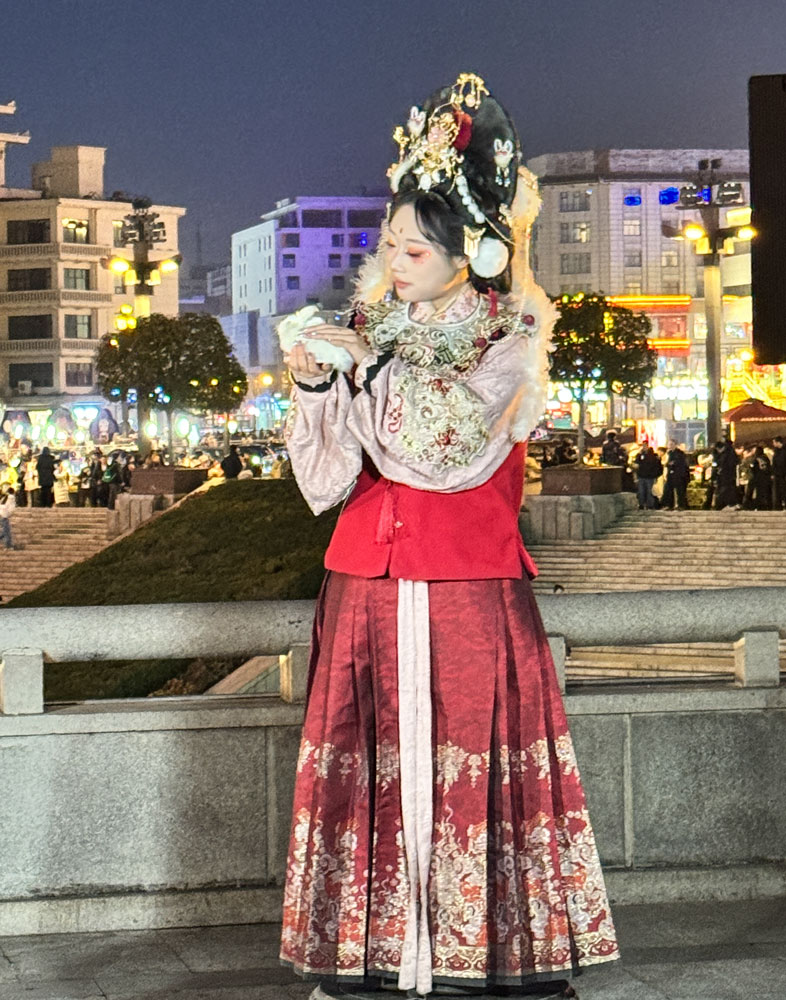
This was a young girl.

Another young woman.

Our bus was waiting and we returned to the hotel. We saw displays of lights along the road. Picture taken through the window of the bus.

Two dragons seen from the bus.

We arrived at the hotel - the https://www.shangri-la.com/xian/shangrila/ - and received our room keys. We were all fairly tired by now. Our room is nice, about the same size as the room in Hong Kong, but the bed is huge. It's much wider than a king sized bed, more like two queen beds put together.

That was it for the day. We were both exhausted and fell into bed as soon as we got things sorted out.
[Side note: I listened to how local people pronounce Xi'an and there were slight variations. The primary pronunciation was "she an". An alternate pronunciation was "cee an". Before we left, I thought the way to pronounce it was "gee an".]
+++++++++++++++++++++++++++++++++++++++++++++++++++
2/17/2025 (Monday) We go to the Terracotta Warrior museum today. It's outside Xi'an about 25 miles east.
Judy and I were up about 5:30am but were rested since we went to bed fairly early. Breakfast in the hotel was heavily Asian, as you can imagine, and I found it wonderful. They had a section of the buffet that was western, a major section that was Chinese, and a small section dedicated to Japanese food. I tried as many dishes as I could.
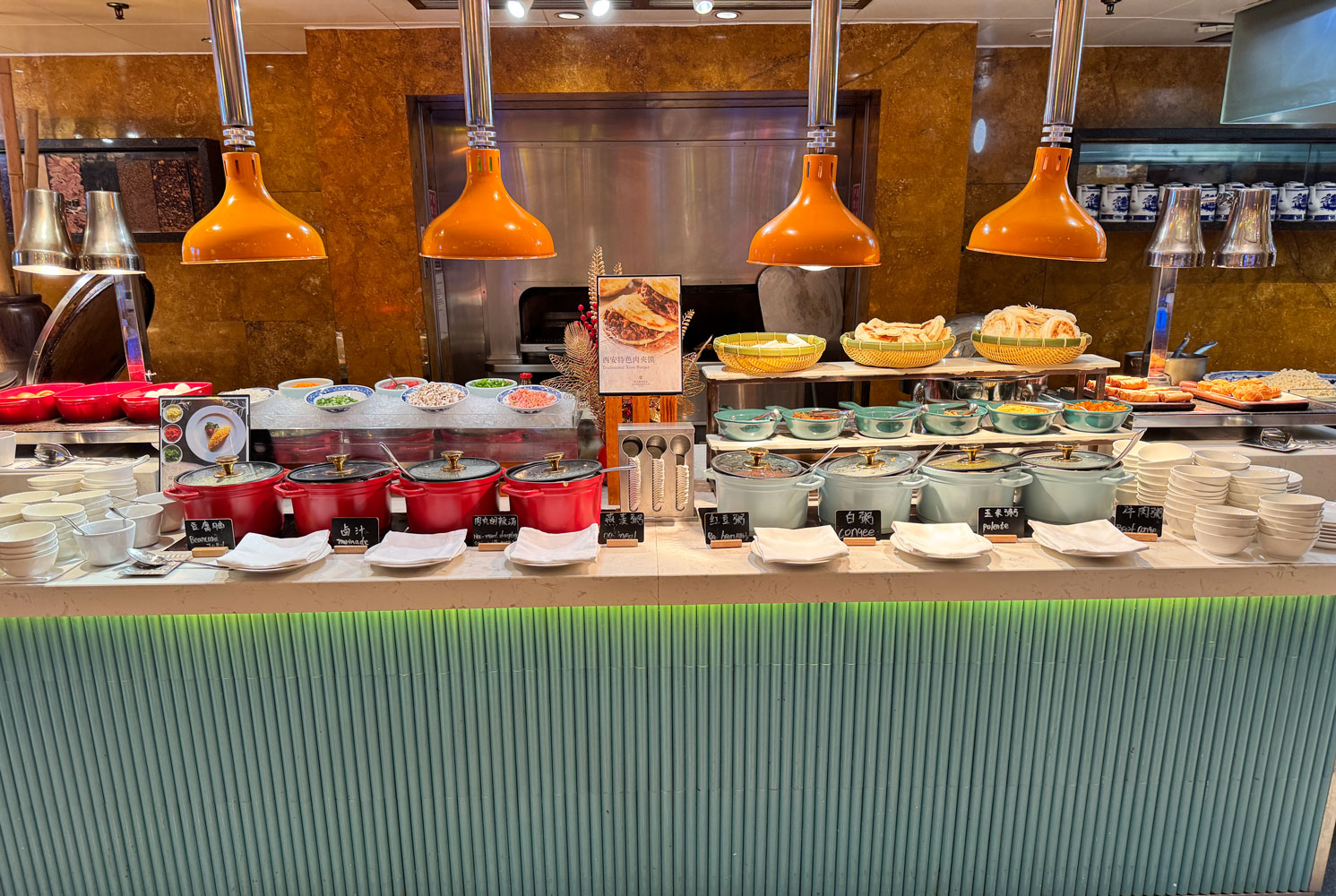
The noodle station.
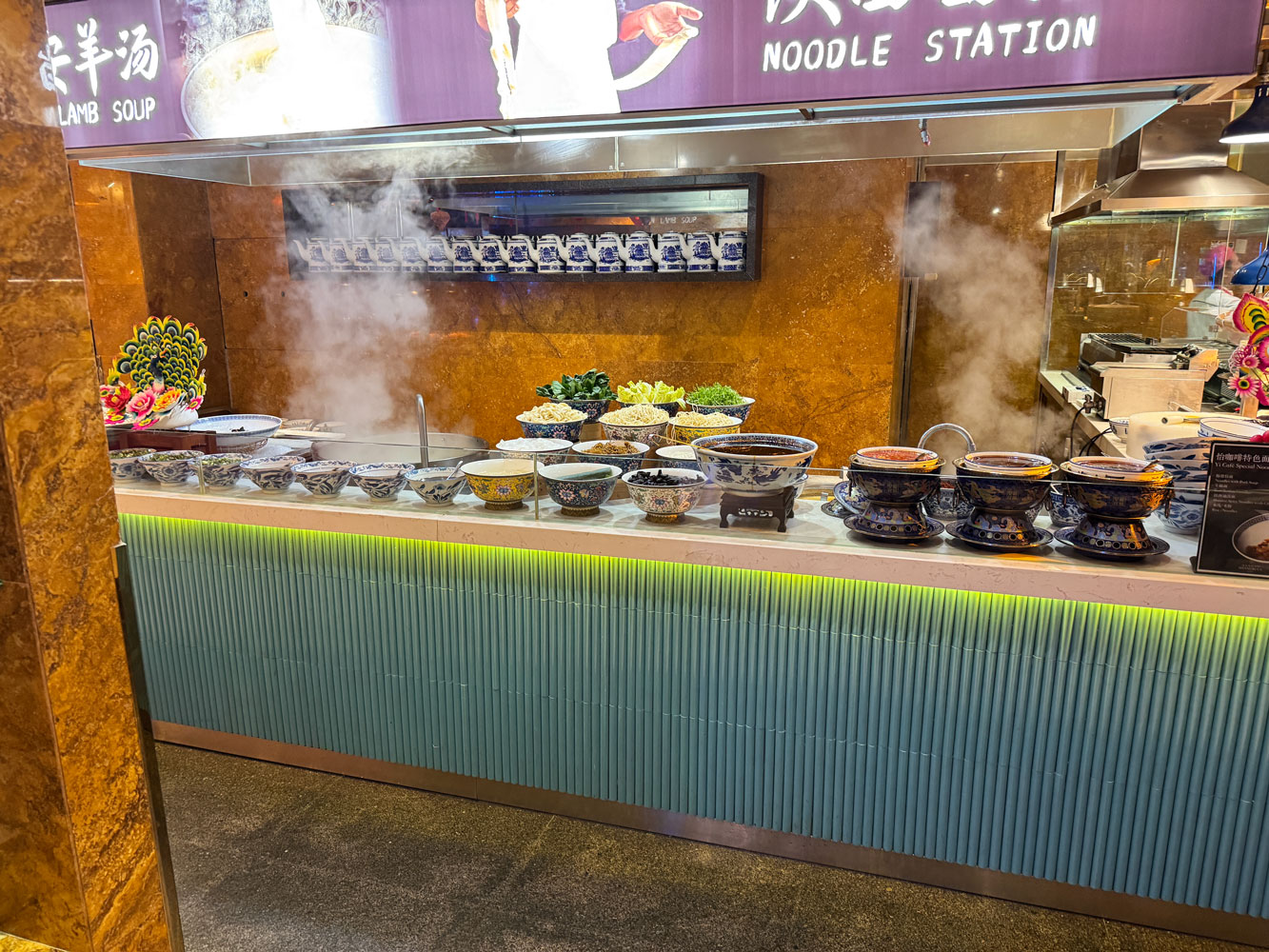
Part of the Japanese station, showing the sushi. They also had miso soup.
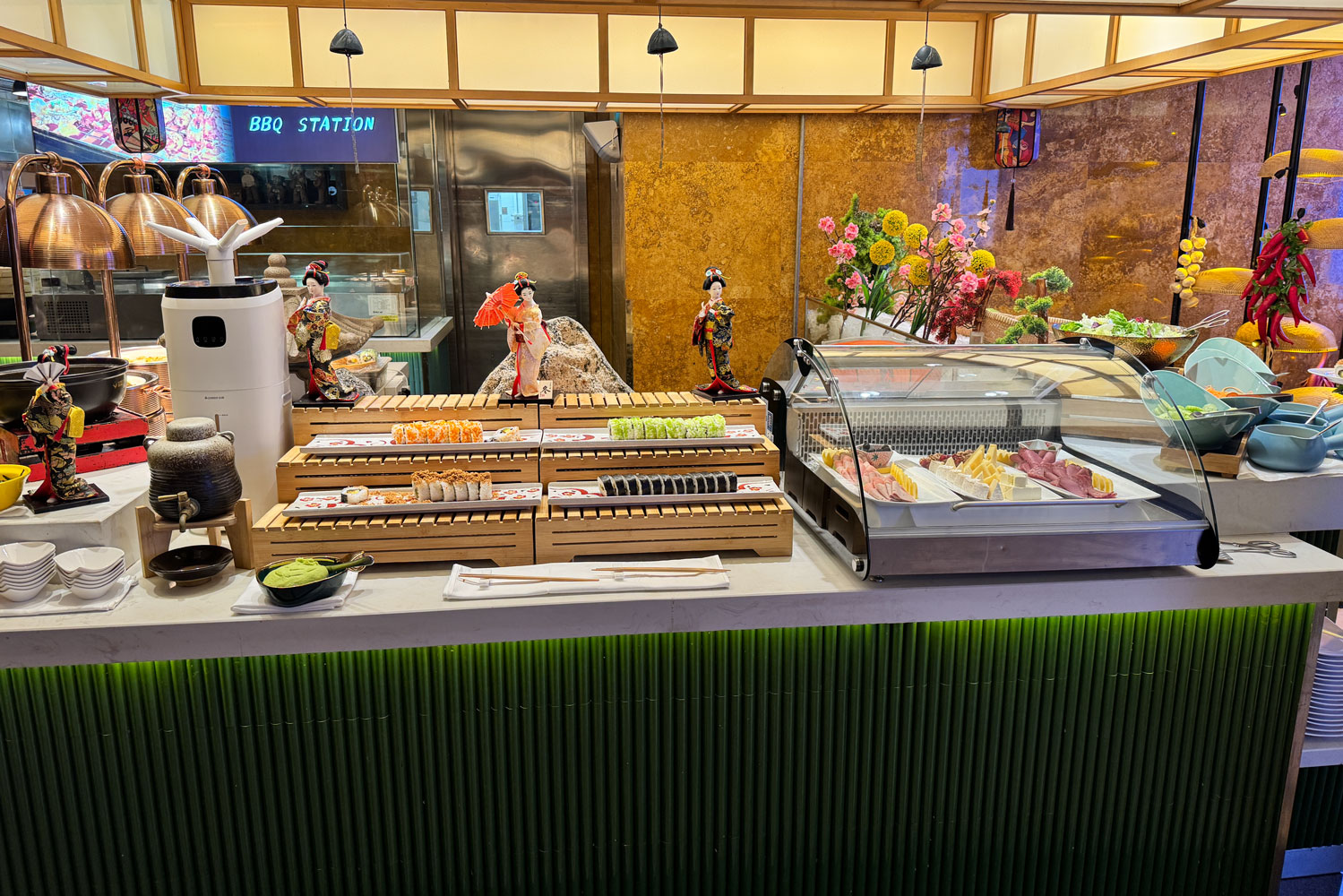
We met the group in the lobby at 8:00 and headed out. This bus will take us around for the next two days. On the drive to the terracotta warrior site, we passed many more of these high-rise residential buildings, and many of them appeared to be unoccupied. This picture is just of a very few of those buildings - it's just impossible to show you how many high-rise residential buildings there are in Xi'an. During the course of our various drives around the area, we saw many dozens of these developments. Each building appeared to be at least 30 stories high. Many more areas of development were under construction.

China had a real estate bubble that burst about 2021, but it especially hit home when Evergrande Group filed for bankruptcy in 2023, with $300 billion in debt (yes, that's "billion", not million). Country Garden Holdings filed for bankruptcy in 2024 with about $200 billion of debt.
China was growing and income for its citizens was increasing. Real estate prices were going up as people purchased better homes, meaning condominiums. The rapid rise in the price of real estate brought many people into the market as investors. For example, a family who already had a home would purchase another unit - or more than one - as an investment, with plans to just hold it and sell it for a profit. That went on for several years.
All of the land is owned by the government - there is no private ownership of land in China. Builders would get approval to build on land in an area and pre-sell the condominiums, collecting payment from the buyer to finance the construction of the building - in addition to large loans from banks.
Eventually, the bubble burst. There were too many condominiums for sale and not enough buyers. The builders could not sell units in their new developments and eventually went bankrupt. Many of the completed developments are just buildings with unoccupied units.
That's basically where China is now.
Some additional articles about the China real estate bubble: Link, Link
We arrived at the Emperor Qinshihuang's Mausoleum Site Museum, to give the official name, at 9:00am. (also see this link)

The story is that on March 29, 1974 farmers were digging a well and encountered pieces of terracotta. One of them eventually reported the find to the government and archeologist Zhao Kangmin was dispatched to check it out. He assembled two warrior statues from broken pieces. A reporter, Lin Anwen, was visiting family in the village, learned about the warriors, and published a story about it. That was the beginning of the development.
China is a communists country and owns all of the land, so the farmers who discovered the warriors probably did not profit, except by working with the tourists companies.
++++++++++++++++++++++++++++++++++++++++
A side note about China's recent history. To skip, click here.
In the early 1900's China basically fell apart into different fiefs as the emperor lost control of the country. In 1931 Japan invaded China and easily defeated the Chinese army.
Japan was extremely cruel to the Chinese peasants during the war and massacred many civilians during their occupation, which lasted until the end of World War II. The following map shows the extent of Japanese control during the war.
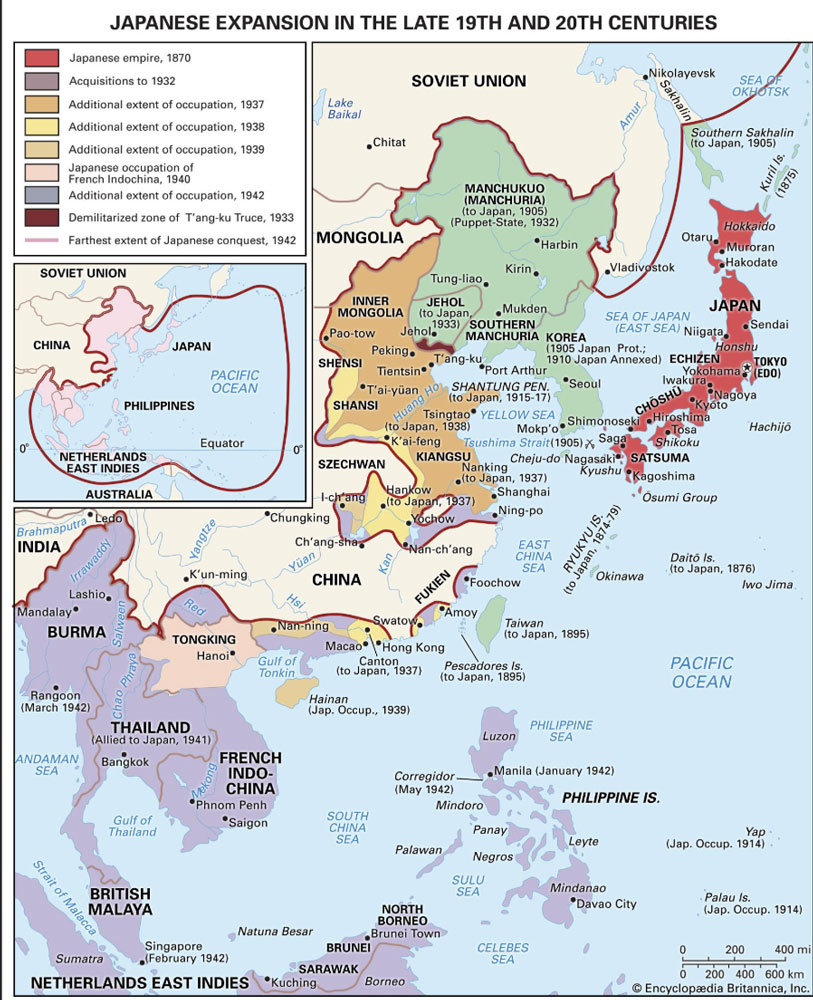
During the war, there were two major contending parties: The Nationalists led by Chiang Kai-Shek, and the Communists led by Mao Zedong. The Nationalists were corrupt. Military aid provided by the United States during WWII was diverted by the generals to enrich themselves, with some of the military hardware (especially food, clothing, vehicles, and even some arms) being sold to the Communists. The Nationalists army was poorly led, trained, armed and was generally ineffective during WWII. The United States wanted to use airbases in China to attack Japan but the Chinese army could not control any area close enough to Japan to make that feasible.
Both sides realized that, for them, the real war was going to be after the end of WWII. The Communists did very little to fight the Japanese, even entering into unwritten agreements with the Japanese to leave each other alone in northern China. They wanted to preserve their army for the future civil war.
After WWII, the China civil war started and the Communists were the victors. The Nationalists retreated to Formosa (now Taiwan).
The Communists nationalized everything, including land, and set up farming collectives, which were quite unsuccessful. The government published five year plans, none of which were ever met, and many, many Chinese peasants died of starvation (same thing happened in Russia under Stalin).
Eventually, the Communists recognized that Socialism would not work so they allowed Capitalism in the marketplace, but kept the Communist Party for control - the Socialist Market Economy.
So far, this has been very successful for them, but the government will pull down a successful person or company who becomes powerful enough to be a threat to the Party.
+++++++++++++++++++++++++++++++++++++++++++
Back to our tour, but first a bit of ancient China history. In the years 475-221 BC, China consisted of seven states, today known as the Seven Warring States. One of those states was the Qin, ruled by Qin Shi Huang. Through a series of military operations, Qin was able to conquer all of the other states and unify China.
Shortly after his elevation to emperor (he called himself that name) he began work on the terracotta army. There are three pits of the warriors, with about 8,000 soldiers, 130 chariots, 520 chariot horses, and 150 cavalry horses.
Qin died about 210 BC. His dynasty did not last. In 206 BC, Le Bang defeated the Qin ruler, Ziying, and founded the Han dynasty.
As we got off the bus at the site, a worker handed us each a "tour guide" unit that will allow us to hear Ivy2 as she tells us about the warriors.
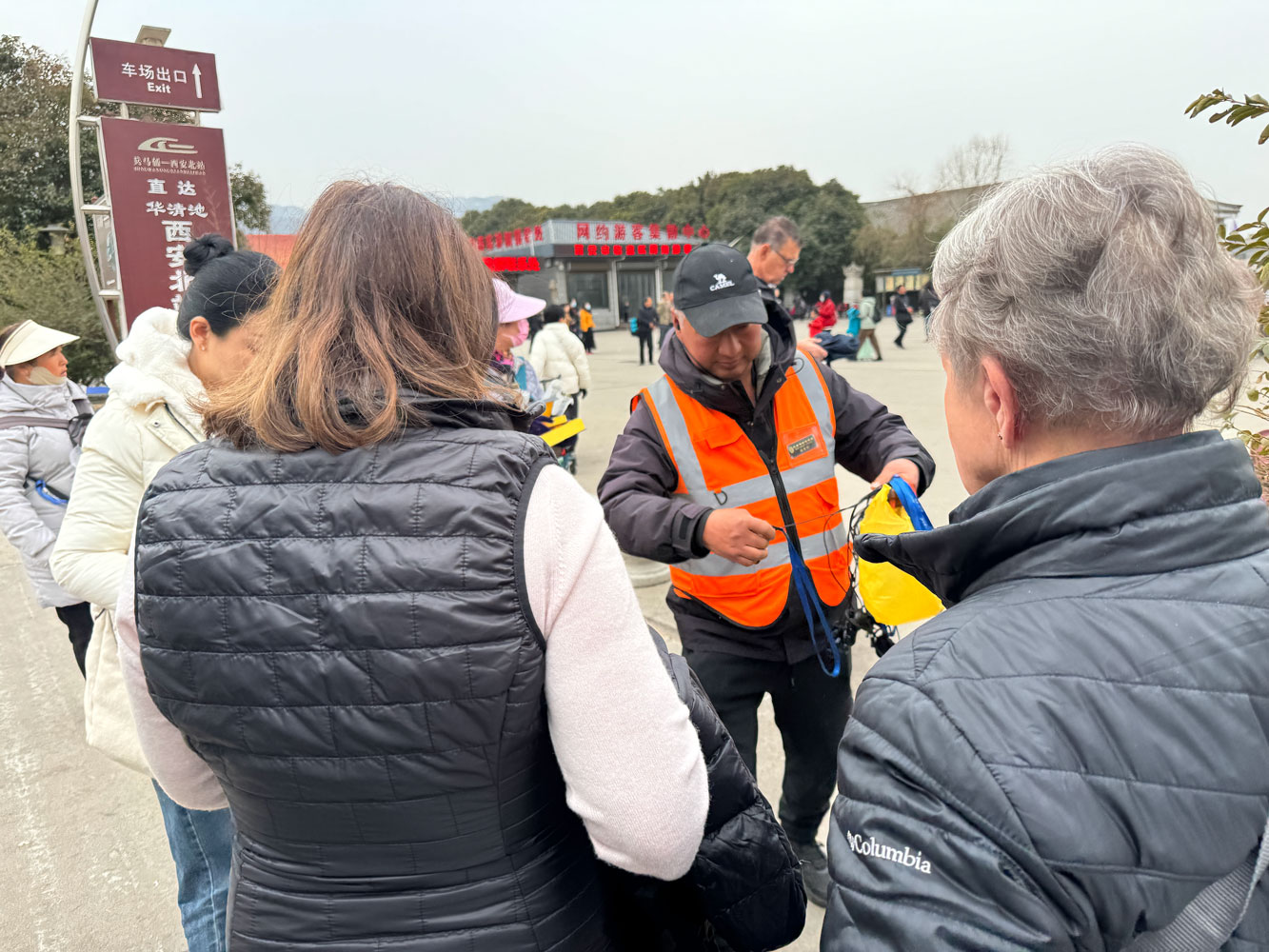
Then we headed towards the ticket office.
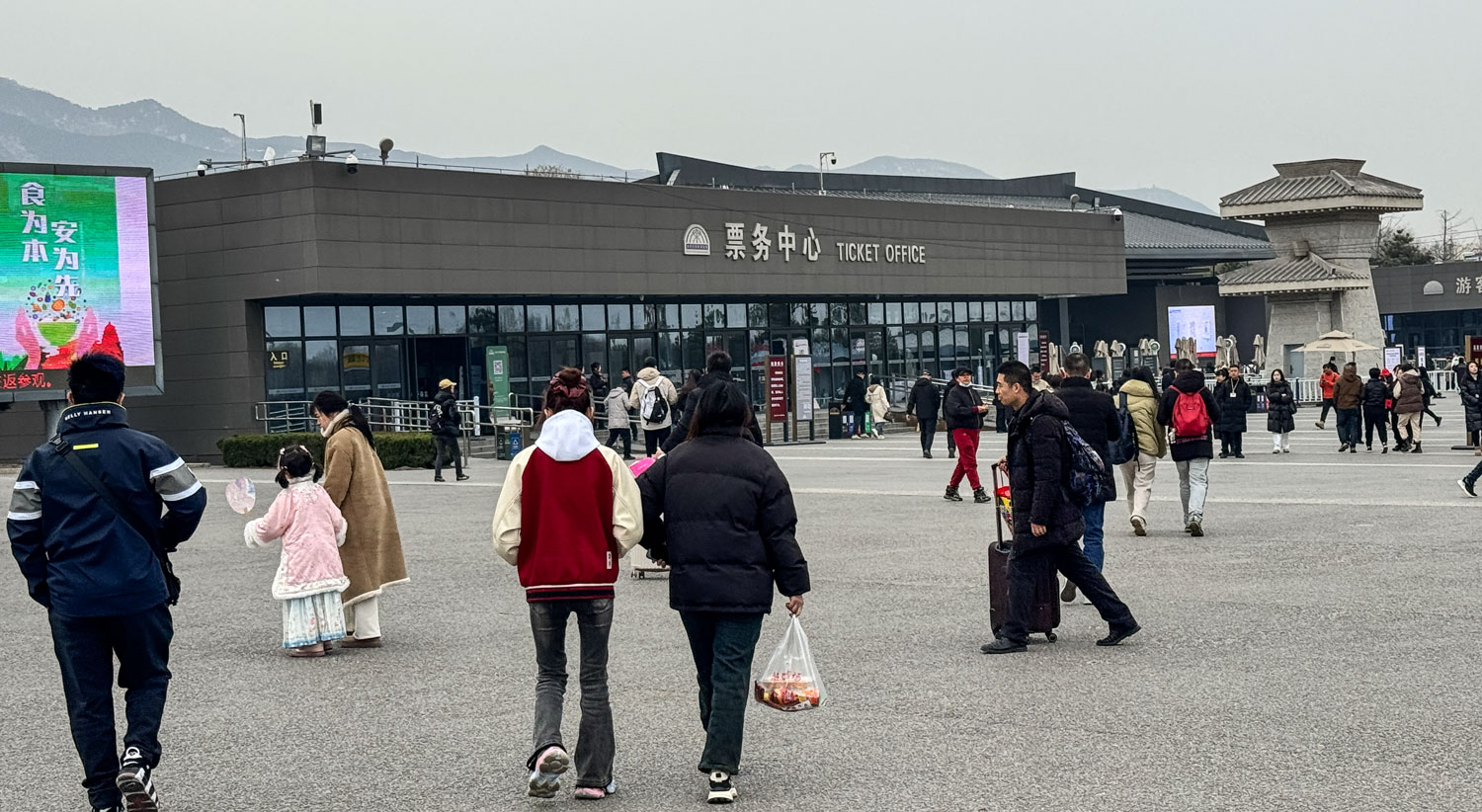
Behind the ticket office were the entrance gates, where we had to present our passports to enter. Our passports were scanned.
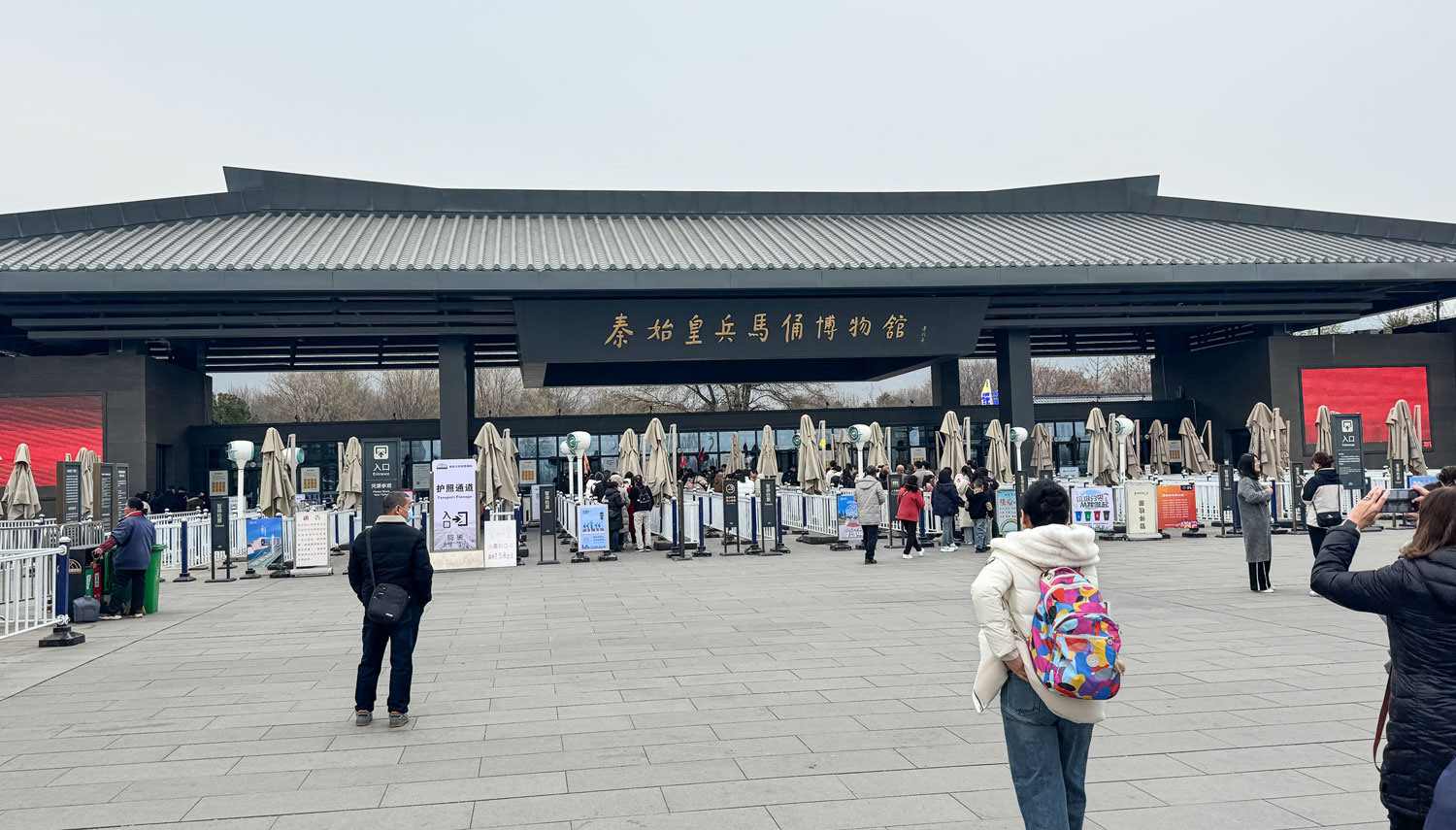
Behind the gates, we boarded an electric tram to go the location of the warriors.
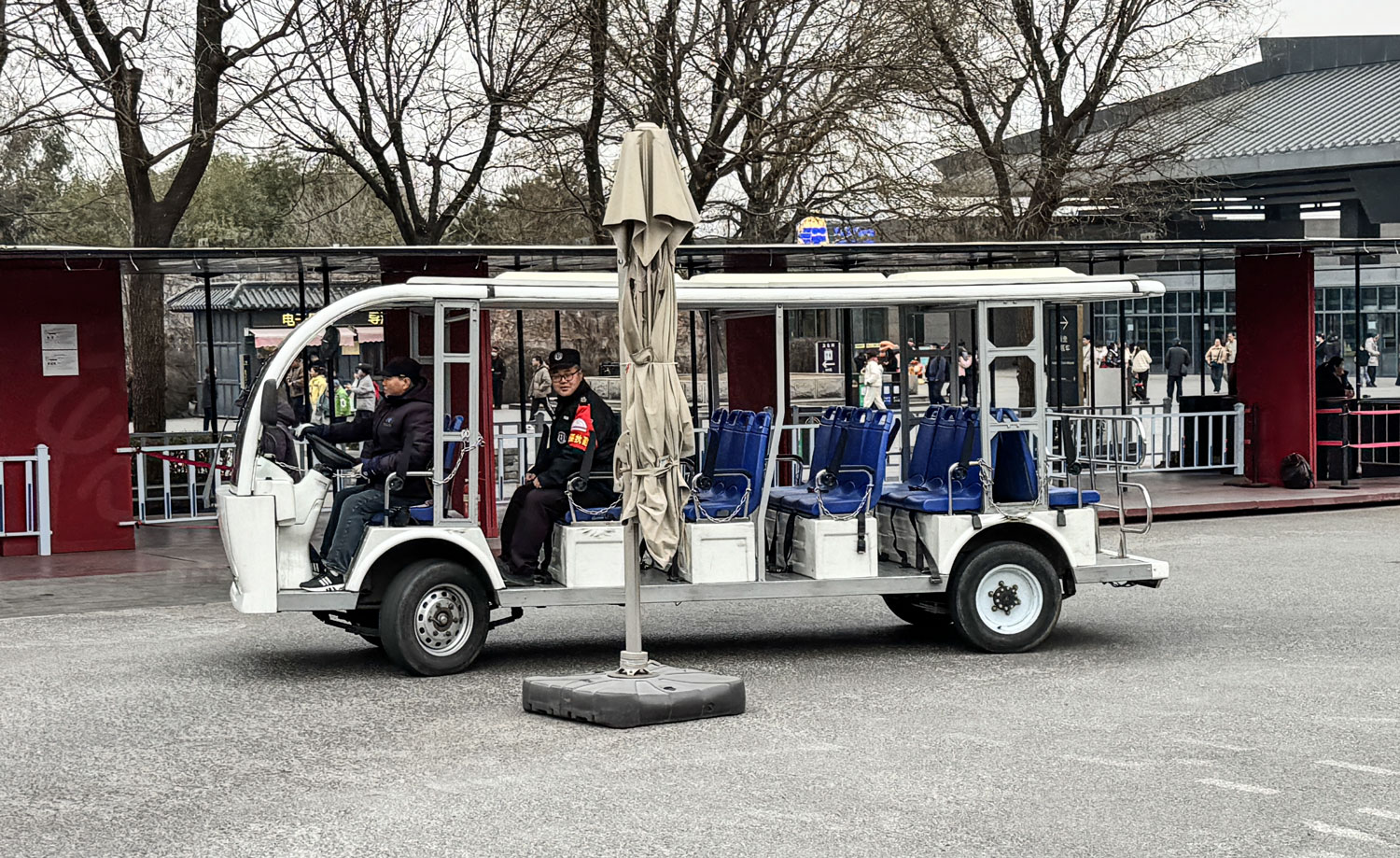
When we arrived at the museum, proper, we had to go through another checkpoint.

This checkpoint just scanned our faces to identify us. Here's Judy coming through the gate.
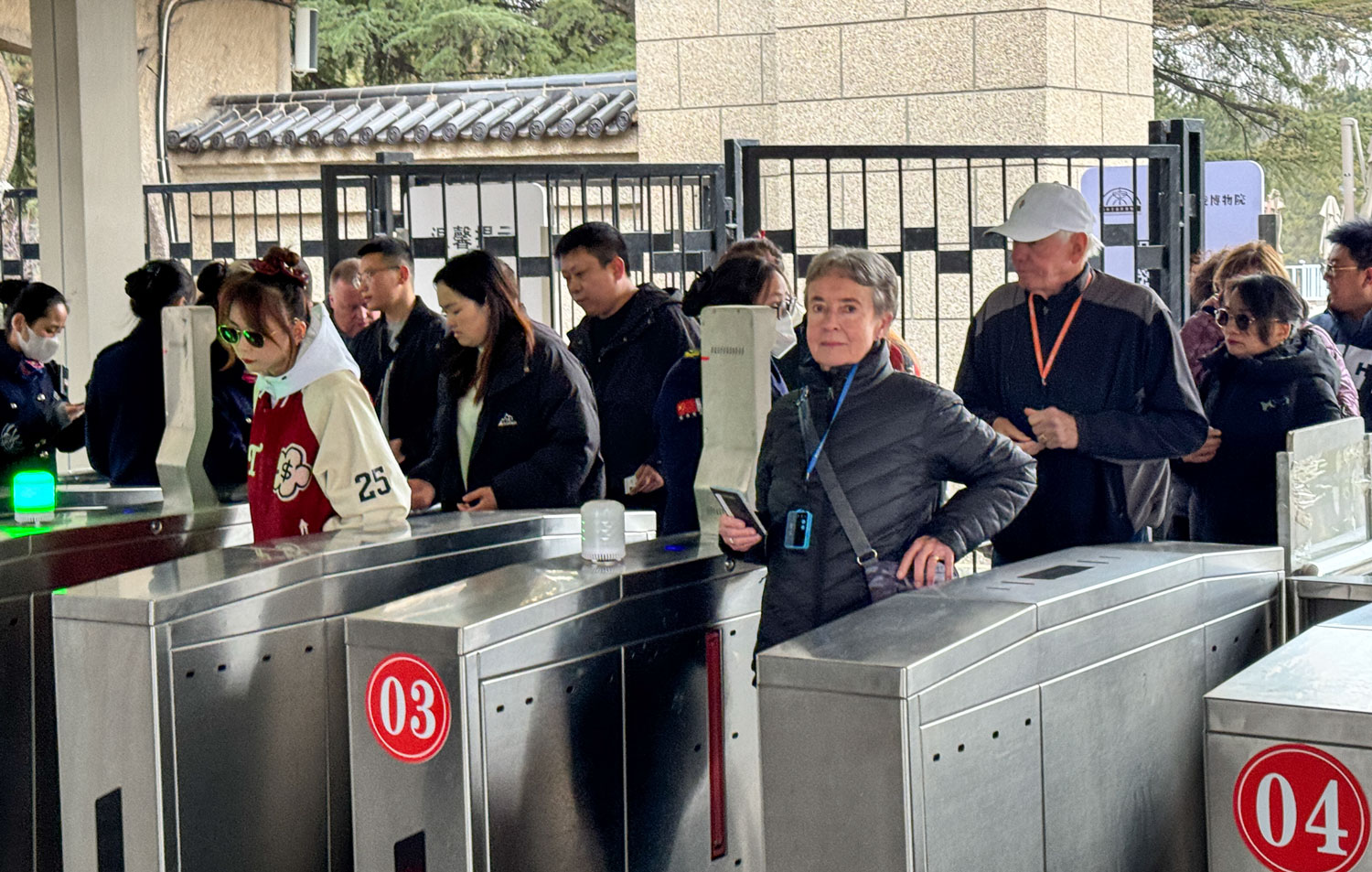
When we exited this last gate, we were in a large plaza. The building in the background covers one of the excavation sites.

We walked to the entrance where there was a line for us to enter, but it moved quickly. Ivy-2 said that the museum was not nearly as crowded as it can be.

This is what we saw when we entered the structure. I believe this is called Pit 1.
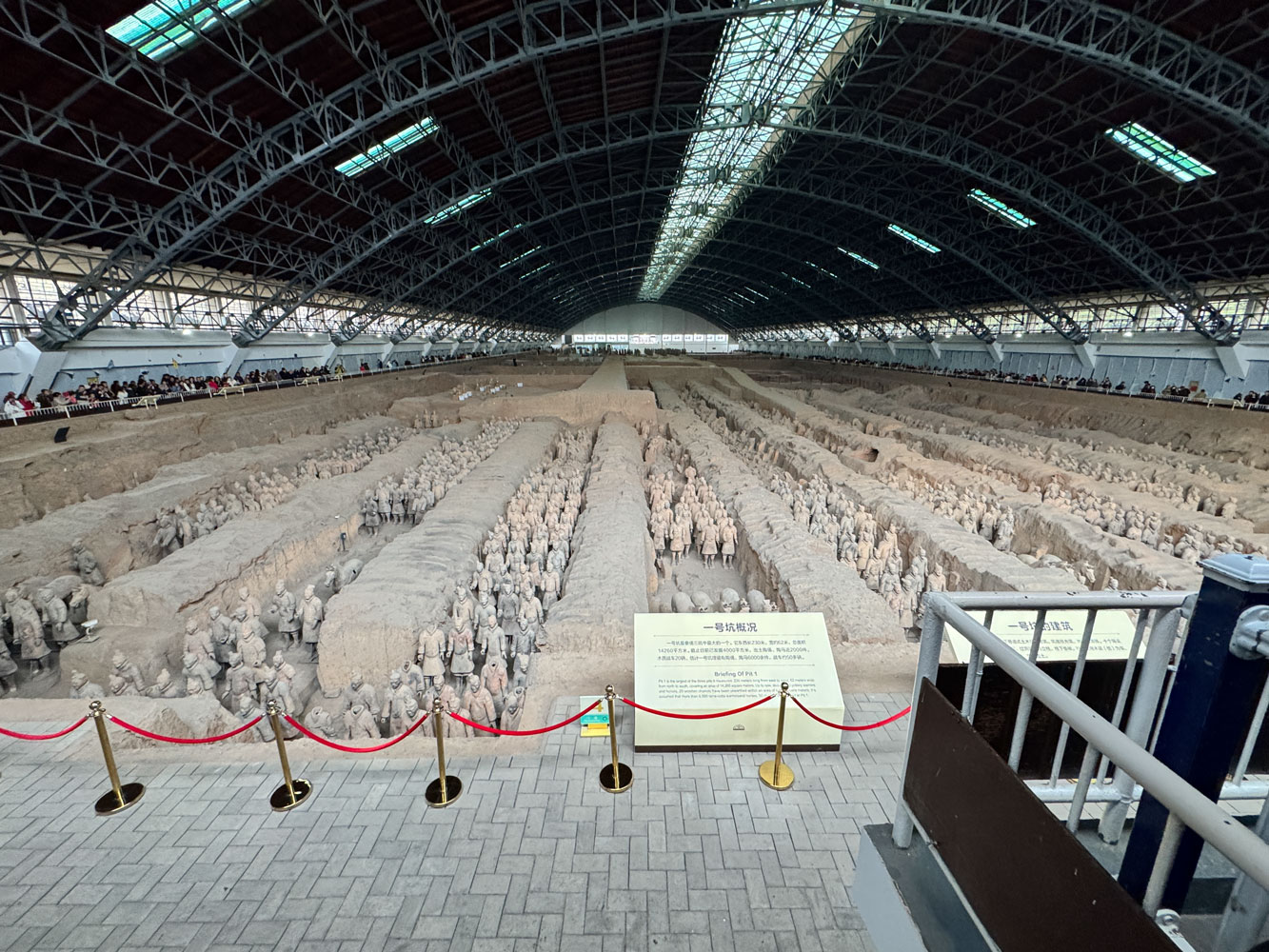
Judy at the terracotta warriors.
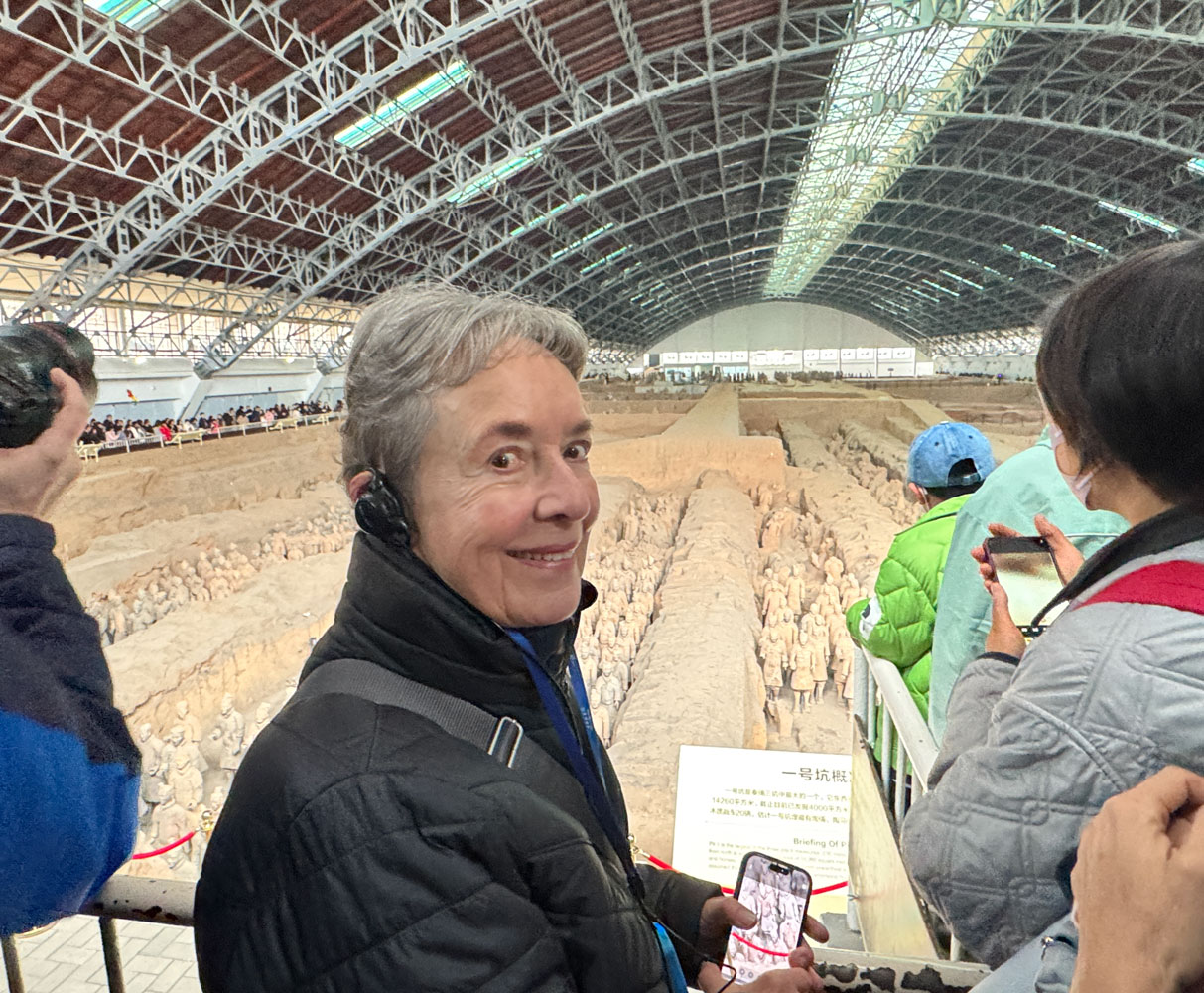
Some closer views of the warriors.


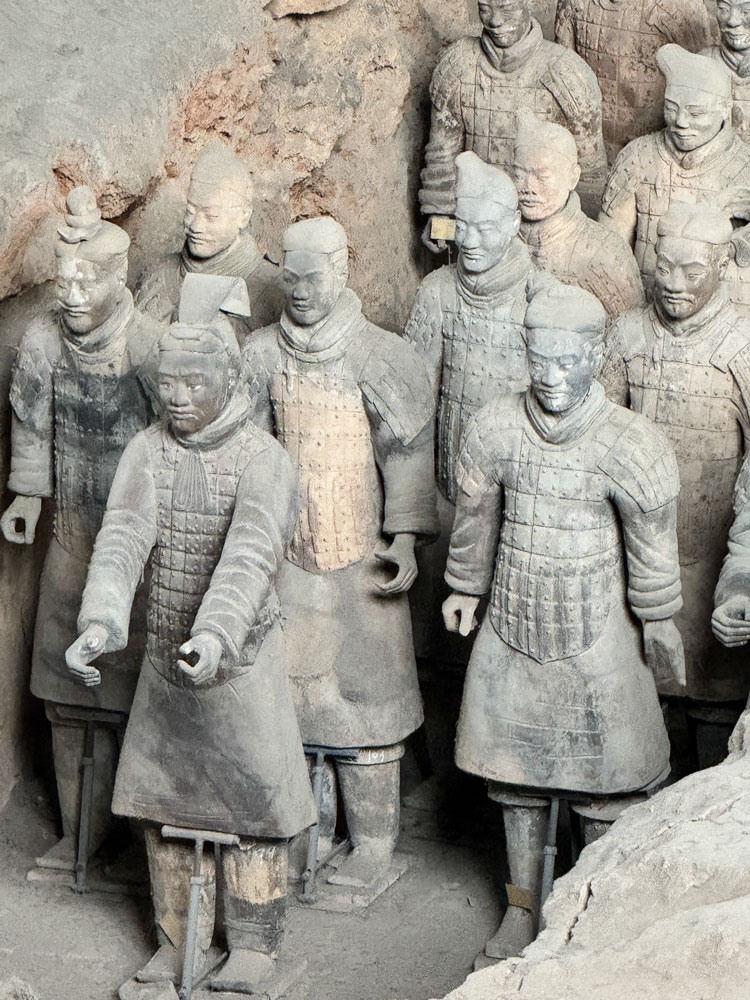


Judy and me at the warrior museum.

The warriors were made in two parts: a head, and a body.
Scholars have identified ten base facial forms on the warriors, but each head was modified after it was molded to make them unique. The bodies were not molded but built up by hand and are not as finely detailed as the heads.
There are practical reasons for making the statues that way. Both the head and the body need to be hollow. Clay shrinks as it is fired, so if you attempted to fire a solid piece of clay, the outside portion would shrink faster than the inside because it would be heated faster. Because of this, the outside layer would crack. This limits the thickness of the clay in both the head and body.
[Side note: Western toilets are made of fired clay. I've seen a green toilet (meaning unfired) and it's quite a bit larger than the finished product because of the shrinkage during firing.]
I suppose one additional feature of this approach is that if a head has a defect, they could just replace it without having to re-do the body.
Colored paint was applied to the head and body but very little of the color remains. They have done some statues with color to show what the warriors must have looked like.
The position of the arms and hands of some of the statues may seem unusual. That's because they were holding a weapon, but the weapon (spear, bow, etc.) was made of wood and decayed.
Now, back to pictures.
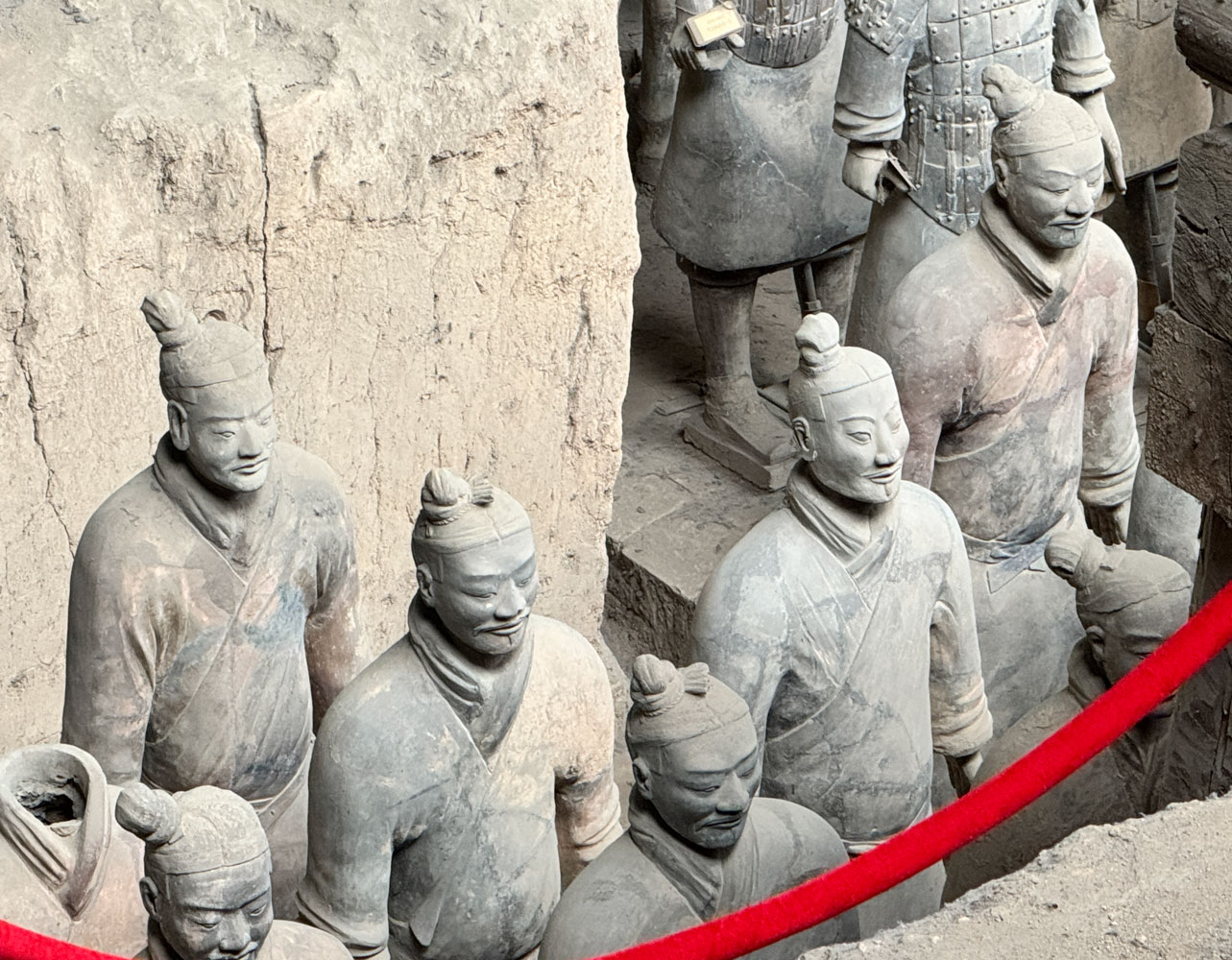
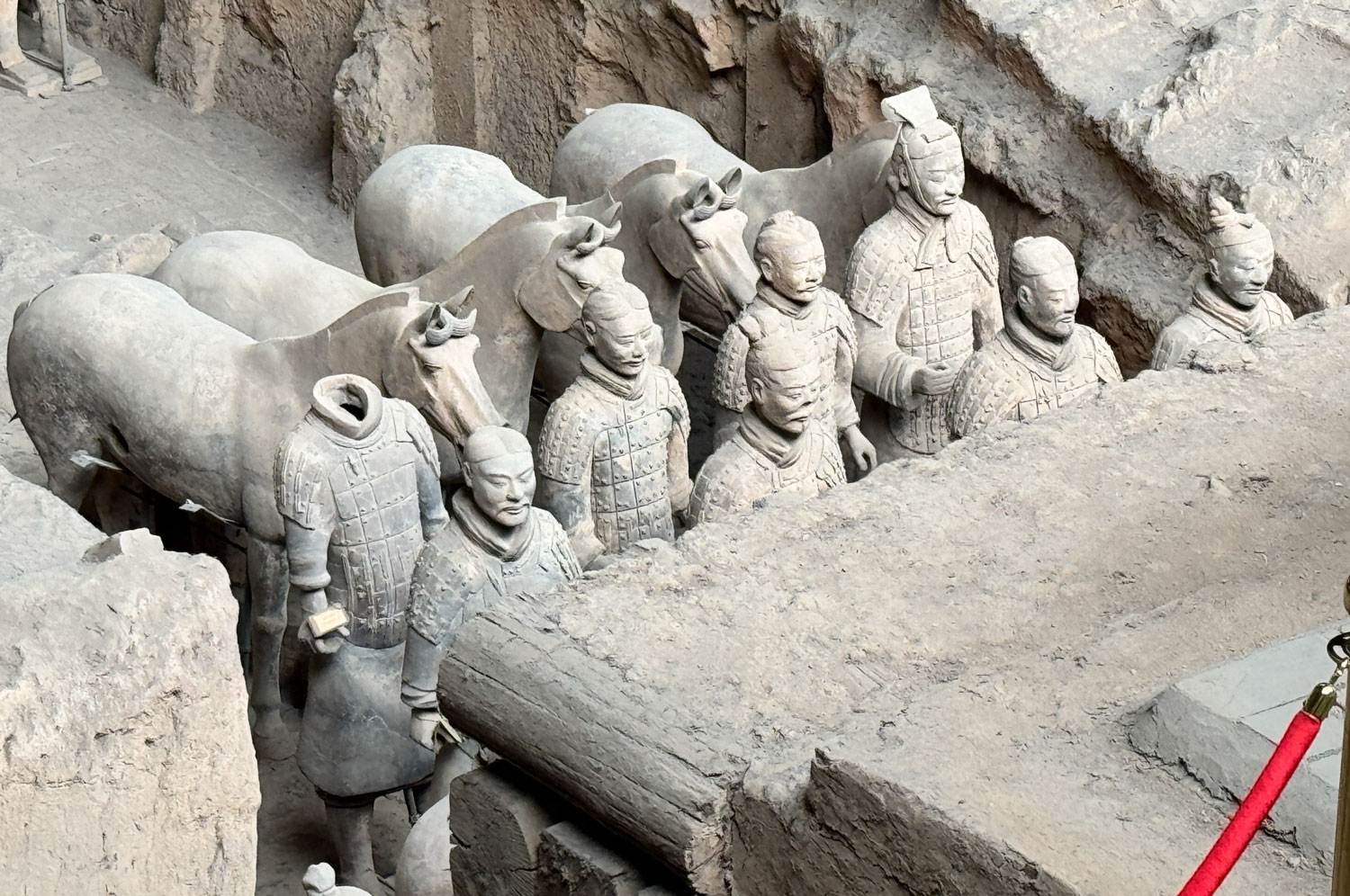



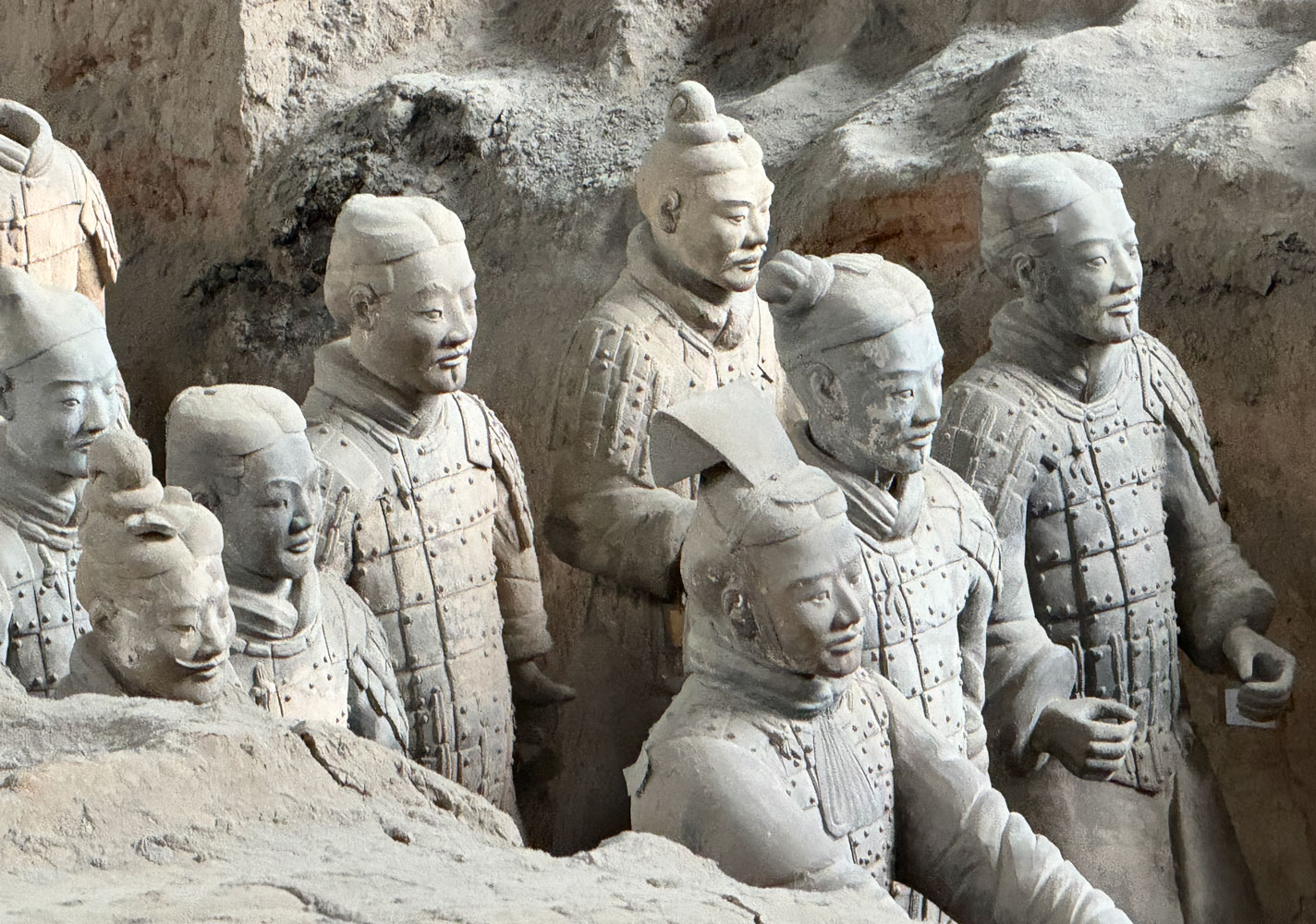
A view of the warrior pit from the rear.
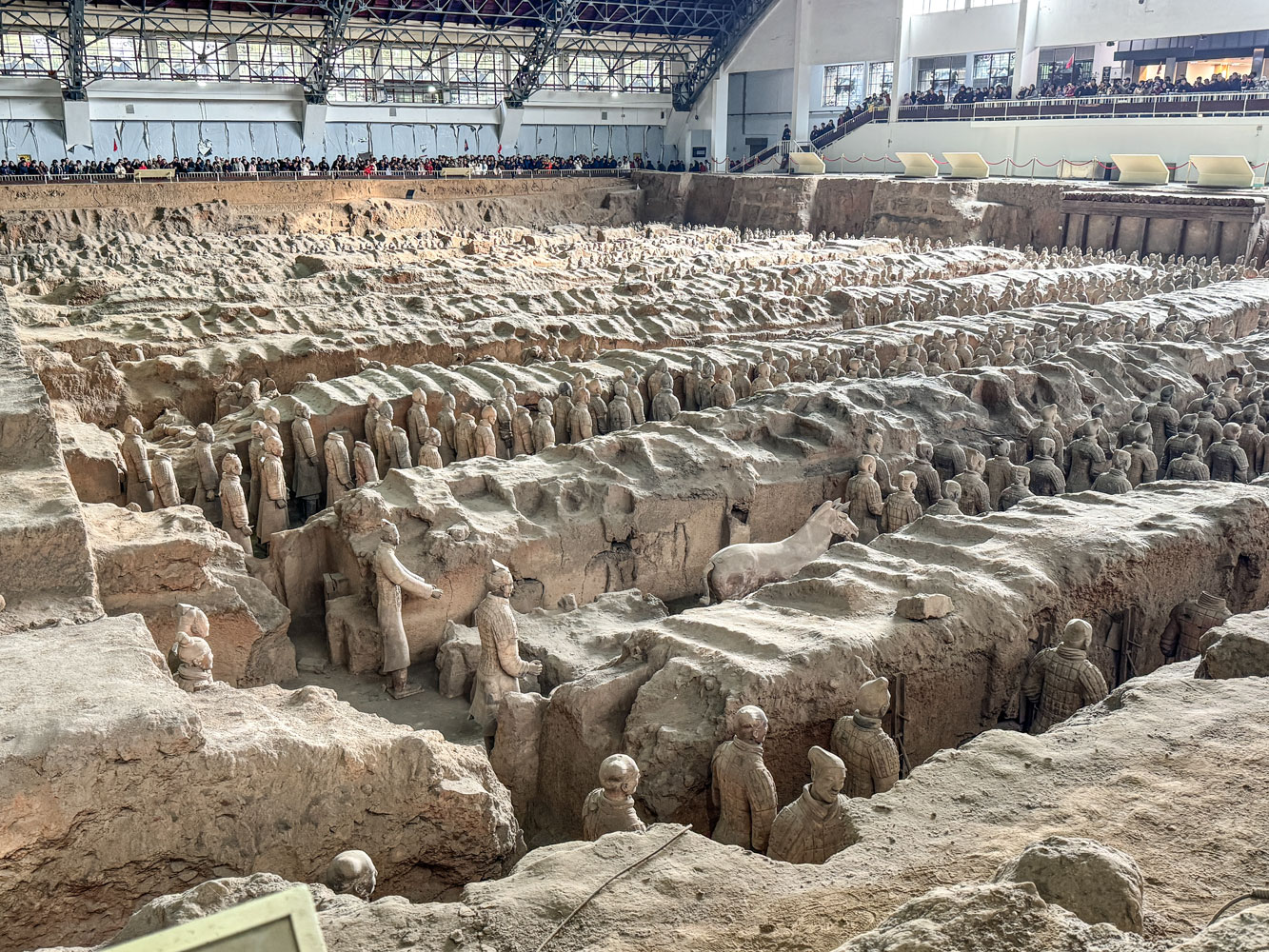
Judy in front of an area where they do restoration of the statues. Many of them have undergone extensive restoration, as the original roof had collapsed and left them underground for centuries.

We left Pit 1 and walked to Pit 3, which is very small, containing only a few statues of soldiers and horses.
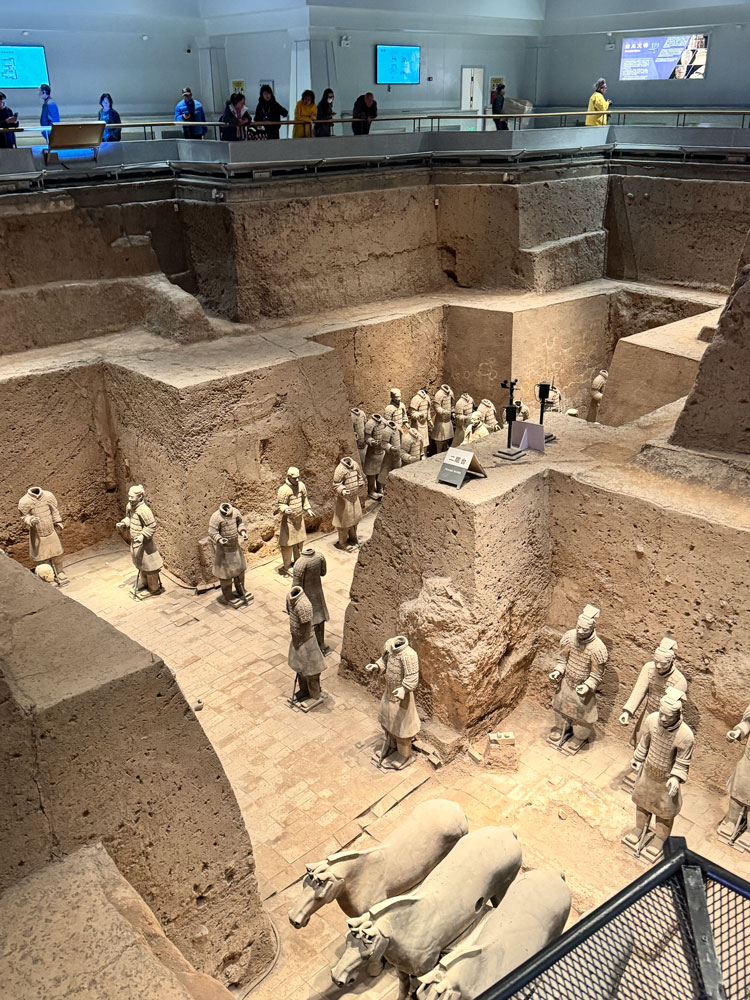
Another view of Pit 3, from a different angle.
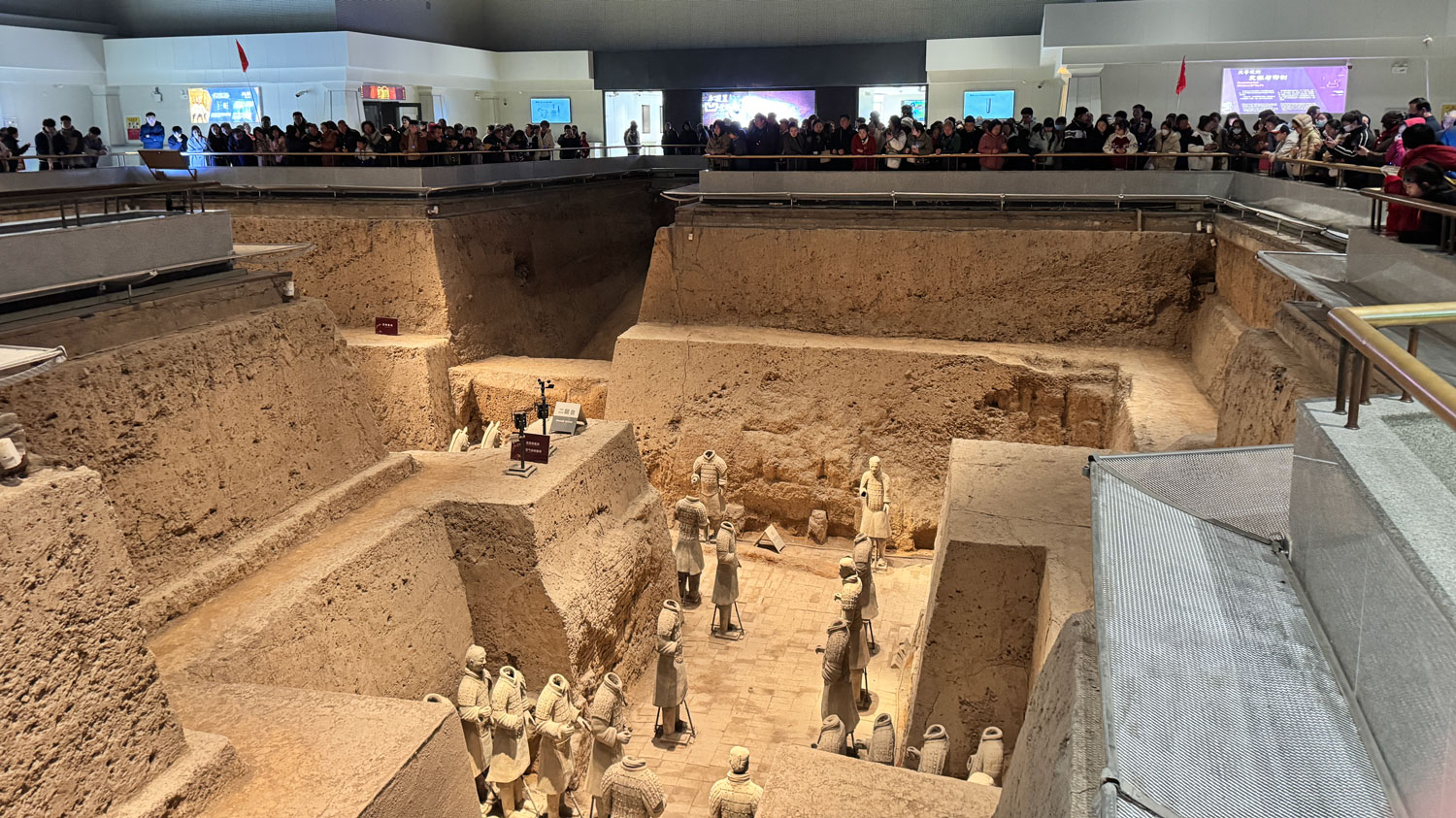
Horses in Pit 3.
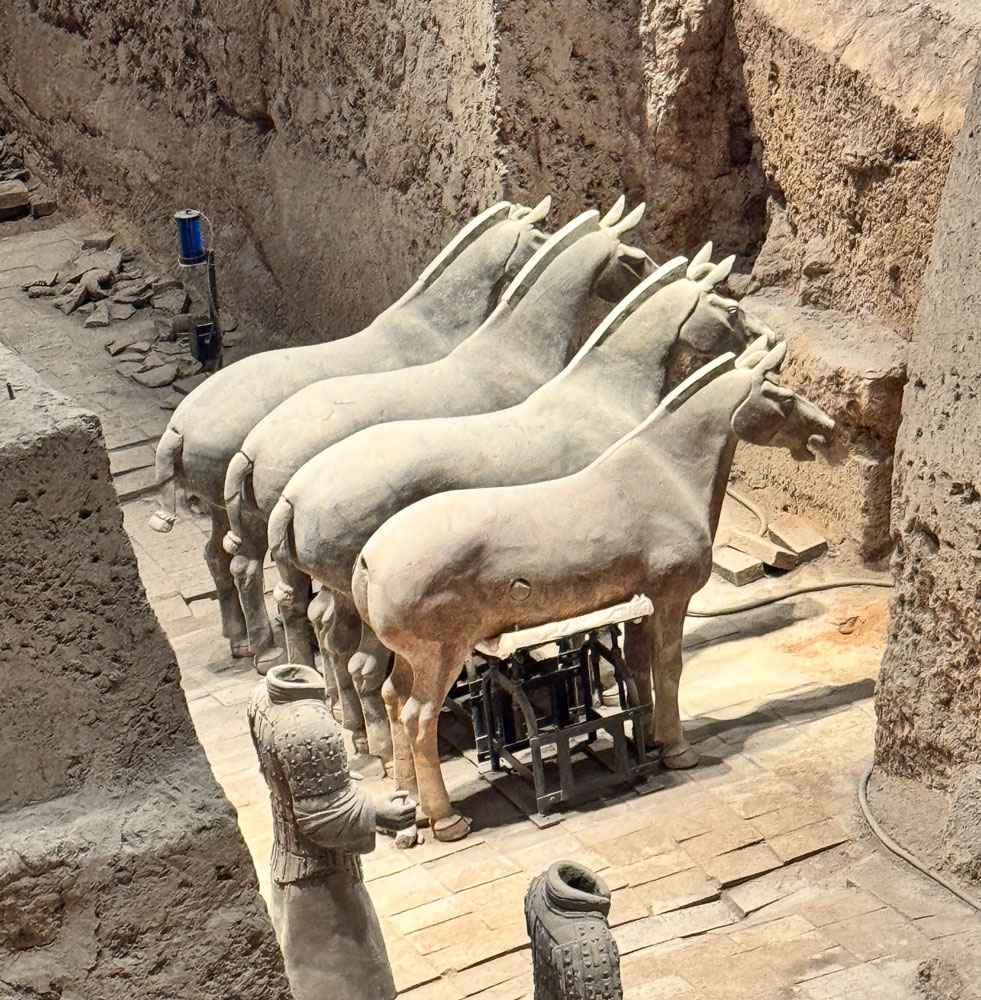
Our last stop was pit 3, where they had some of the restored statues behind Plexiglas, so that we could have a close-up view of the soldiers. Here's one that was identified as a kneeling archer.

A closer view of his upper body.
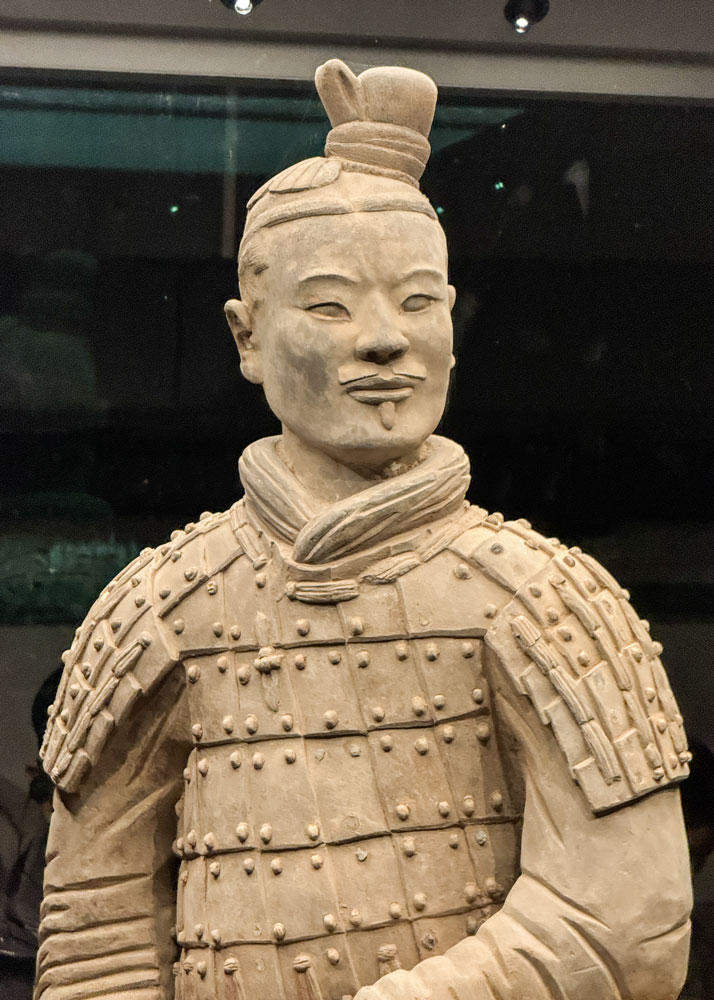
Perhaps a general?
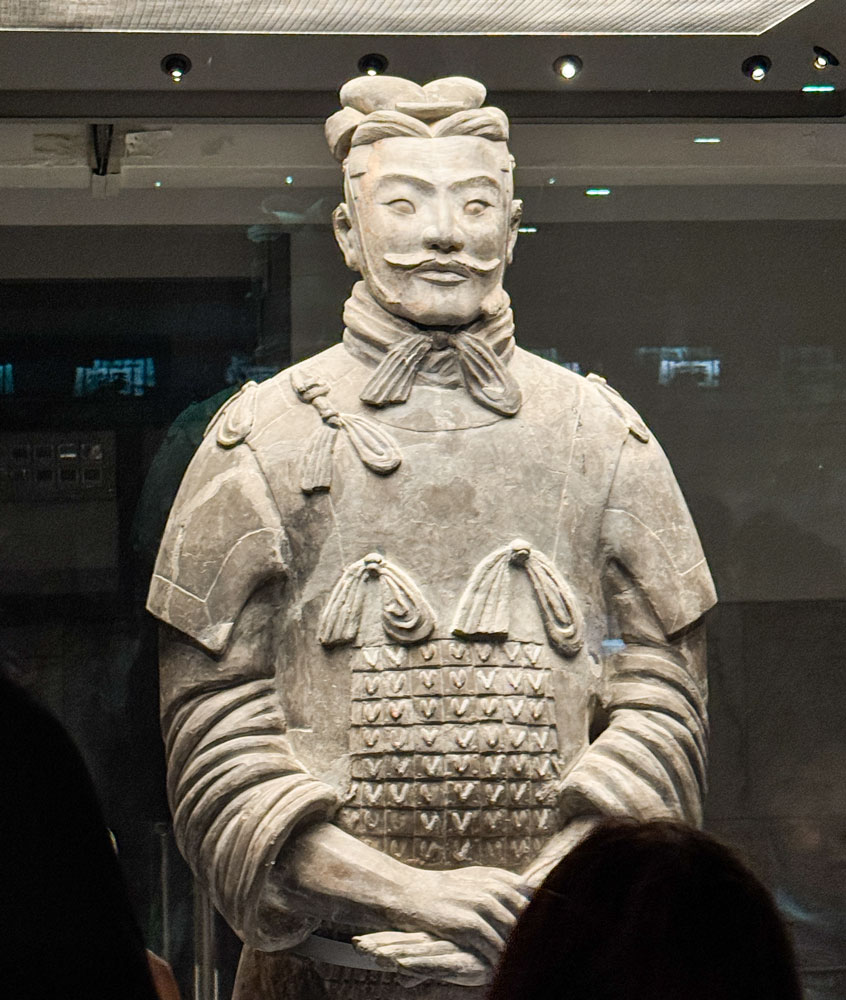
A closer look at his face.
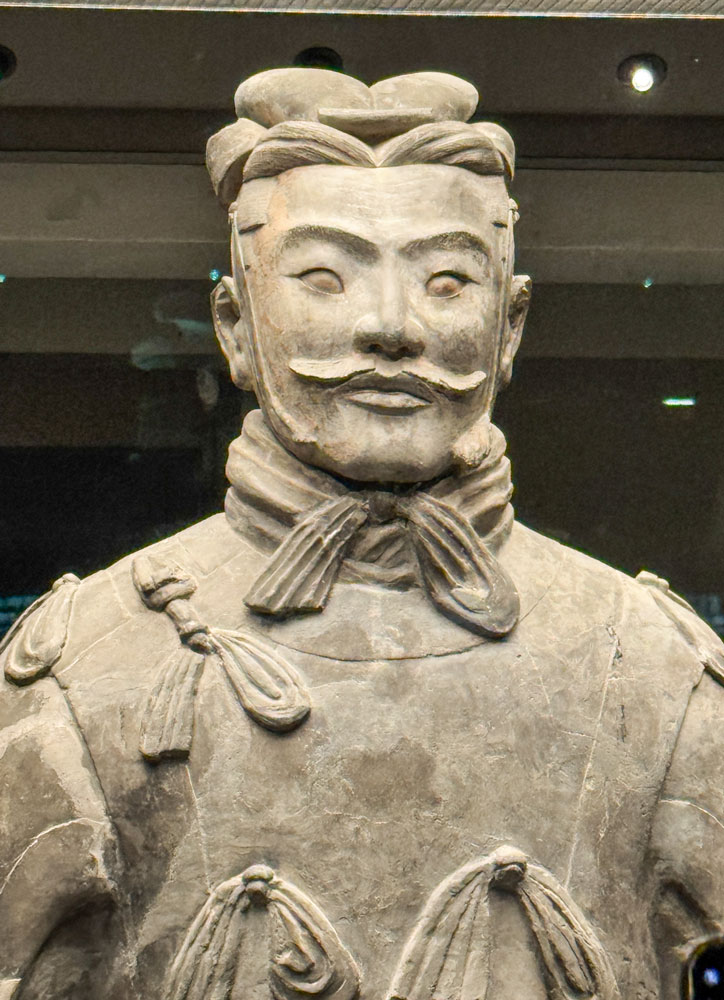
A soldier. He would have held a spear in his right hand.

A closer view of his face.
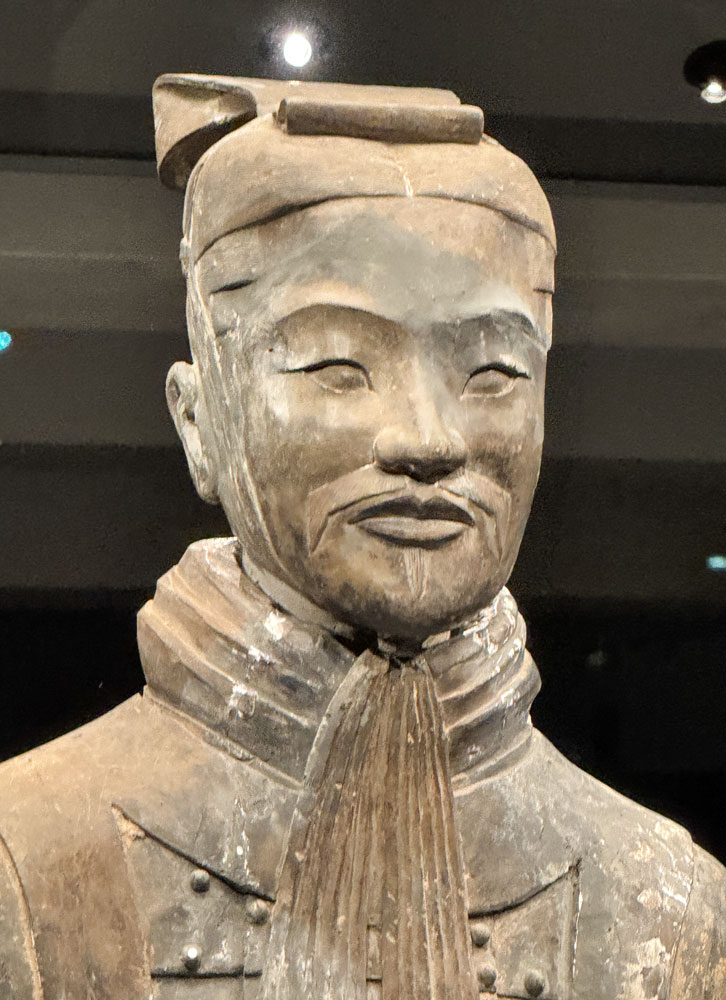
A cavalryman with his horse.

Closer view of the horse. Looks very real. They were Mongolian horses.
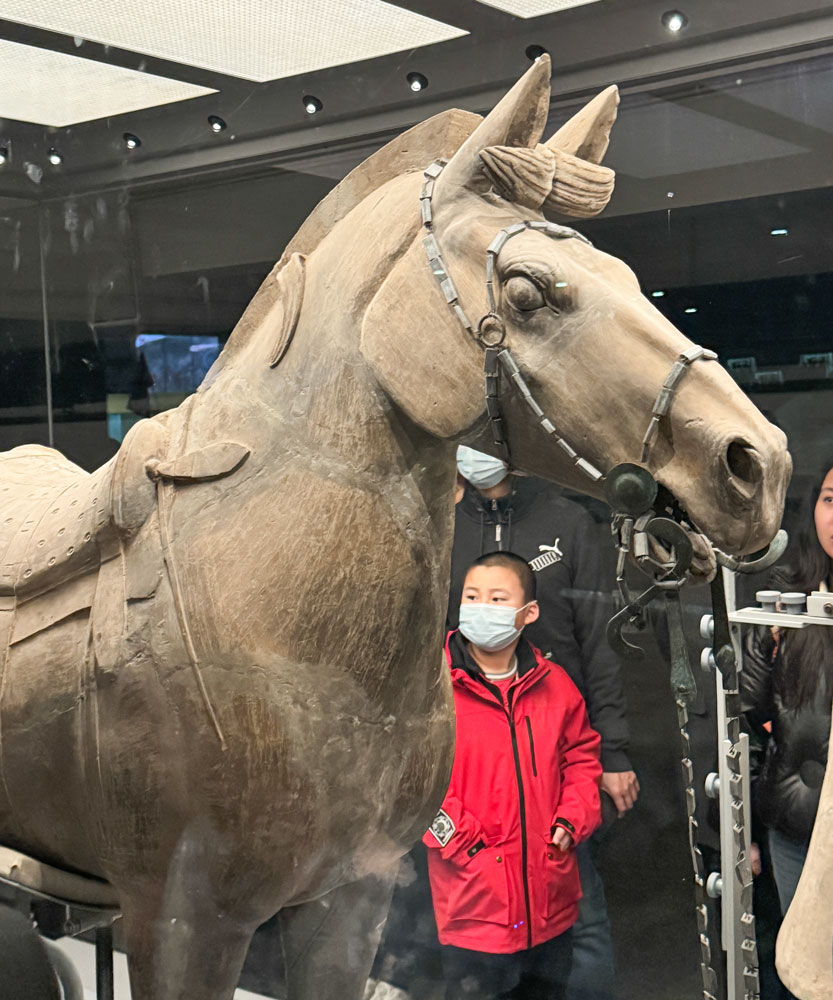
A soldier, but I don't know what his weapon would be.
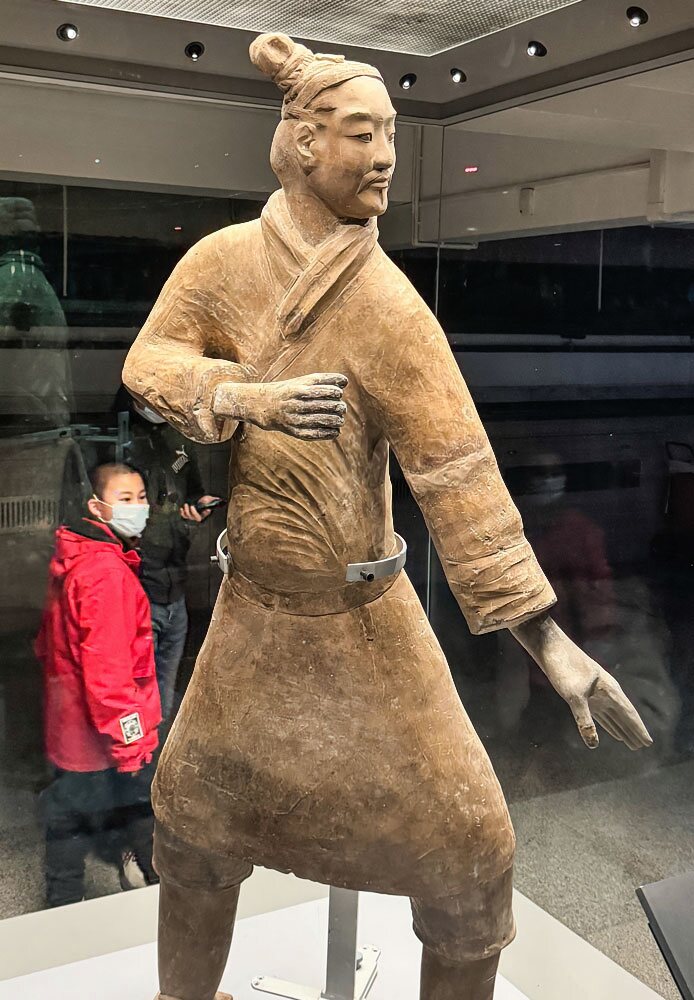
A close-up of his face from the side.
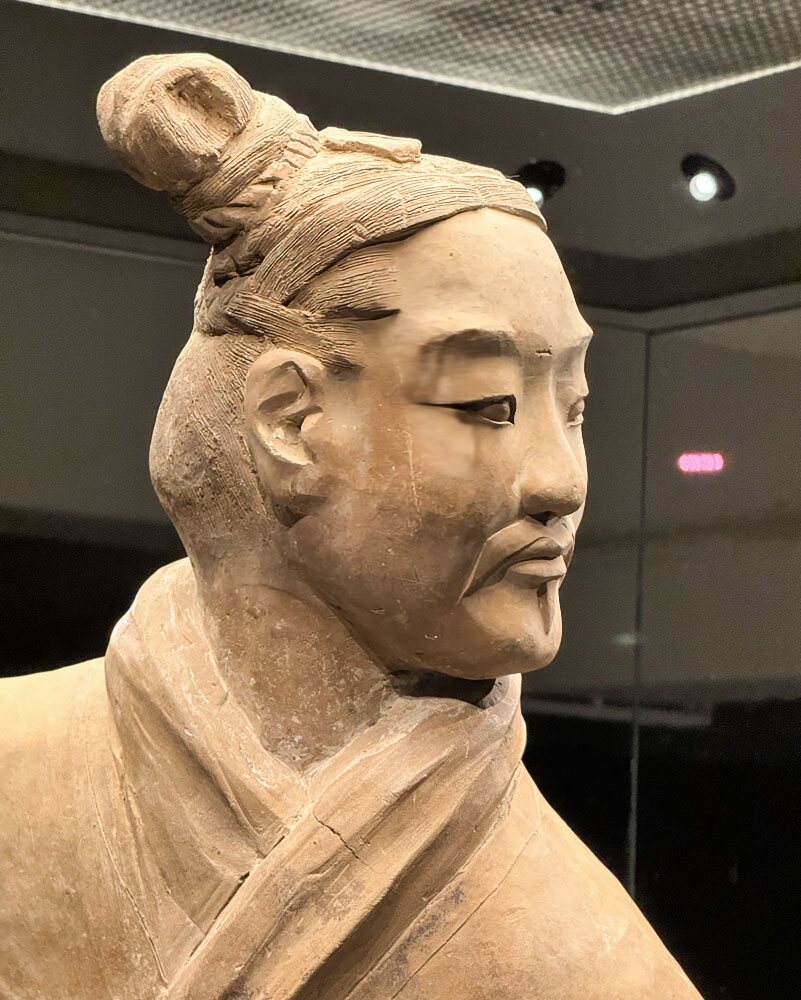
And front on.
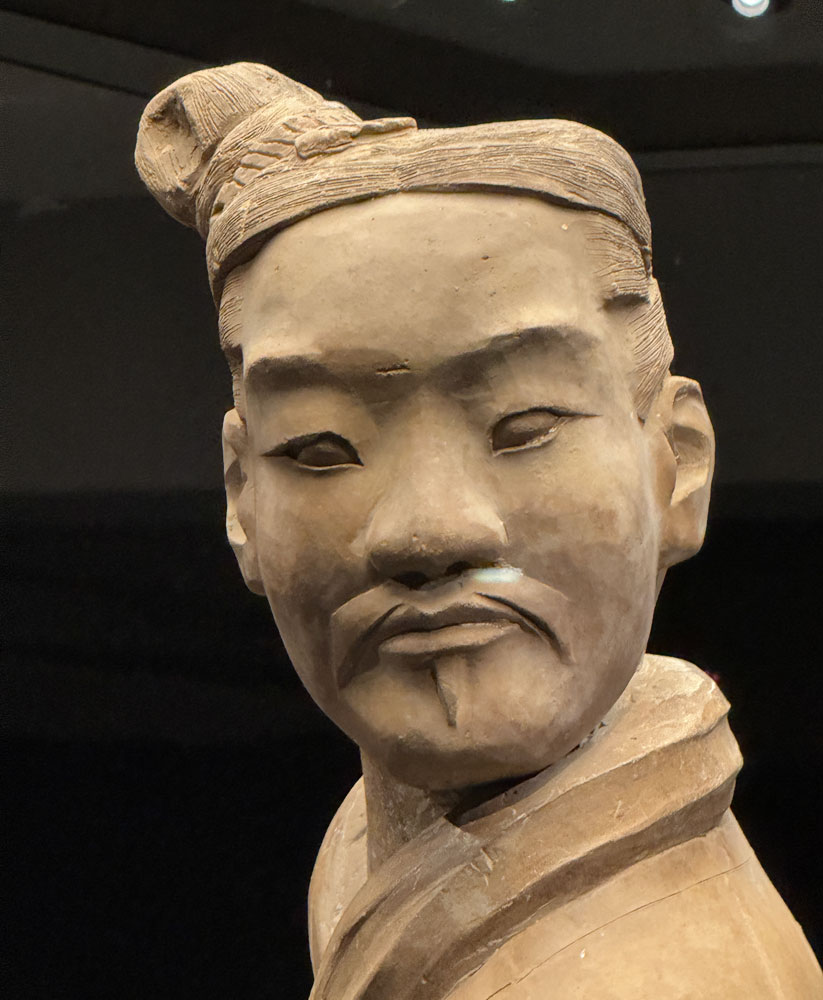
Ending our visit, we went to a store to meet the son of one of the farmers who discovered the warriors. He sits there and greets tourists, and signs some of the books they sell about the warriors. Here's Mark and Janet shaking his hands.
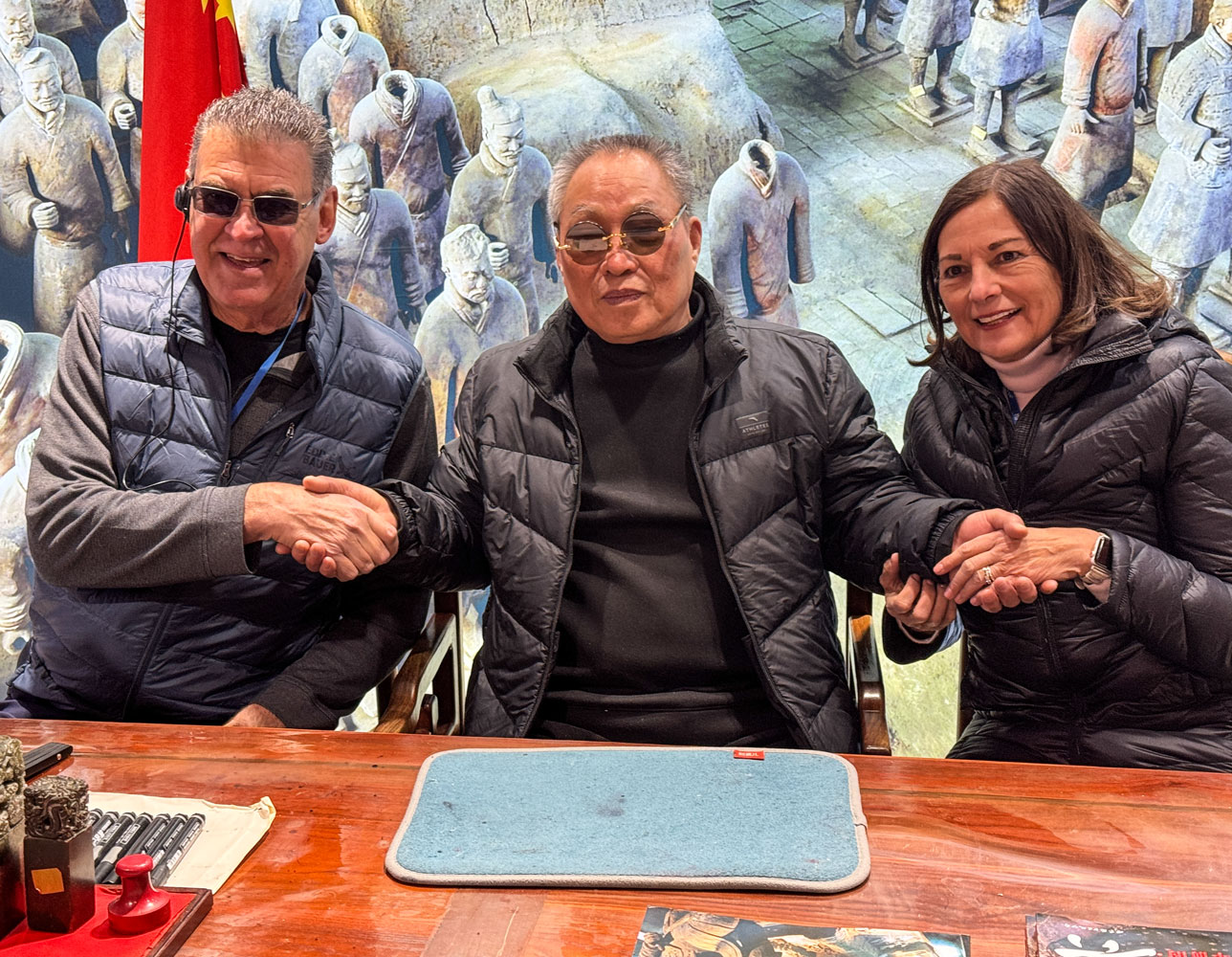
Then we went upstairs to participate in a hands-on tutorial about how the early Chinese made the warriors.
The white "boxes" in front of each of us are molds, and the dark material at the end of the table is clay. We each made a figure with the clay and a mold.
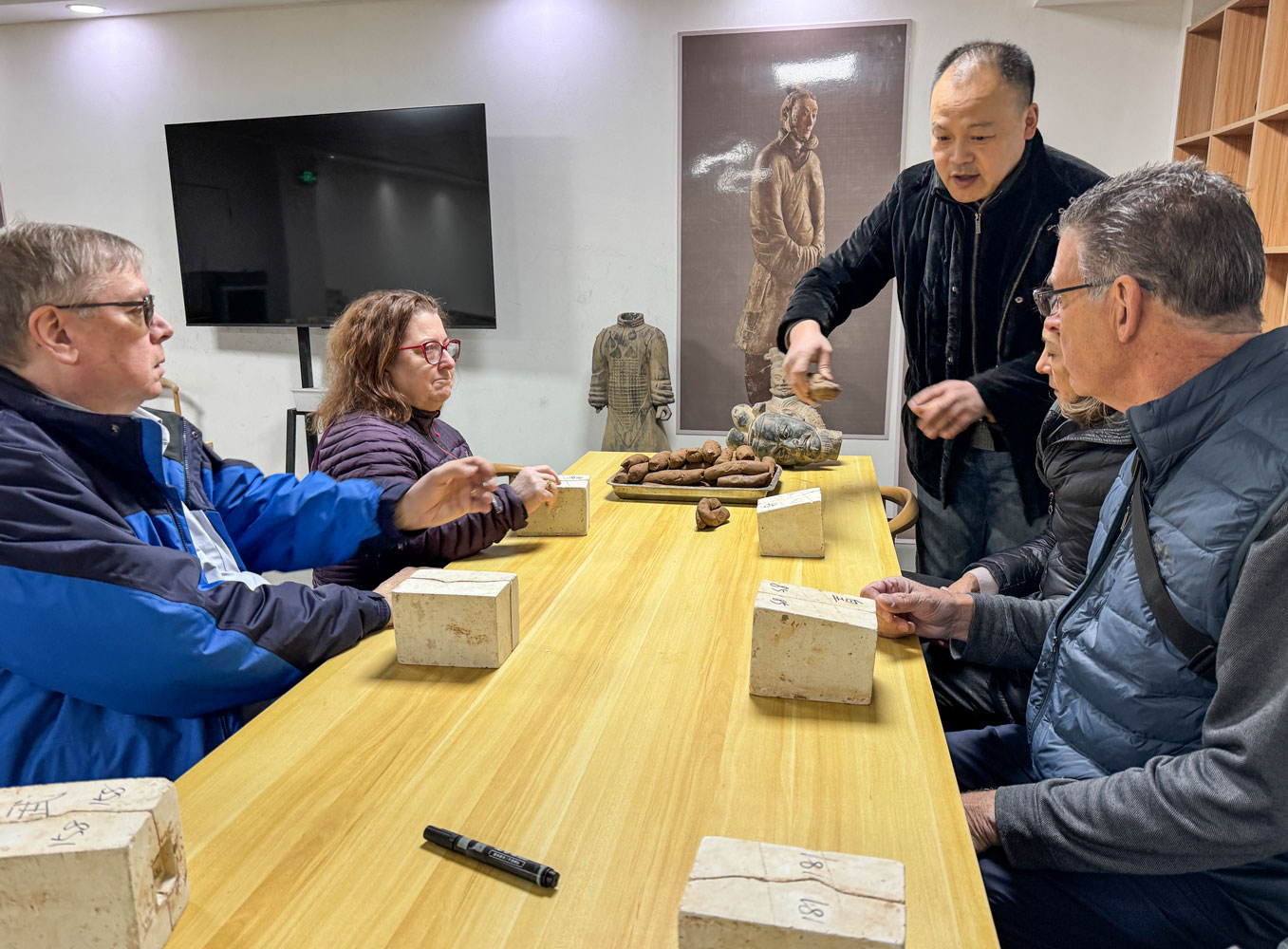
Here are two figures out of two molds, not cleaned up yet.
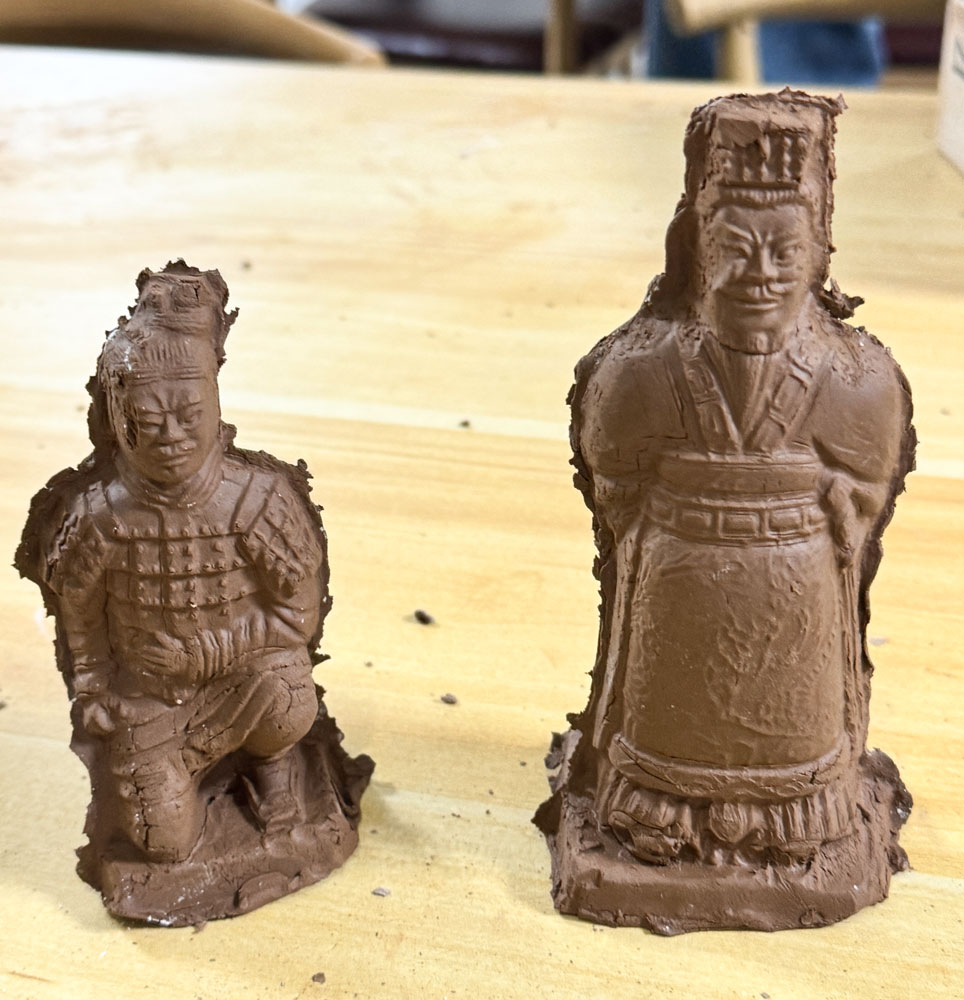
People could take their figurines home, but I left mine. Just don't need any more stuff at home.
We left the store and went to a Chinese restaurant for lunch. It was an excellent lunch featuring various Chinese dishes. I really enjoyed it.
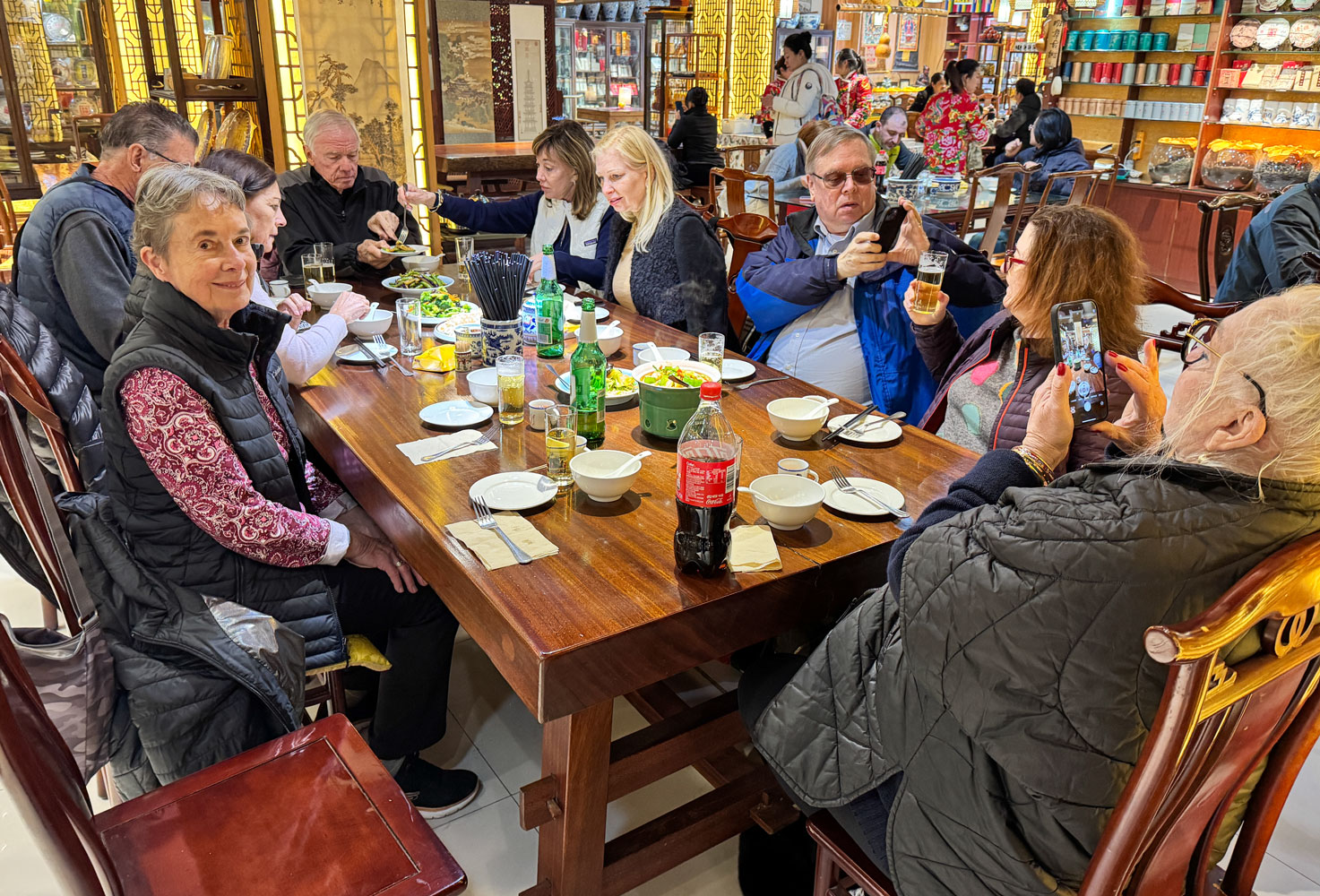
After lunch we went to the Xi'an Museum.

There were a number of young women in traditional dress being photographed there. I was told that it's an expression of their cultural pride (Han culture). I don't know what they do with the photographs - whether the photos are for their own use, or whether they use the photos to get jobs modeling, similar to "head shots" for aspiring actors in Hollywood.
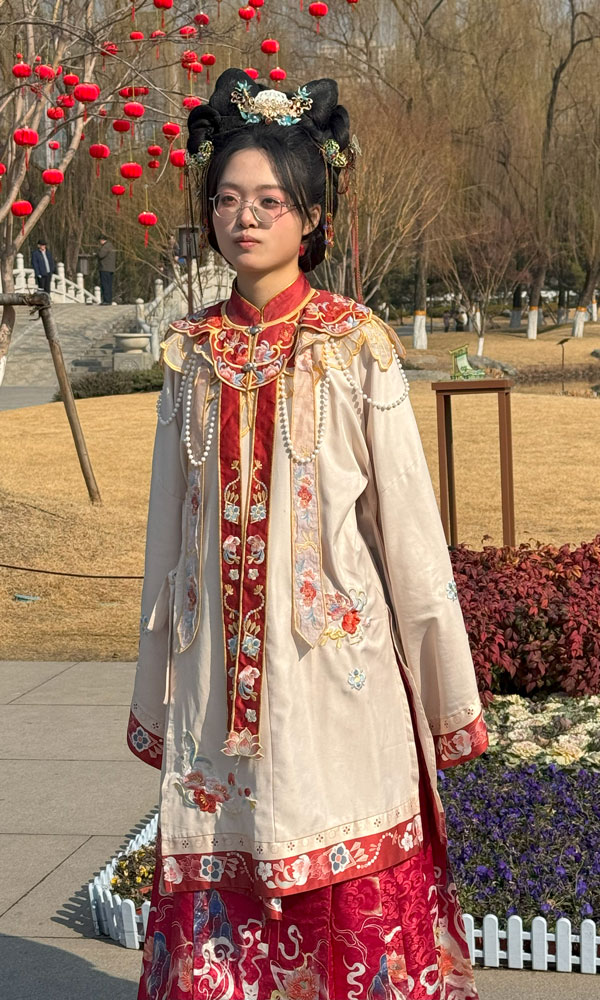
There's a pagoda on the grounds, but its not open to visitors.

The entrance to the museum is a rotunda.
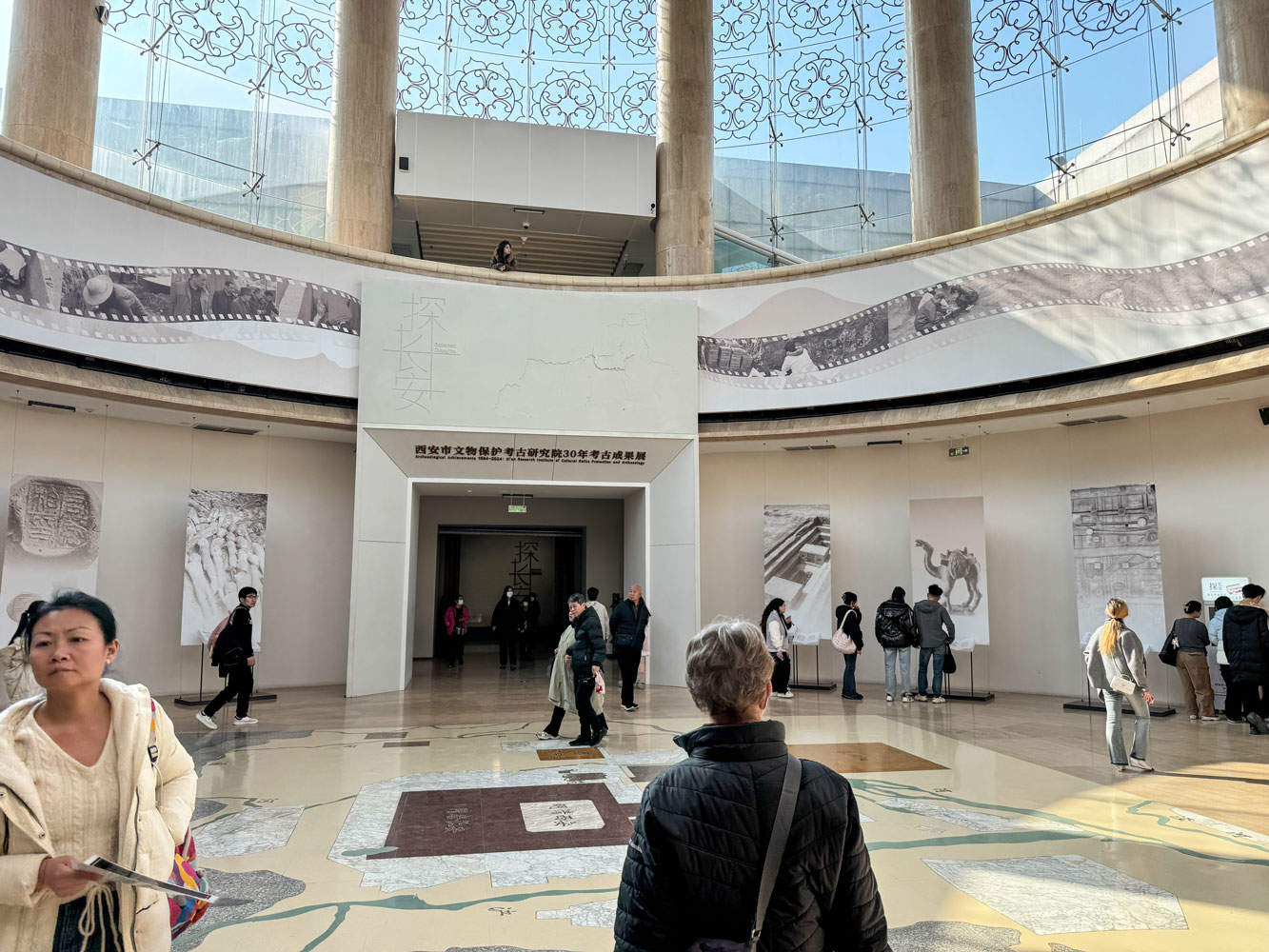
The ceiling.

I'll admit that I didn't have a lot of interest in the museum but I did take a few pictures. Here's a model of an ancient temple.

I joked that this was an ancient dog house.

After we left the museum, Ivy-2 took this picture of us.

Then we left the museum and returned to the hotel. This evening Regent has scheduled dinner at a dinner theater. The show is primarily based on traditional dances.
However, I had too much to eat at lunch and decided not to go. Judy did go, and the following pictures are hers.
They left the hotel about 5:30pm, expecting to arrive at the theater about 6:30 so that they could finish dinner before the show started at 7:30.
But traffic was so bad that they didn't arrive at the theater until just before 7:30. The staff served them dinner as quickly as possible.
The interior is exactly like dinner theatres anywhere, but in an opulent Chinese style.
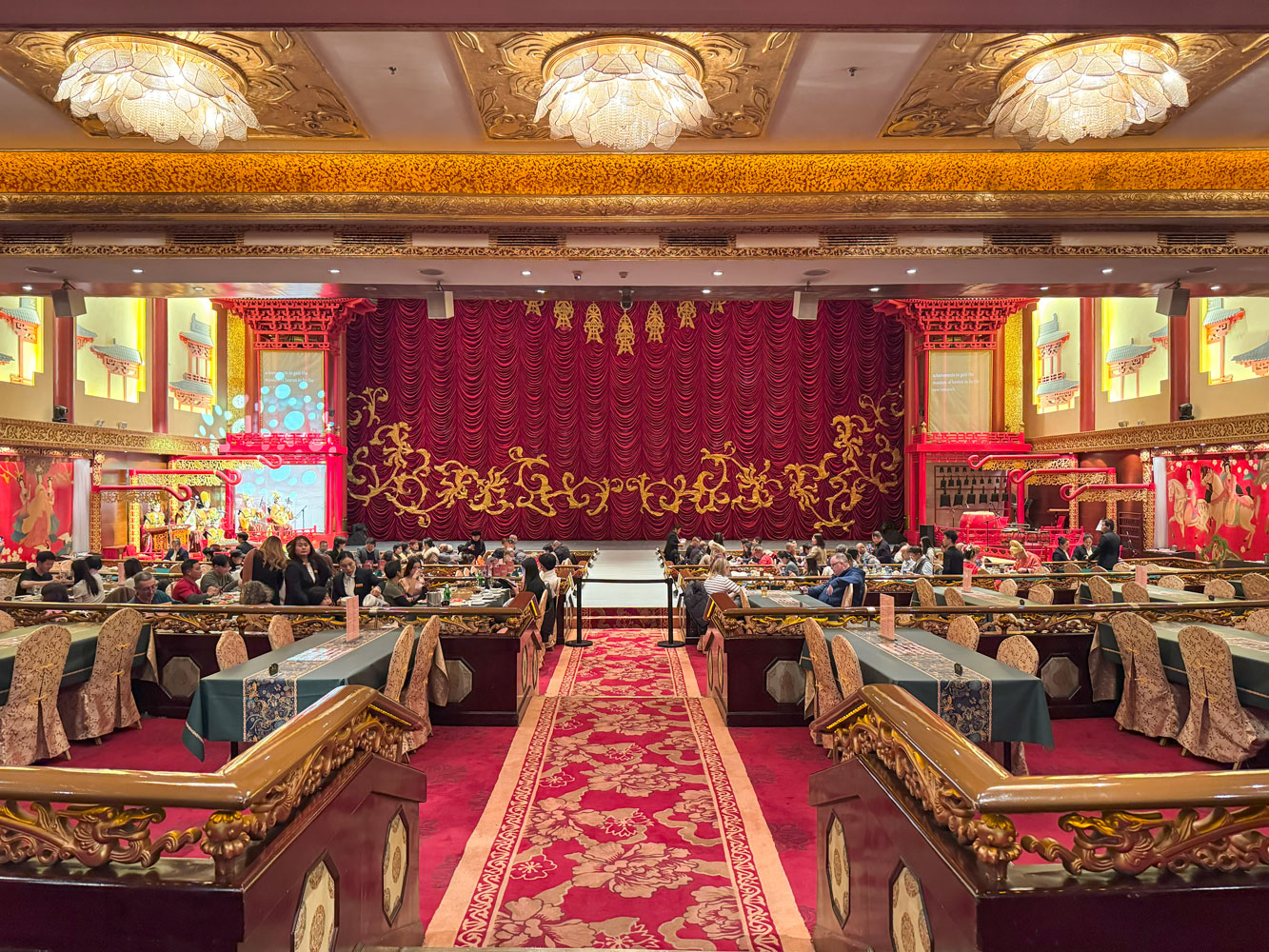
Another view.
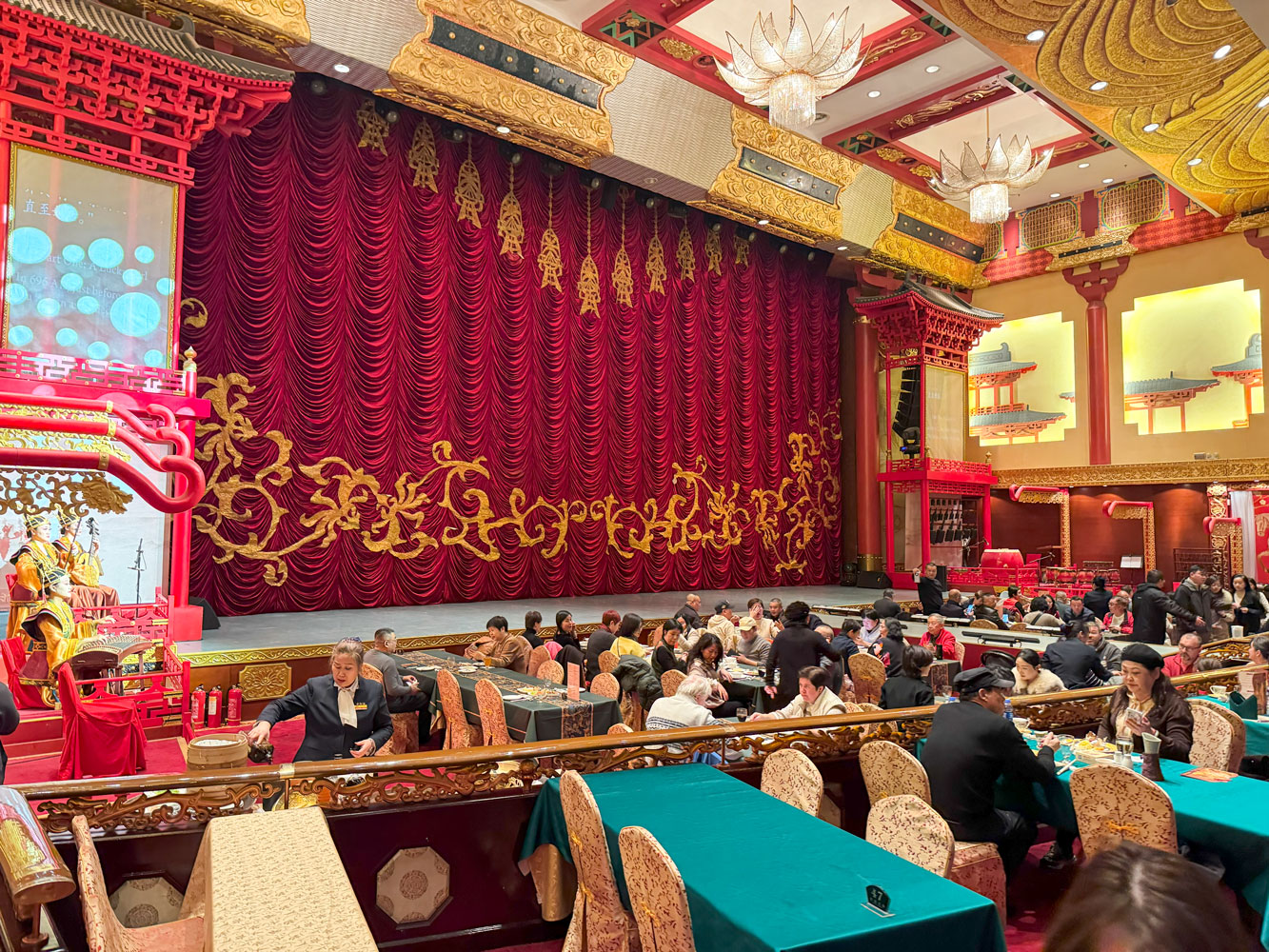
Six of our group at one table, and one couple at another table.
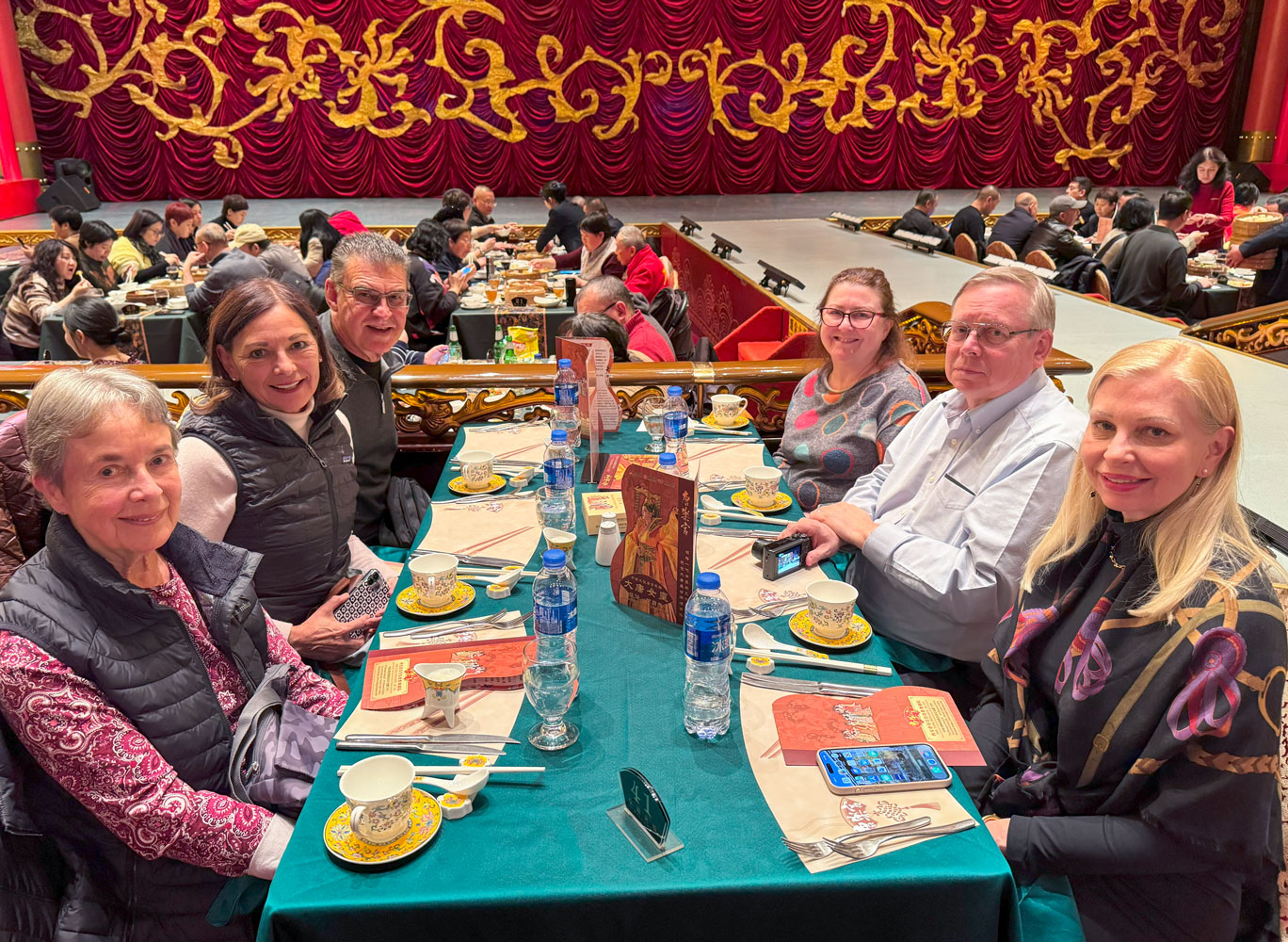
Judy commented that the theater and the production was the equal of a Las Vegas show. It was the story of the only Chinese Empress, in five parts, through dance and elaborate costuming.
A part of the orchestra.

One of the string players.
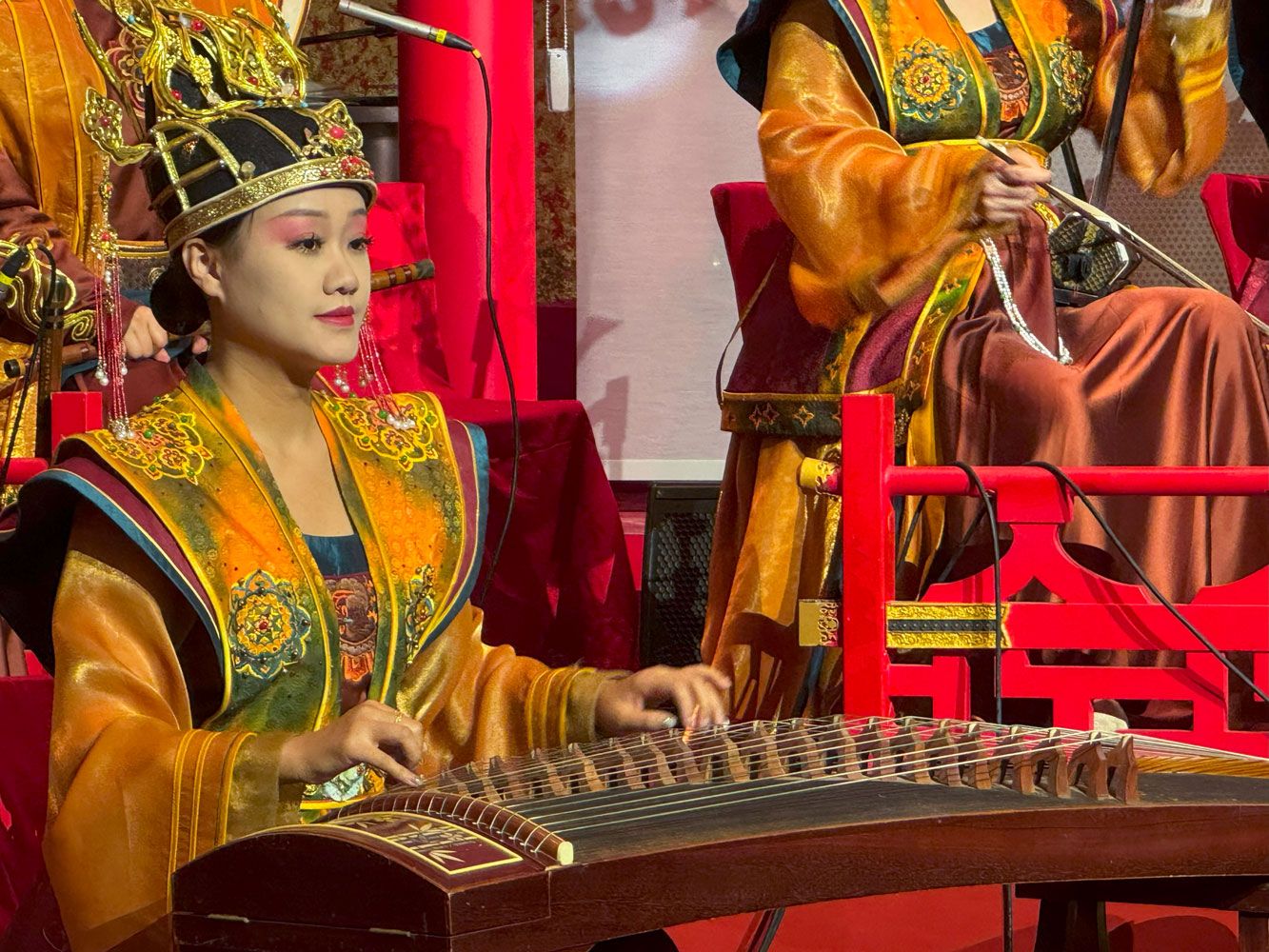
Two more string players.

Drummers.

Some dancers in one of the productions.
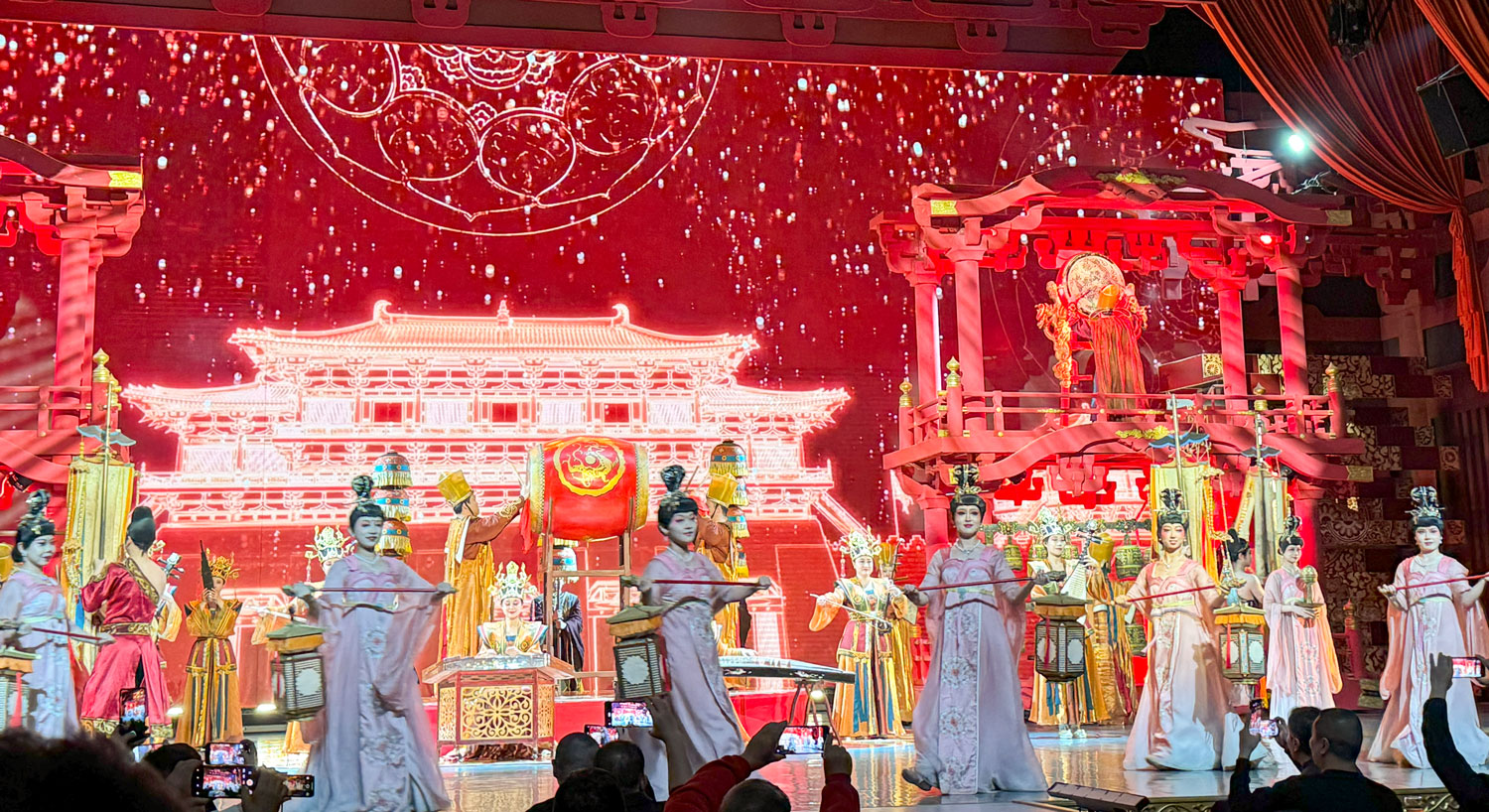
One of the performers.
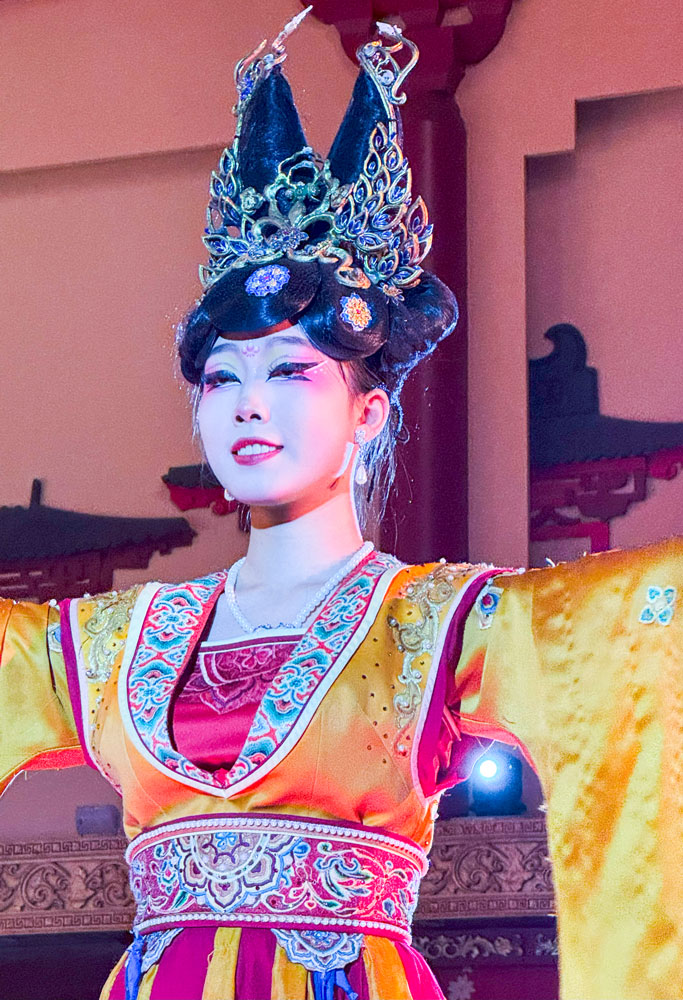
A production number.

Another number.
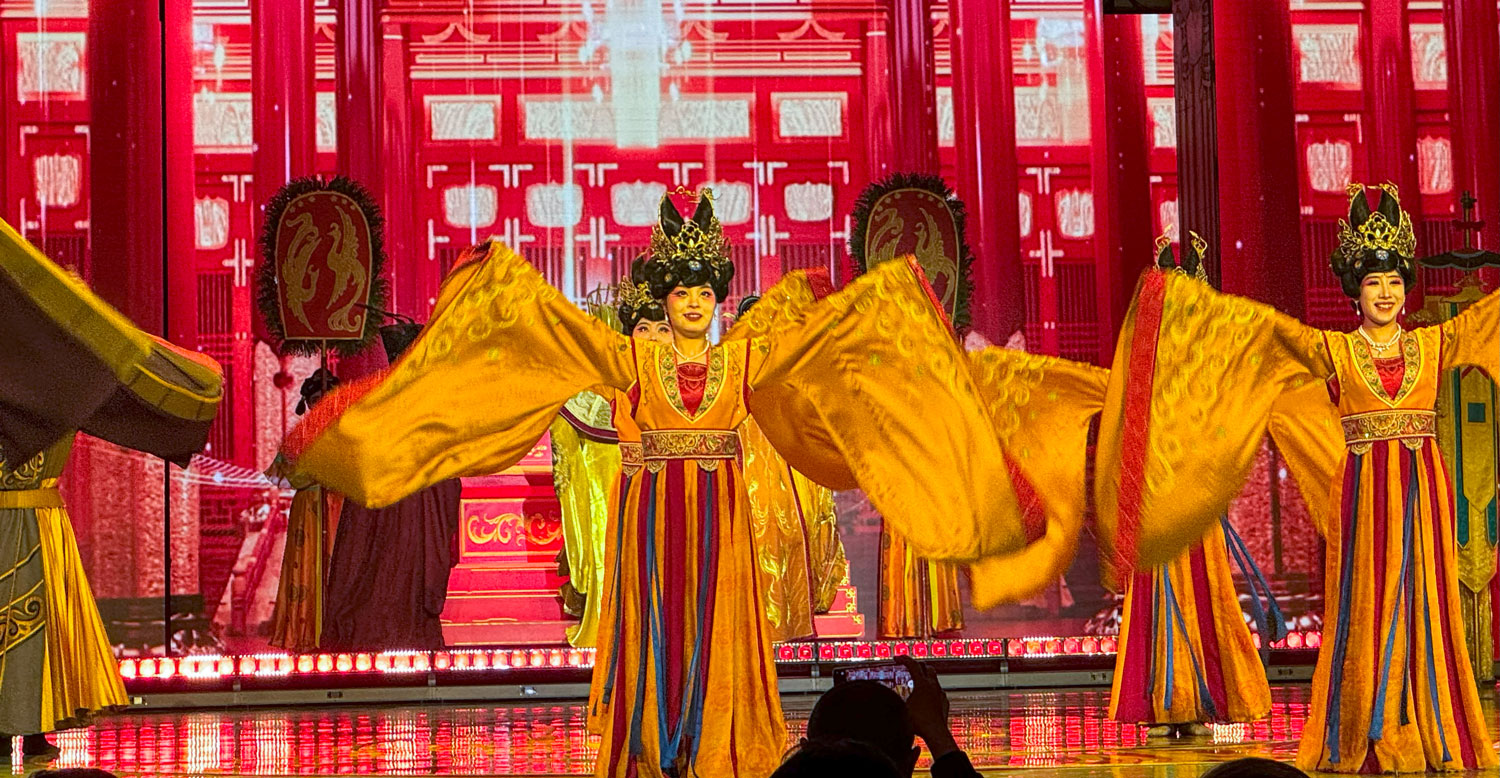
A performer.
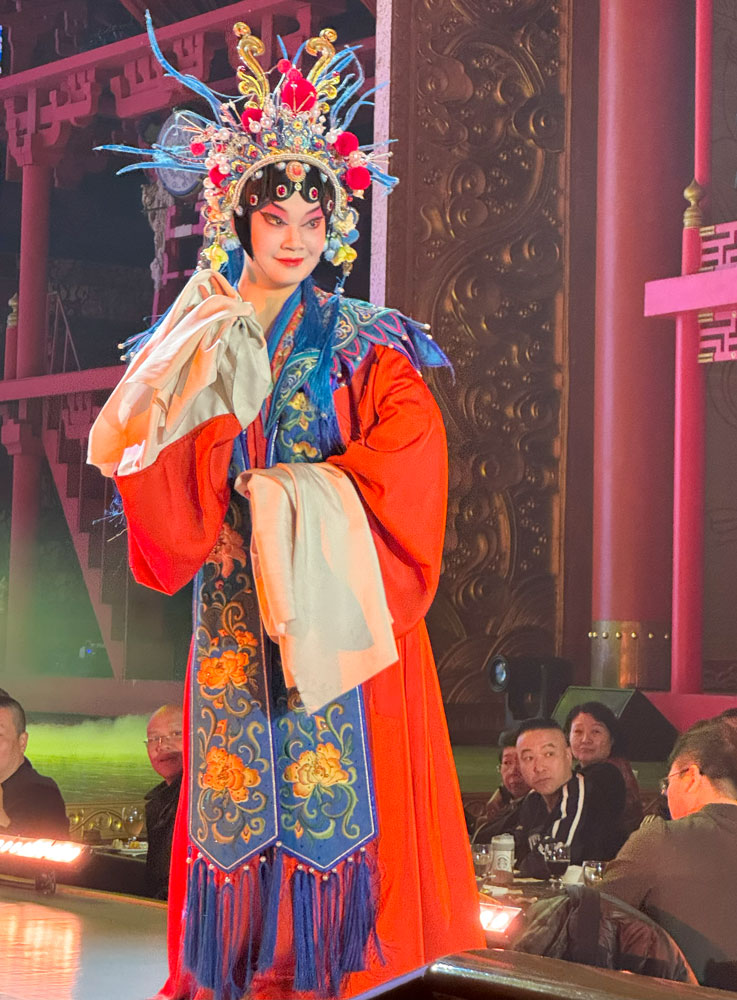
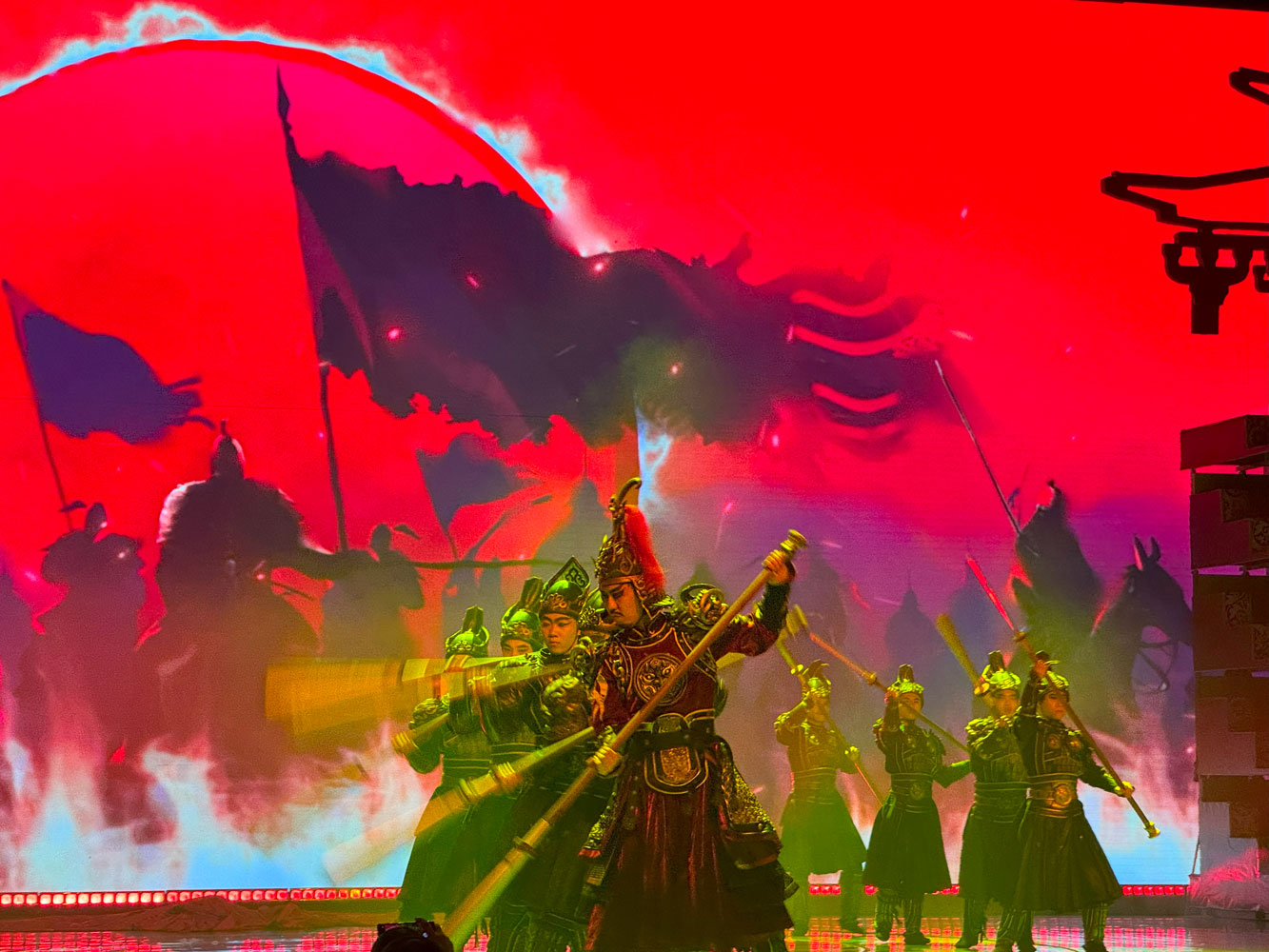
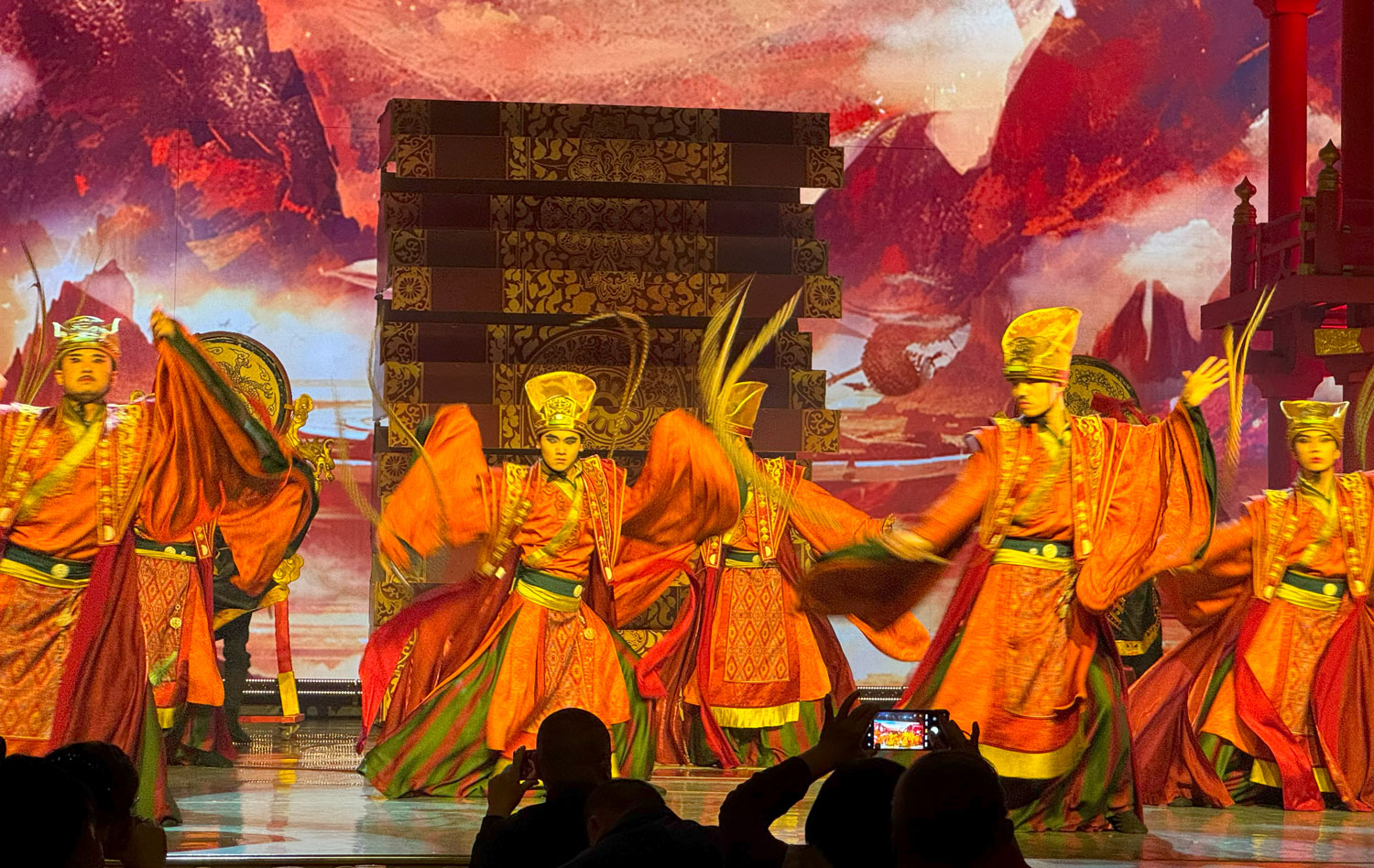


There was a lot more to the show, but I have to limit the number of pictures.
The show ended about 8:30 and the group was back at the hotel about 9:00 pm
I had hoped to include all of our excursion to Xi'an, but this page is getting too long. I'm going to stop here and include our last day in Xi'an on the next page.